Fomente y exalte el razonamiento de los estudiantes aprovechando su curiosidad natural.
Amplify Desmos Math ayuda a los maestros a fomentar un aula con estudiantes entusiastas y cooperativos, partiendo de sus ideas y desarrollando diaria y firmemente los conocimientos del grado académico correspondiente de cada estudiante. For English version, please click here.

Amplify Classroom
Para los grados K a 12.º
Gratuito
Una plataforma de enseñanza y aprendizaje que ofrece una colección de lecciones digitales gratuitas y herramientas para diseñar lecciones.
- Los maestros pueden crear sus propias lecciones con la herramienta Activity Builder.
- También pueden explorar contenido creado por otros maestros, por ejemplo:
- Las lecciones que crean los usuarios y se almacenan en la biblioteca.
- Las lecciones de la Colección destacada que produce el equipo de Amplify Classroom.
Más información en classroom.amplify.com

Amplify Desmos Math
Para los grados K a Álgebra 2
De Pago
Próximamente: Un nuevo programa básico de prekindergarten a 12.º grado de Amplify y Desmos Classroom.
- Un método basado en problemas que produce resultados mediante el desarrollo de una comprensión conceptual sólida, fluidez procedimental y ejemplos de uso.
- Tecnología que inspira conexiones en el aula, fomentando la colaboración, el diálogo y la perseverancia en la resolución de problemas.
- La curiosidad natural de los estudiantes propicia una comprensión cabal de las matemáticas y un aprendizaje que dura toda la vida.
- Disponible en inglés y español.
- Programma piloto para los grados K a A1 para el regreso a clases en el 2024.

Un nuevo programa básico para los grados preK al 12.º de Amplify y Desmos Classroom.
Amplify Desmos Math facilita tanto a los maestros como a los estudiantes la migración a un método basado en el planteamiento y la resolución de problemas, proporcionando actividades atractivas, eficaces herramientas de facilitación para el maestro y muchos apoyos para la diferenciación y la práctica.
Hemos combinado lecciones interactivas basadas en problemas con enseñanzas explícitas, refuerzos y prácticas para que los estudiantes dominen auténticamente las matemáticas. Las lecciones sientan una base sólida en cuanto a la fluidez en los procedimientos y cálculos, afianzan la comprensión de los conceptos y permiten a los estudiantes aplicar lo aprendido a situaciones del mundo real.
Amplify Desmos Math estará disponible a partir del curso escolar 2025–26. Los distritos interesados podrán probar la versión Beta a partir del otoño del 2024.
Más de lo que espera de un programa de matemáticas.
Integral
- Plan de estudios basado en Illustrative Mathematics® IM K-12™
- Diferenciación y práctica personalizadas
- Evaluaciones e informes exhaustivos
- Material didáctico en español


Cooperativo
- Apoyos y herramientas eficaces para la facilitación docente
- Los estudiantes analizan y aprenden de las ideas de los demás
- Cada lección cuenta con materiales impresos y digitales totalmente compatibles con un aula inclusiva
Fascinante
- Lecciones que promueven la curiosidad e inspiran a los estudiantes a resolver problemas del mundo real
- Tecnología de Desmos Classroom que proporciona información instantánea e interactiva para potenciar el razonamiento de los estudiantes
- Vistosas instrucciones gráficas para maestros y estudiantes

Qué incluye
Aprovechamos los alcances tecnológicos y las lecciones de Desmos y añadimos simples pero fascinantes componentes impresos y digitales para crear un programa sin precedentes que simplifica la enseñanza.
- Edición para estudiantes (varios volúmenes)
- Páginas de actividades interactivas para el estudiante
- Interacciones enriquecidas (más información en la página 5)
- Herramientas de colaboración
- Práctica personalizada
- Edición para maestros (varios volúmenes)
- Herramientas de facilitación y seguimiento del progreso
- Páginas de presentación
- Apoyos pedagógicos
- Evaluación
- Prácticas adicionales y material fotocopiable en blanco y negro para evaluaciones
Manténgase al día con las últimas novedades sobre Amplify Desmos Math y Desmos Classroom.
Las lecciones digitales deben potenciar el razonamiento de los estudiantes y generar debates interesantes y productivos. Regístrese para obtener más información sobre cómo Amplify Desmos Math y Desmos Classroom incitan a los estudiantes a interesarse por las matemáticas.
¡El Math Teacher Lounge está disponible!
Amplify presenta Math Teacher Lounge, un podcast con los presentadores Bethany Lockhart Johnson y Dan Meyer.

Introducing Amplify Classroom

Feeling crunched for lesson-planning time? You’re not imagining it. A recent EdSurge report found that teachers get, on average, just 266 minutes of dedicated planning time a week—under an hour a day. And that’s before the meetings, paperwork, and “Got a minute?” queries start rolling in.
When teachers have so little space to craft high-quality interactive lessons, any tool that streamlines planning or teaching can make a huge difference.
Enter Amplify Classroom (formerly Desmos Classroom), launched for the 2025–26 school year and available for free! Already used by more than 300,000 teachers, this all-in-one platform brings together free resources for K–12 students; teacher guides and real-time teaching tools; and interactive lessons across math, literacy, and science—helping educators focus less on logistics and lesson plans and more on student engagement.
Interactive lessons that stick
Amplify Classroom’s free teaching resources go far beyond static worksheets or “entertaining” electronics. The platform’s library of more than 1,000 lessons features a wide range of free K–12 resources, including K–5 activities, middle school science explorations, and high school math challenges. Highlights include:
- A grade 1 math activity called Leaping Lily Pads!, in which students help a purple frog hop toward a golden crown while making connections between subtracting 1 and subtracting 2—and practicing subtracting 2 and adding 2.
- A grade 4 science activity called Food Chains, in which students create their own sequences of organisms, then line up those organisms to model how energy flows through an ecosystem, tracing that energy from start to finish.
- Literacy practice that explores how the letter “y” sounds in words like myth.
- Classic Desmos math challenges, like balancing raccoons on a seesaw against a 21-pound weight.
- Hands-on Polypad manipulatives that let students experiment with tangrams, grids, and colorful geometric shapes.
These types of activities are not just engaging in the moment. They can also set the stage for lifelong math enjoyment. “I’ve been wary about making my kids not hate math,” says kindergarten teacher Martin Joyce. “No ‘drill-n-kill.’ [Now] they’re asking if they can do math on the computer before bed!”
What you can do with these free resources
Once you create a free teacher account, you can:
- Teach more than 1,000 free interactive lessons across math, literacy, and science.
- Customize any premade lesson or build your own with the drag-and-drop editor.
- Monitor student thinking in real time with intuitive dashboards.
- Share snapshots of student work—names optional—to prompt discussion and highlight ideas.
- Control the pacing of lessons, pausing to dive deeper into a concept or syncing everyone to the same spot.
Here’s how it works in practice:
- Find a lesson. Browse by subject, grade level, or topic until you land on one that fits your plan for the day.
- Share it with your class. Assign the activity so students can join from their own devices.
- Teach and adapt in the moment. Use the dashboard to see student thinking in real time, highlight responses, and pace the lesson as you go.
Grade 5 teacher Traci Jackson saw how these K–5 activities boosted collaboration and learning in her class: “After an audible groan when the activity was paused, students made sense of ordered pairs through a purposeful Amplify Classroom experience. One student pair wrote without any prompting!”
More to explore
- Explore Amplify Classroom, the free platform for grades K–12.
- Learn how Amplify Classroom is supporting teachers across math, literacy, and science.
- Find free professional learning resources for educators and free activities for students in our Problem-Based Learning Starter Pack.
A curiosity-driven K–8 science curriculum
Amplify Science is a K–8 phenomena-based science curriculum that blends hands-on investigations, literacy-rich activities, and interactive digital tools. The result? Elementary and middle school students who think, read, write, and argue like real scientists.
Amplify Science for grades K–8 has been rated all green by EdReports.
Our approach
Each unit of Amplify Science engages all learners in a relevant, real-world problem where they assume the role of a scientist to investigate scientific phenomena, engage in collaboration and discussion, and develop models or explanations to arrive at solutions.
A research-backed approach to 3D learning
The research-based Do, Talk, Read, Write, Visualize instructional approach—developed by UC Berkeley’s Lawrence Hall of Science—provides students with multiple opportunities and modalities with which to access science instruction. Independent research proves that this model of learning benefits all learners, and our efficacy research shows improved student achievement.
Students take on roles of scientists and engineers.
In each unit, students take on the role of a scientist or engineer to investigate a realistic problem. These problems provide relevant contexts through which students investigate real-world phenomena that are seamlessly integrated throughout the unit. By positioning students as engineers or scientists, they are actively engaged in designing innovative solutions and making sense of the world around them.


Authentic 3D learning brought to life
Amplify Science integrates the NGSS—and state standards based on them—not just at a surface level, but throughout every lesson of the unit. Students engage with science and engineering practices, figure out disciplinary core ideas, and make connections when they apply Crosscutting Concepts across thoughtfully structured, multimodal lessons.
Developed by science education experts
Amplify Science was developed by The Lawrence Hall of Science at UC Berkeley in partnership with Amplify. It reflects state-of-the-art practices in science teaching and learning.

A flexible, blended program
Amplify Science includes hands-on activities, print materials, and powerful digital tools to support online and offline teaching and learning. Highly adaptable and user-friendly, the program gives schools and individual teachers flexibility based on their technology resources and preferences.
What’s included
Our flexible resources work seamlessly together.

Teacher’s Guides
Available digitally and in print, the Teacher’s Guides contain all of the information teachers need to facilitate classroom instruction, including:
- Detailed lesson plans.
- Unit and chapter overview documentation.
- Differentiation strategies.
- Standards alignments.
- In-context professional development.

Student Investigation Notebooks
Available for every unit, the Student Investigation Notebooks provide space for students to:
- Record data.
- Reflect on ideas from texts and investigations.
- Construct explanations and arguments.

Student Books
Age-appropriate Student Books allow students to:
- Engage with content-rich texts.
- Obtain evidence.
- Develop research and close-reading skills.
- Construct arguments and explanations.

Simulations and Modeling Tools
Developed exclusively for the Amplify Science program, these engaging digital tools:
- Serve as venues for exploration.
- Enable data collection.
- Allow students to explore scientific concepts.
- Show what might be impossible to see with the naked eye.

Hands-on materials kits
Hands-on learning is at the heart of Amplify Science. Each unit kit contains:
- Consumable and non-consumable hands-on materials.
- Print classroom display materials.
- Premium print materials for student use (sorting cards, maps, etc.).

Teacher’s Guides
Available digitally and in print, the Teacher’s Guides contain all of the information teachers need to facilitate classroom instruction, including:
- Detailed lesson plans.
- Unit and chapter overview documentation.
- Differentiation strategies.
- Standards alignments.
- In-context professional development.

Student Investigation Notebooks
Available for every unit, the Student Investigation Notebooks provide space for students to:
- Record data.
- Reflect on ideas from texts and investigations.
- Construct explanations and arguments.
Available with full-color article compilations for middle school units

Hands-on materials kits
Hands-on learning is at the heart of Amplify Science. Each unit kit contains:
- Consumable and non-consumable hands-on materials.
- Print classroom display materials.
- Premium print materials for student use (sorting cards, maps, etc.).

Digital student experience
Students access the digital simulations and Modeling Tools, as well as lesson activities and assessments, through the digital student experience. Students can interact with the digital student experience as they:
- Conduct hands-on investigations.
- Engage in active reading and writing activities.
- Participate in discussions.
- Record observations.
- Craft end-of-unit scientific arguments.

Science articles
The middle school science articles serve as sources for evidence collection and were authored by science and literacy experts at the Lawrence Hall of Science.

Explore more programs.
Our programs are designed to support and complement one another. Learn more about our related programs.
Lorem Ipsum
Lorem Ipsum
Lorem ipsum is placeholder text commonly used in the graphic, print, and publishing industries for previewing layouts and visual mockups. Lorem ipsum is placeholder text commonly used in the graphic, print, and publishing industries for previewing layouts and visual mockups.
Lorem ipsum is placeholder text commonly used in the graphic, print, and publishing industries for previewing layouts and visual mockups.

Update
Update 2
Lorem ipsum is placeholder text commonly used in the graphic, print, and publishing industries for previewing layouts and visual mockups. Lorem ipsum is placeholder text commonly used in the graphic, print, and publishing industries for previewing layouts and visual mockups.
Lorem ipsum is placeholder text commonly used in the graphic, print, and publishing industries for previewing layouts and visual mockups.
Lorem ipsum is placeholder text commonly used in the graphic, print, and publishing industries for previewing layouts and visual mockups. Lorem ipsum is placeholder text commonly used in the graphic, print, and publishing industries for previewing layouts and visual mockups.
Lorem ipsum is placeholder text commonly used in the graphic, print, and publishing industries for previewing layouts and visual mockups.
Image and text

Lorem ipsum is placeholder text commonly used in the graphic, print, and publishing industries for previewing layouts and visual mockups. Lorem ipsum is placeholder text commonly used in the graphic, print, and publishing industries for previewing layouts and visual mockups.
Lorem ipsum is placeholder text commonly used in the graphic, print, and publishing industries for previewing layouts and visual mockups.
Table
| Lorem Ipsum | Lorem Ipsum | Lorem Ipsum |
|---|---|---|
| Lorem ipsum is placeholder text commonly used in the graphic, print, and publishing industries for previewing layouts and visual mockups. | Lorem ipsum is placeholder text commonly used in the graphic, print, and publishing industries for previewing layouts and visual mockups. | Lorem ipsum is placeholder text commonly used in the graphic, print, and publishing industries for previewing layouts and visual mockups. |
| Lorem ipsum is placeholder text commonly used in the graphic, print, and publishing industries for previewing layouts and visual mockups. | Lorem ipsum is placeholder text commonly used in the graphic, print, and publishing industries for previewing layouts and visual mockups. | Lorem ipsum is placeholder text commonly used in the graphic, print, and publishing industries for previewing layouts and visual mockups. |
| Lorem ipsum is placeholder text commonly used in the graphic, print, and publishing industries for previewing layouts and visual mockups. | Lorem ipsum is placeholder text commonly used in the graphic, print, and publishing industries for previewing layouts and visual mockups. | Lorem ipsum is placeholder text commonly used in the graphic, print, and publishing industries for previewing layouts and visual mockups. |
| Lorem Ipsum | Lorem Ipsum | Lorem Ipsum |
Lists
Accordion
- One
- Two
- One
- Two
- One
- Two
- One
- Two
- One
- Two
- One
- Two
- One
- Two
- One
- Two
- One
- Two
- One
- Two
Quote
Lorem ipsum is placeholder text commonly used in the graphic, print, and publishing industries for previewing layouts and visual mockups.
George Washington
Lorem ipsum is placeholder text commonly used in the graphic, print, and publishing industries for previewing layouts and visual mockups.
George Washington
Callout
Callout title
Lorem ipsum is placeholder text commonly used in the graphic, print, and publishing industries for previewing layouts and visual mockups.
Columns
Lorem ipsum is placeholder text commonly used in the graphic, print, and publishing industries for previewing layouts and visual mockups.

Contact
Lorem ipsum is placeholder text commonly used in the graphic, print, and publishing industries for previewing layouts and visual mockups. Lorem ipsum is placeholder text commonly used in the graphic, print, and publishing industries for previewing layouts and visual mockups.
Free professional learning to support your Science of Reading journey
We know you seek the best research-tested methods for your students—and want to start applying them as quickly and easily as possible. Whether you’re looking to improve your students’ writing or understand how to boost their comprehension, here are a few resources designed to save precious time!


Science of Reading: The Podcast Essentials episodes
Looking for a roundup of the latest research on key topics? Look no further! Our Science of Reading Essentials episodes can unlock insights that can truly transform your instruction. Each episode is just over 30 minutes. You can also download our discussion guides to fuel your own professional learning sessions.
 |
 |
 |
 |
Explore the Science of Writing
Discover the captivating journey of writing with our new guide, Science of Writing: A Primer. Explore the history of writing to understand the crucial link between reading and writing instruction—and why handwriting still matters in today’s digital world.


A year’s professional learning from Science of Reading: The Podcast
Looking for ways to bring Science of Reading: The Podcast into your professional learning communities? Here’s one starting place: Share a presentation of top takeaways to jump-start your discussions.
Science of Reading professional development on your own schedule
Science of Reading: Learning Lab offers unparalleled research-backed instruction crafted to the standards of the International Dyslexia Association. Explore enriching activities, curated resources, and guidance from Susan Lambert, Chief Academic Officer of Literacy and Host of Science of Reading: The Podcast.

K–5 Core Knowledge Language Arts Program – K–5 Literacy Curriculum | Amplify
Supporting multilingual learners—by supporting their families

Teachers know that multilingual/English learners (ML/ELs) are an important and fast-growing population in today’s classrooms. In 2021, more than 10% of students enrolled in public schools across the U.S. were identified as English language learners, with some projections suggesting this number could reach 40% by 2030.
But when it comes to partnering with the families of ML/ELs for student success, we’re just beginning to tap into what’s possible.
I’m an ML/EL teacher and former homeroom teacher at a school serving many ML/ELs.
Here’s what I’ve learned about best practices for bridging the school-to-home communication gap and partnering with families (all families!) to ensure their child’s success.
Recognizing the communication gap: Common challenges with multilingual families
In my experience, three common barriers can stand in the way of strong family engagement and student success:
- Cultural expectations around parent-teacher communication: In many cultures, school is considered the teacher’s domain. Reaching out may be seen as crossing a line—or simply not expected at all.
- Logistical challenges: Unpredictable schedules may lead to missed messages, delayed responses, or inconsistent availability.
- Language barriers: If a message isn’t in a language a caregiver understands, it’s unlikely they’ll respond—not because they don’t care, but because they can’t fully engage.
Supporting multilingual learners starts with recognizing these barriers not as signs of disconnection, but as invitations to shift our approach. There are best practices we can adopt to help bridge the gap—and build the trust and relationships our students need to thrive.
Tools and strategies for better parent-teacher communication
If you want to communicate with families who speak a variety of different languages, the first step is finding the method of contact that works best for each of them. My school uses an auto-translating app called ParentSquare for home communications—but not all families I’ve worked with respond to ParentSquare messages. So if a family isn’t responsive to one mode of communication, try another!
It’s a good idea to ask families on Back-to-School Night—or whenever your students first arrive—if they have a preferred mode of communication. I’ve found I get the best response rate by creating a Google Voice number and communicating via text, first translating through an app if needed.
Keep a log of this information so you have it on hand when you need it. In the long run, this will be easier for both you and your students’ caregivers than you chasing them down to get them to download, log into, or check a specific app.
The important thing is to consider making contact essential, and to keep trying until you find the mode that works for both you and the parents of your ML/EL students.
Setting the tone for strong family engagement
If you want to forge a strong family-school partnership (and you should!), you also need to set the tone. When families have a different cultural understanding of school engagement than what you’re used to, I’ve found that it helps to explicitly solicit parent input, explaining how a partnership between caregiver and teacher will help support their child’s success.
Let them know how and why they should get in touch with you, and make it easy by reaching out proactively with brief, positive updates.
What multilingual families really want to know
Perhaps most importantly, ask families what they want to know! I’ve attended many parent-teacher conferences—both for my own students and as an interpreter—and I’m frequently struck by how many multilingual families respond when I ask what questions they have. Many families who haven’t previously reached out are suddenly overflowing with questions.
The most common one I get is how they can support their child’s academic journey at home. Parents also frequently request updates about behavior. Understand that just because a family isn’t asking these questions proactively doesn’t mean they don’t care. When I explicitly ask parents what they need, their responses make it abundantly clear that they are deeply invested in their child’s schooling and success.
I’ve also learned that many families—especially those who speak a language other than English at home—may not know that there are many ways to support their child’s growth, even if classroom instruction is not in their home language.
Think about what tips and resources you can most easily provide: Do your students’ parents know that reading or reciting poems, songs, or chants in their home language helps literacy growth? Could you send home simple board games from the classroom to reinforce key skills? Would signing up for a library card give them access to resources they didn’t know were available? Many caregivers of ML/EL students have told me they lack the tools to get involved—but are eager to engage once given tangible strategies.
How teachers can go the extra mile
In order to give our students and their families the support they need, it’s critical that we challenge our internal biases and assumptions. If we assume parents are uninterested or uninvolved, we avoid an opportunity to think creatively about how to bridge communication gaps and facilitate family involvement. We also cut off a world of possibility for our students and limit their access to the academic success that comes from parent involvement.
Working with the families of ML/ELs may bring added responsibilities—but it’s also a unique privilege, full of new opportunities. In teaching ML/ELs, I’ve found that I get to be a cultural bridge—one of the people providing warmth, stability, and welcome to families navigating a new culture. School can be overwhelming in a new country or different language—but a teacher who goes the extra mile can ensure success for both students and families.
Additional resources
- Let’s keep the conversation going! Join the discussion in our Amplify learning communities.
- Discover a suite of Spanish literacy curriculum and assessment programs designed to build confident readers with Amplify’s biliteracy suite.
- Read how you can use the Science of Reading to boost your biliteracy instruction in this blog post.
How asset-based assessments can revolutionize math instruction

Many of today’s math classrooms are facing a perfect storm: declining scores, widening learning gaps, and growing pressure on teachers to deliver solutions. According to the National Assessment of Educational Progress, students are experiencing the steepest drop in math scores since 1990. EdWeek Research Center reports that a persistent gap between educational theory and day-to-day practice is putting added stress on teachers, often leaving them to navigate complex pedagogical demands without adequate support.
So how can we provide both students and teachers with the tools they need to succeed? How can math assessments and math intervention programs provide real help and drive student progress—without piling on more work?
One promising answer lies in rethinking how we assess what students know.
Rethinking the role of math assessments
Traditional assessments tend to focus on correctness alone. Did the student get it right or wrong? How many points did they earn?
But this binary approach misses a lot. A skipped question could mean a tech hiccup or a moment of confusion—not a lack of understanding. A wrong answer might come at the end of otherwise solid problem-solving.
An asset-based assessment approach shifts the focus from mistakes to meaning. It looks beyond outcomes to understanding how students think—their strategies, reasoning, and partial understandings. And when teachers can see that thinking, they gain far more useful data to guide instruction and inform their math intervention program.
This approach doesn’t lower expectations—it raises the quality of insight and gives struggling students (and really all students) a better shot at meeting standards with instruction that’s tailored to their actual needs.
Honoring students’ thinking and teachers’ time
Every student thinks differently. Asset-based assessments help reveal individual thinking, often through short-answer or open-response formats that ask students to explain how they solved a problem.
But this shift isn’t just for students. Teachers can benefit enormously when assessments are designed to surface trends in student thinking. If 30% of a class misinterprets the same concept, that result reveals a teaching opportunity. Rather than reteach an entire unit, teachers can adjust with focused, targeted support. That means less time spent diagnosing, and more time actually helping.
And when technology in the math classroom makes this data easy to collect, analyze, and act on, teachers get a level of consistent insight that is not only helpful, but actionable.
From student performance to student performance + thinking
The ultimate goal of asset-based assessments isn’t to replace performance data—it’s to enhance it. Knowing how a student got to an answer (or why they didn’t) can make all the difference in determining what to do next.
Here’s an example involving a division problem:

When real students were given this problem, they responded with answers like:
- 33/4 = 8.25, round up to 9 so all kids can sit!
- 33/4 = 8 with a remainder of 1. She needs 8 tables.
- 8 x 4 = 32, but 9 x 4 = 36. I don’t know if we can leave one student sitting lonely on the floor, though.
Traditional grading might stop at “correct” or “incorrect” for these responses. But when students are asked to explain their thinking, teachers can uncover a range of reasoning—from successful multiplication strategies to misunderstandings about remainders.
These glimpses into student thinking aren’t just informative—they’re transformative. They can illuminate the performance of students in a deeper, more actionable way. They can help teachers take smarter next steps, and they can help students feel understood, capable, and more like “math people” every day.
More to explore
- Download our ebook Asset-Based Assessment: What It Is and Why It’s Needed in K–12 Classrooms.
- Amplify is investing in assessment and intervention tools that make this kind of insight possible. Our latest suite was designed with asset-based thinking at its core. You can learn more here:
How differentiation drives success

I’d like to share a favorite success story from my ELA class that brings home the true power of differentiation.
There was one boy—let’s call him Dipper. (It’s not his real name; I just really like the show “Gravity Falls.”) Dipper was the sweetest, kindest, most wholesome eighth grader I have ever met. He was absolutely precious.
Dipper also suffered from fairly severe academic struggles. He was well below his middle school reading level, struggled to express ideas in writing, and took longer than other students to break down basic concepts. When Dipper first came to me, he couldn’t start or complete a written sentence. He was easily frustrated and often overwhelmed to the point of tears.
Spoiler: By the end of the school year, Dipper was writing multiple paragraphs and starting to connect them with transition sentences.
Here’s how he got that much closer to grade level.
Using sentence starters and scaffolds to build success
My school district had recently adopted Amplify ELA (6–8). At the outset, I placed Dipper at the differentiation level with the most support. When we talked about how a character reacted to a moment in the story, Dipper had corresponding smiley, frowny, and disgusted faces to identify feelings. He had his own lesson plan with example quotes, shortened readings, alternative questions to spark thinking, and sentence starters to help him focus on comprehension instead of getting stuck at the start.
All of these supports helped him comprehend, share his responses, and contribute to discussions.
So far, so good.
But putting those thoughts to paper—or text box—was a completely different hurdle.
Facing academic struggles with patience and persistence
I can’t talk about Dipper without talking about his one-to-one aide. Let’s call her Ms. Mabel. (Again, “Gravity Falls.” I’m telling you, check it out.)
Ms. Mabel had sat beside Dipper during every ELA class since sixth grade. She helped him stay focused and generate ideas, and she even transcribed his answers when needed. Ms. Mabel’s devotion to Dipper’s success was profound and inspirational.
And it made all the difference when it came to Writing Prompts. At first, the prompts were met with tears and tantrums, panic and disdain, all the joyful wholesomeness ripped from Dipper.
Ms. Mabel would console him and redirect his passions to the work. She would point out the sentence starters, help him copy and paste them to the text box, and have him fill in the blanks. Again and again.
And then, little by little: Less panic. Fewer tears. Sentence starters, fill in the blank. Progress.
Sentence starters, fill in the blank. Success.
Day by day, Dipper, stacking wins like pancakes at an all-you-can-eat breakfast buffet, found confidence in himself, his reading, and his writing. He went from barely being able to complete a sentence to writing multiple paragraphs with evidence to support his ideas.
We had seen Dipper grow from a tiny sixth grader into a less tiny eighth grader and had watched his initial tenacity meet with stagnation, frustration, and defeat—until this year. This year with Amplify was different.
Why it takes more than just an awesome teacher
Obviously, you can’t pin success on one factor. Dipper had many supports in place: two blocks in the resource room, a dedicated aide, supportive peers and family, and—above all—a fierce drive and work ethic.
But if you asked Ms. Mabel, she would tell you that Amplify helped, too. She found that the way the questions were broken down allowed her to teach Dipper what he misunderstood better than she had been able to in previous years. We discovered very quickly how much autonomy was built in. It wasn’t rigid. It gave us structure and trust. It made differentiation easier, clearer, and more meaningful.
Sure, maybe Dipper was also maturing. Maybe I’m just an awesome teacher. Or maybe, just maybe, we need every little bit of help we can get to do the hard work in life. Maybe we need someone to push us in the right direction. Maybe we need those guardrails to keep us on course. Some of us can start our own engines, but we all need to be able to race.
Sometimes, we need someone who can help us start our sentences so we can learn how to be the ones to finish them.
More to explore
- Let’s keep the conversation going! Join the discussion in our Amplify learning communities.
- Looking for inspiration? Watch Teacher Connections, a video series featuring practical advice and tools straight from fellow educators—our very own Amplify Ambassadors.
- Dive into our podcast hub to hear from top thought leaders and educators and uncover cross-disciplinary insights to support your instruction.
An Aussie teaching American phonemes

Ever heard of bidialectalism? It means the ability to fluently switch between two dialects.
It was a new word for me when I first started teaching in the U.S.—but I figured it out fast, just by opening my mouth in the classroom.
Bringing my own Australian dialect to teaching six-year-olds deepened my capacity to help struggling readers and multilingual readers. It has also strengthened our classroom community and provided surprising, even amusing opportunities to learn—for all of us.
“What if they get an Australian accent?”
When I first entered an American classroom, I was nervous about teaching phonemes to kids. I kept wondering, “What if they get an Australian accent?” (That never happened.)
I remember my first year teaching Amplify CKLA, standing in front of my students and trying to figure out why the word “from” seemed tricky. For me, it sounded exactly how it was spelled. I kept saying “from,” but my students said: “/f/ /r/ /u/ /m/.”
That was the first of many times I realized how different my dialect really was.
The next one came during our Animals and Habitats unit. We were deep into the lesson when I casually said what sounded like “Pythin,” and a student turned and said, “Don’t you mean PythOn?”
Then came the r-controlled vowels. (R-controlled vowels, also called r-influenced vowels, are vowels that change their sound when followed by an “r” in the same syllable. Instead of sounding short or long, the vowel is “controlled” by the “r”—like in “car,” “bird,” “corn,” “turn,” and “her.”)
Because of my accent, when I said those sounds, they almost always came out as “uh.” (I think that’s why I’ve been told Aussies were responsible for the schwa!) While that got a good laugh—and gave students lots of chances to mimic my accent—it drove home the real importance of phonological awareness.
Learning together: Teaching phonemes and pronunciation
I spent the rest of that first year going over the phoneme videos on the Amplify resources hub, practicing my r-controlled vowels. I did my best to learn to switch between the Australian and American dialects. I even started challenging my students to correct me more often. (“Wait, did I say that right?”)
That led to more intentional practice when teaching grade-level spelling patterns for those individual sounds. I started adding silly actions to go with each one. For example, we’d say, “‘e’ and ‘r’ are friends and together they go ‘errrrr,’” and we’d pretend to turn a key into either side of our cheeks.
Those small quirks helped my students remember the sounds—and they helped me just as much.
Don’t dread it—use it!
So, to any teacher who’s dreading teaching phonemes or teaching kids to read because of their speech or dialect—don’t!
Learning with your students, blending Amplify’s tools with your own quirks and personality, builds classroom memories and creates powerful literacy instruction.
You don’t have to erase your accent to be effective. In fact, embracing your uniqueness might just make you a better teacher.
From one teacher to another: Don’t be afraid of the greatness you already have.
To close out, here’s my favorite use of what I believe is the greatest phoneme/diphthong of all time: Aussie! Aussie! Aussie! Oi! Oi! Oi!
Teach your students to think critically about everything they read.
Amplify’s middle school literacy programs were designed to prepare students in grades 6–8 for high school and beyond by immersing them in complex texts and teaching them to think for themselves about everything they read. Learn more about Amplify ELA (our core English language arts curriculum) and Boost Close Reading (our supplemental reading program).


Amplify ELA
Amplify ELA is a blended English language arts curriculum designed for grades 6–8. With Amplify ELA, students learn to tackle any complex text and make observations, grapple with interesting ideas, and build connections.
Boost Close Reading
Boost Close Reading is an immersive supplemental reading program that engages students with an interactive graphic novel. Through high-interest storytelling and guided instruction, students build their close reading skills.

Explore more programs based on the Science of Reading.
Our early literacy suite programs based on the Science of Reading are designed to support and complement each other. Learn more about integrated programs below.
Why hands-on learning matters in science

Science should be more than just reading about concepts—it should be something students can see, touch, and explore. When students actively engage with science through hands-on activities, technology, and even literature connections, they develop not only essential science skills, but also deeper understanding and lasting curiosity.
Bringing science to life: Hands-on activities
Perhaps the most effective way to engage students in science is to combine a high-quality curriculum with an interactive teaching style to make it experiential. In my classroom, we use the Amplify CKLA Geology unit to dive into earth science concepts. While these strategies can be applied across grade levels and scientific topics, the following is an example from my fourth-grade classroom’s geology lessons:
- Examining geodes: Students predict what they will find inside before breaking geodes open. Then they analyze the crystal structures, connecting their observations to Amplify CKLA’s science concepts.
- Writing about Earth’s layers: After learning about the Earth’s structure, students reinforce their understanding by writing creative descriptions or short stories from the perspective of different layers.
- Diagramming volcanoes and the rock cycle: Drawing detailed diagrams, students visualize how rocks change over time and how volcanic eruptions shape the Earth’s surface.
Connecting literacy skills to science skills
Incorporating literature deepens students’ understanding of science. I use a mix of trade books and digital resources to bring concepts to life through storytelling and informational texts. These books help students connect scientific ideas with real-world applications, fostering both literacy and science skills.
Literacy skills like reading comprehension and critical thinking are key to understanding complex scientific ideas. When students dive into science-related materials, they practice making sense of data, thinking critically about evidence, and building arguments. These practices boost students’ overall literacy, expanding their vocabulary, sparking their curiosity, and developing their media literacy.
Digital resources for students: Exploring science with Google Earth
To further engage students, I integrate Google Earth into our lesson plans. This allows them to explore real-world scientific phenomena—such as geological formations, ecosystems, and weather patterns—making abstract concepts more tangible. Students love zooming in on famous landscapes, discussing how they were formed, and identifying scientific features. This interactive approach using relevant digital tools helps make science feel relevant and exciting.
Final thoughts: The power of engagement in science
By combining hands-on activities, literature, and technology, I’ve helped my students develop a genuine curiosity about science. As the school year progresses, they ask more questions, make deeper connections, and take ownership of their learning.
Engaging students in science doesn’t have to be complicated—it just has to be meaningful. By making learning interactive, Amplify (through Amplify CKLA and Amplify Science) helps students connect with scientific concepts in meaningful ways. I encourage other educators to bring Amplify’s lessons to life with interactive approaches that spark wonder and excitement in young scientists.
Explore more
- Let’s keep the conversation going! Join the discussion in our Amplify learning communities.
- Looking for inspiration? Watch Teacher Connections, a video series featuring practical advice and tools straight from fellow educators—our very own Amplify Ambassadors.
- Dive into our podcast hub to hear from top thought leaders and educators and uncover cross-disciplinary insights to support your instruction.
Science of Reading

Amplify CKLA 3rd Edition Pilot Packs
Middle-of-year pilot
We know it can be overwhelming to start a new curriculum, but we’re here to help every step of the way! Within this site, you’ll find resources to help you get started before your implementation training, including a materials checklist, unit and domain summaries, support videos, and more. These tools will support your core literacy instruction with Amplify CKLA during your pilot period. We hope this site is helpful in getting you started.
Middle-of-year pilot
Get started
To get started with your new pilot of Amplify CKLA 3rd Edition, you’ll first want to review the following:
You may also find the resources below helpful as you begin your pilot:
Access key materials designed to support your review of Amplify CKLA 3rd Edition.
- Program Guide
- Components checklist
- Knowledge Sequence
- Unit Summaries
- Full Program Review site
- Login information is detailed in your Pilot Toolkit
Amplify CKLA’s all-in-one digital platform offers essential tools that streamline instruction for teachers and engage students with meaningful content. Teachers can plan and deliver lessons efficiently, while students can access assignments, assessments, and fun practice games.
Presentation Screens
Deliver interactive lessons with ready-made, customizable slides for every lesson.
Auto-scored digital assessments
Assess vocabulary, comprehension, and knowledge development at the end of each K–2 Knowledge and 3–5 Integrated Unit.
Standards-based reports
Identify strengths and growth areas for individuals or your entire class. Interactive dashboards offer detailed results from assessments and activities.
Skill-building practice games
Engage students with interactive games that reinforce concepts and make learning fun. Powered by Boost Reading™, these games align with lessons and provide real-time feedback.
eReader
Students access texts, take notes, and use audio-enabled eReaders to enhance their reading experience.
Sound Library
Students watch articulation videos and listen to songs for each sound to support phonological awareness.


Middle-of-year Pilot Pack materials
Below are the components of your Amplify CKLA Pilot Pack, organized by grade level and teacher/student materials. Please click on your grade level to review the teacher and student materials listed and verify that all items have been received.
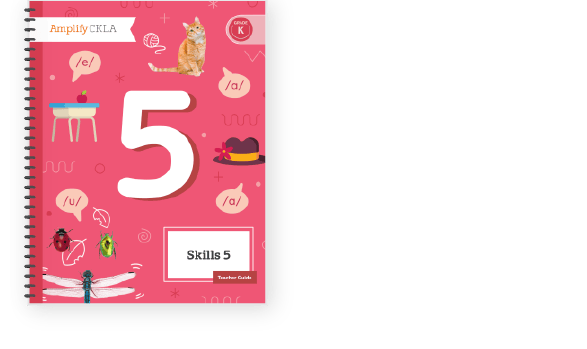
Teacher materials
Skills Unit 5 Teacher Guide
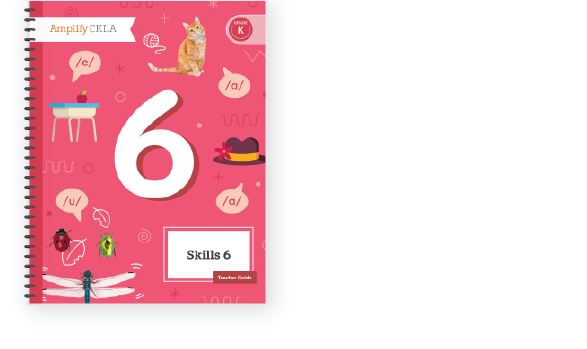
Teacher materials
Skills Unit 6 Teacher Guide
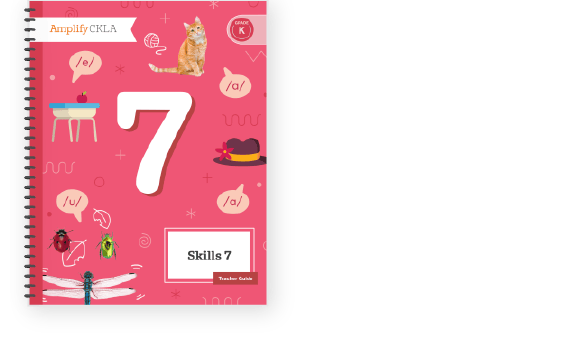
Teacher materials
Skills Unit 7 Teacher Guide
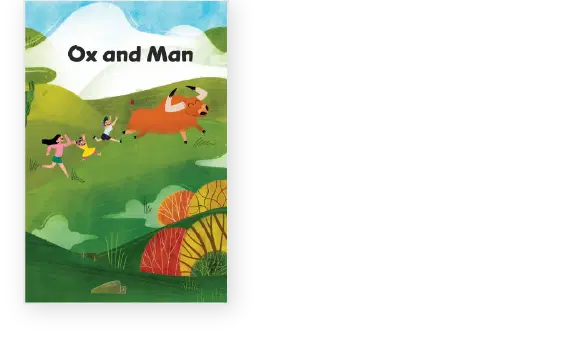
Teacher materials
Skills Unit 5 Big Book

Teacher materials
Skills Unit 6 Big Book
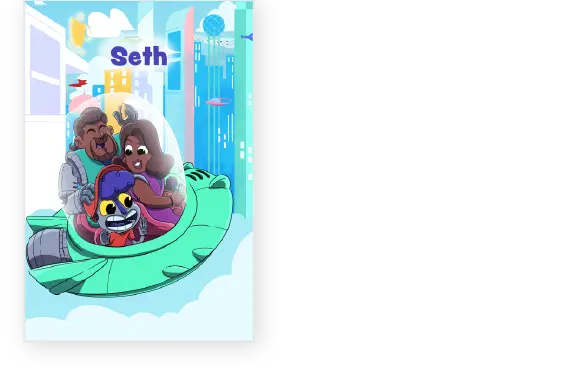
Teacher materials
Skills Unit 7 Big Book

Teacher materials
Small Letter Card Set

Teacher materials
Large Letter Card Set
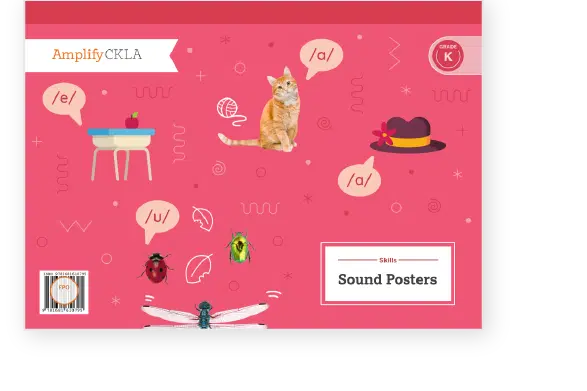
Teacher materials
Sound Posters Sample
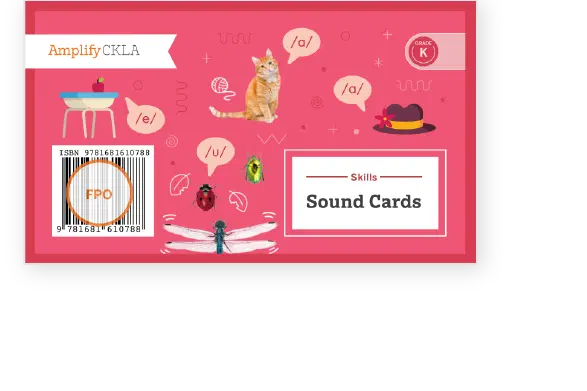
Teacher materials
Sound Cards Sample
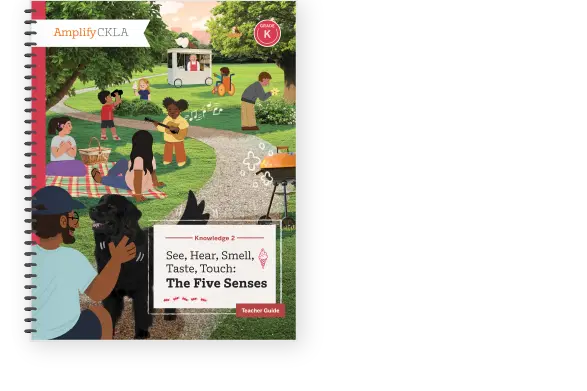
Teacher materials
Knowledge 2 Teacher Guide

Teacher materials
Knowledge 3 Teacher Guide
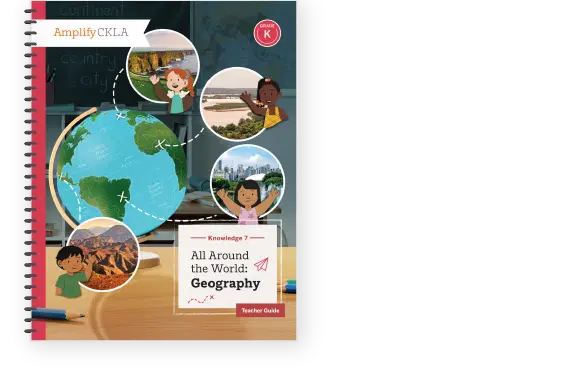
Teacher materials
Knowledge 7 Teacher Guide
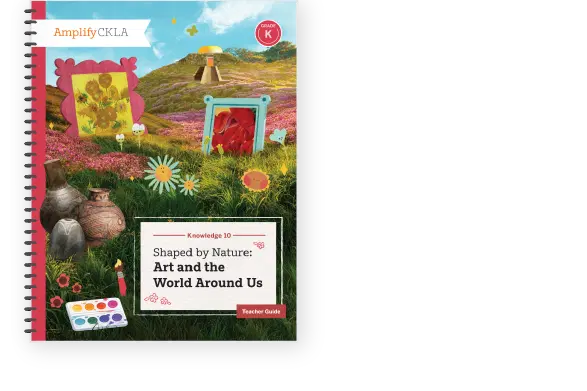
Teacher materials
Knowledge 10 Teacher Guide
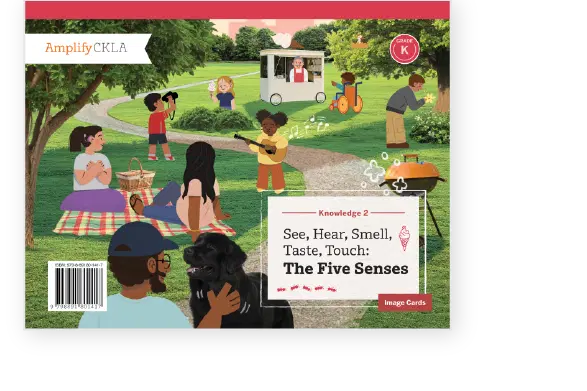
Teacher materials
Knowledge 2 Image Cards
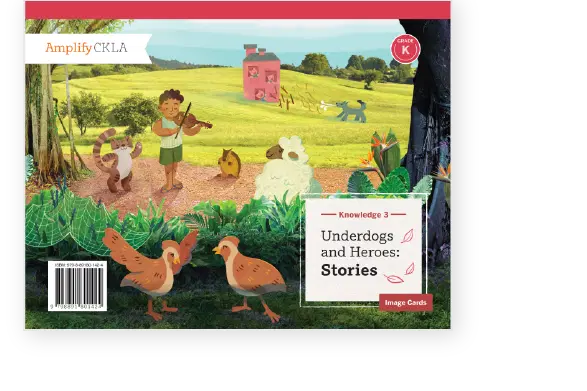
Teacher materials
Knowledge 3 Image Cards
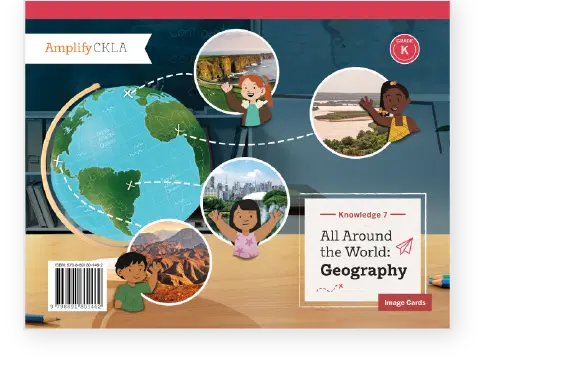
Teacher materials
Knowledge 7 Image Cards
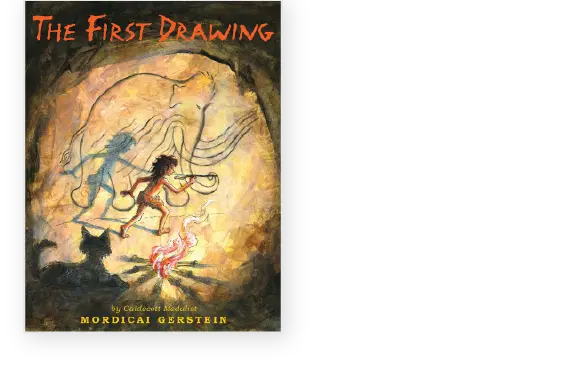
Teacher materials
The First Drawing
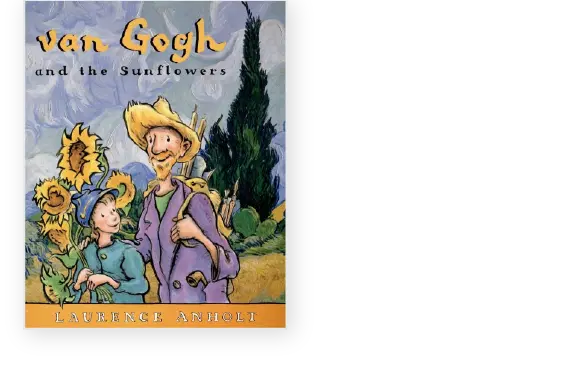
Teacher materials
Van Gogh and the Sunflowers
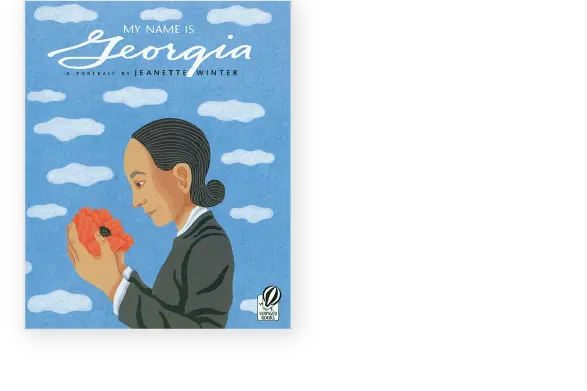
Teacher materials
My Name is Georgia
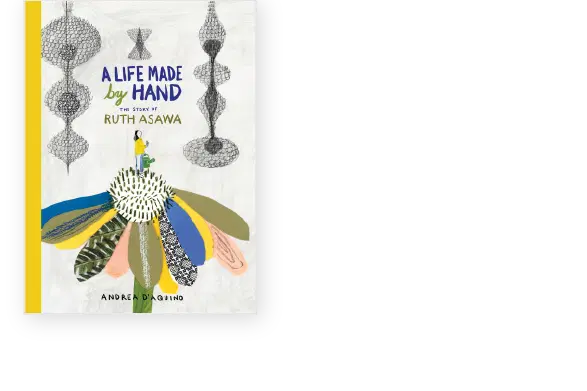
Teacher materials
A Life Made by Hand
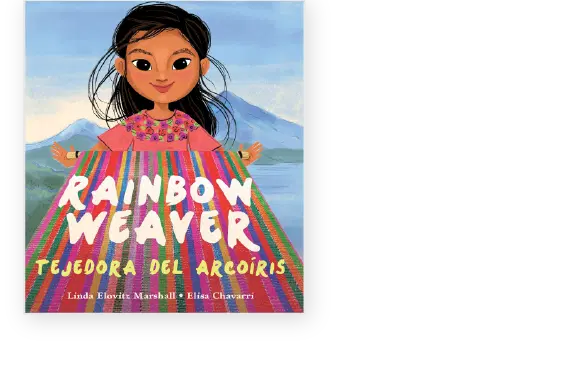
Teacher materials
Rainbow Weaver/Tejedora del Arcoiris
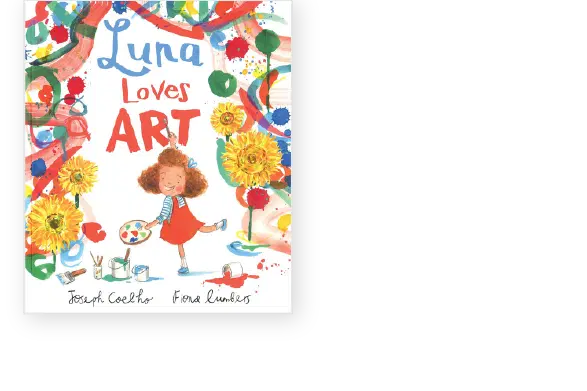
Teacher materials
Luna Loves Art
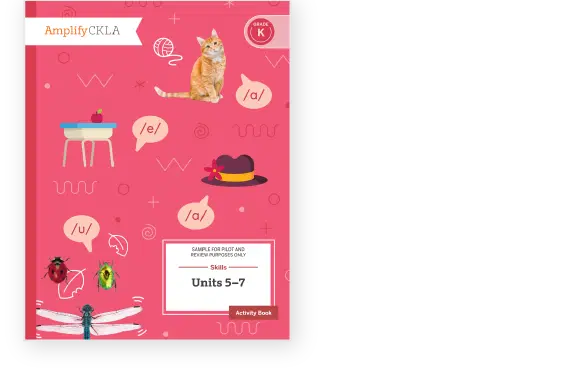
Student materials
Skills Unit 5, 6 and 7 Activity Book Sample

Student materials
Skills Unit 6 Reader

Student materials
Skills Unit 7 Reader
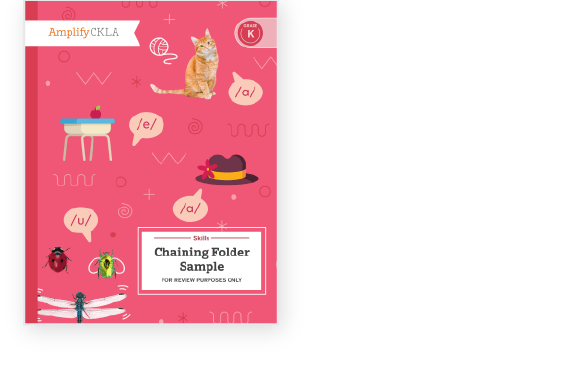
Student materials
Chaining Folder
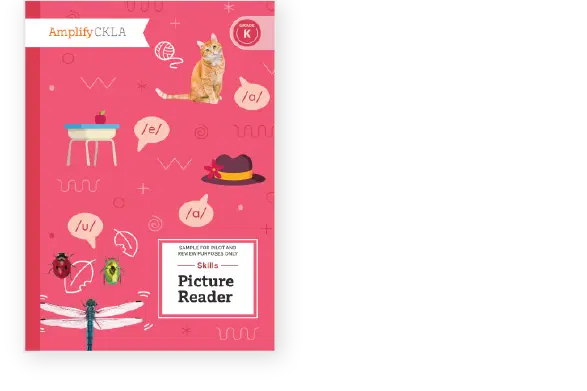
Student materials
Picture Reader Sample
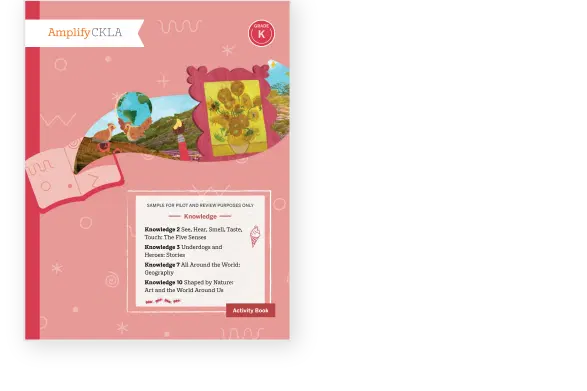
Student materials
Knowledge 2, 3, 7 and 10 Activity Book Sample
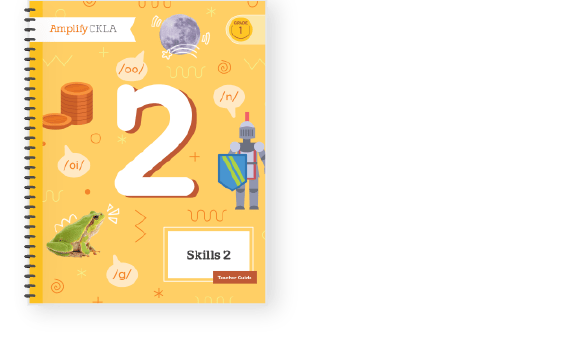
Teacher materials
Skills Unit 2 Teacher Guide
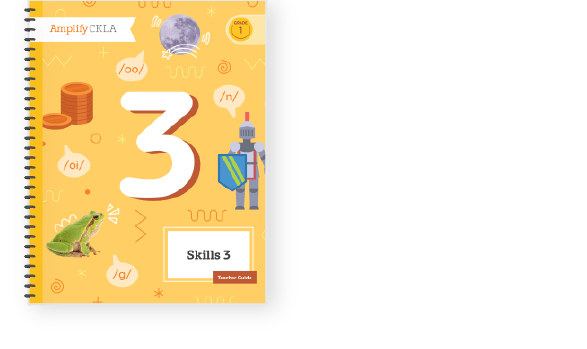
Teacher materials
Skills Unit 3 Teacher Guide
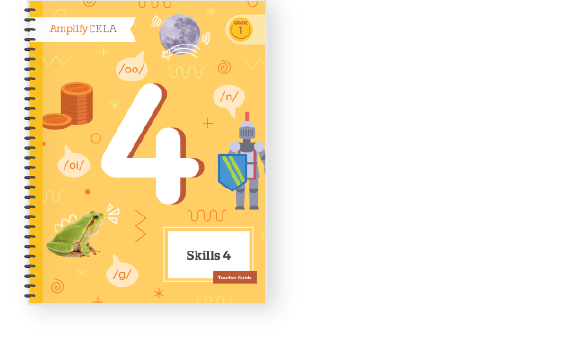
Teacher materials
Skills Unit 4 Teacher Guide

Teacher materials
Skills Unit 2 Big Book
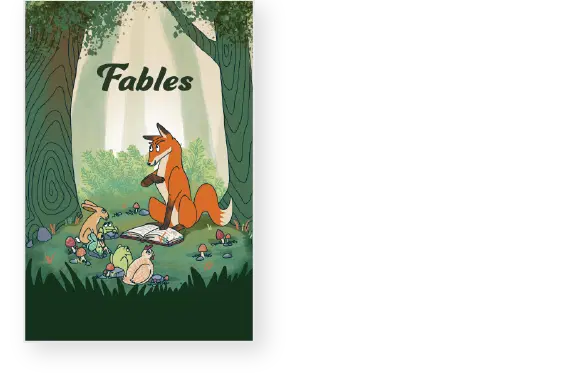
Teacher materials
Skills Unit 3 Big Book
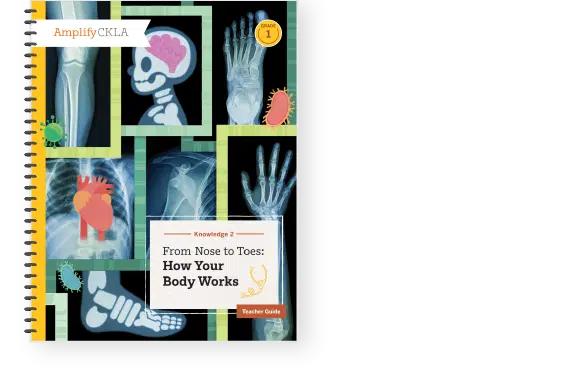
Teacher materials
Knowledge 2 Teacher Guide

Teacher materials
Knowledge 3 Teacher Guide

Teacher materials
Knowledge 5 Teacher Guide
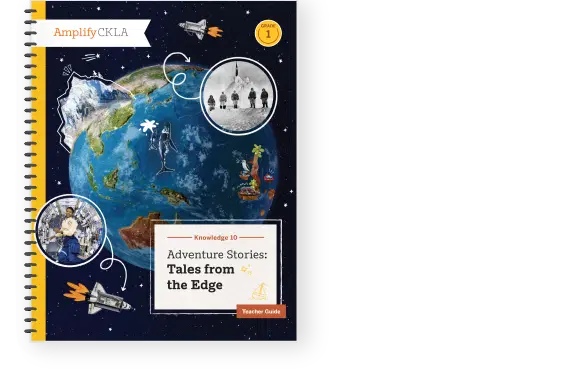
Teacher materials
Knowledge 10 Teacher Guide
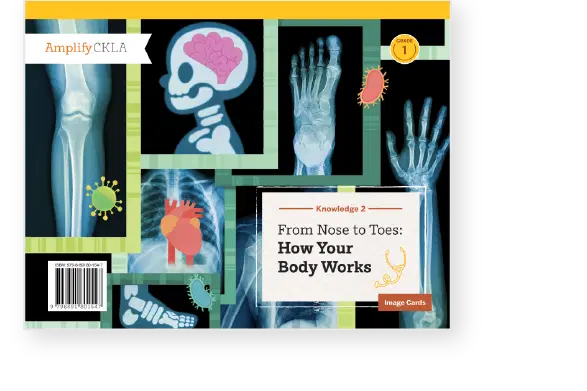
Teacher materials
Knowledge 2 Image Cards
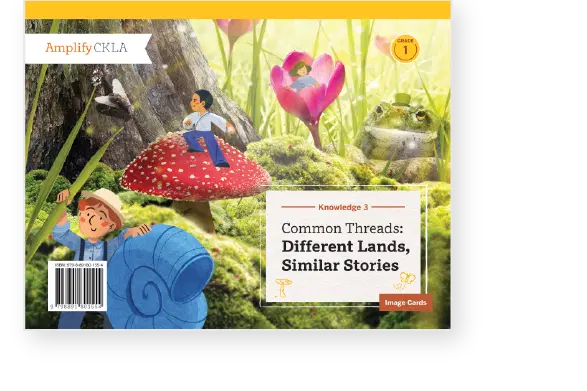
Teacher materials
Knowledge 3 Image Cards
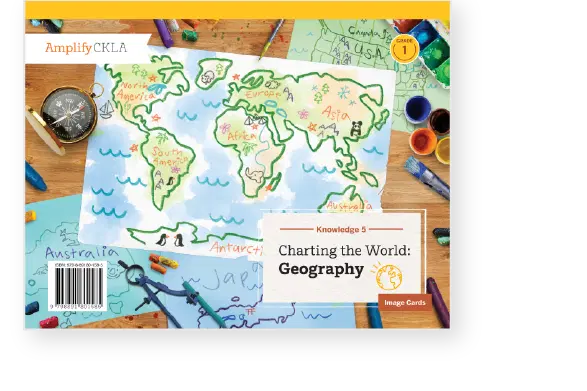
Teacher materials
Knowledge 5 Image Cards
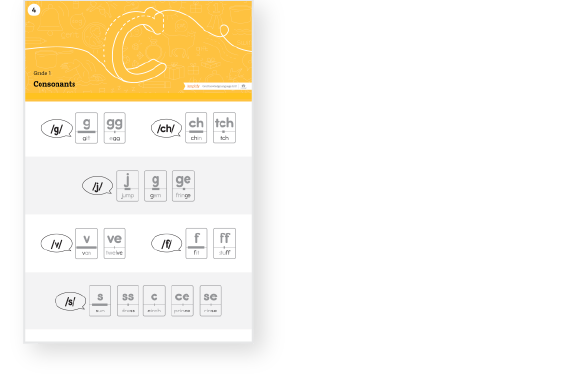
Teacher materials
Code Poster Set
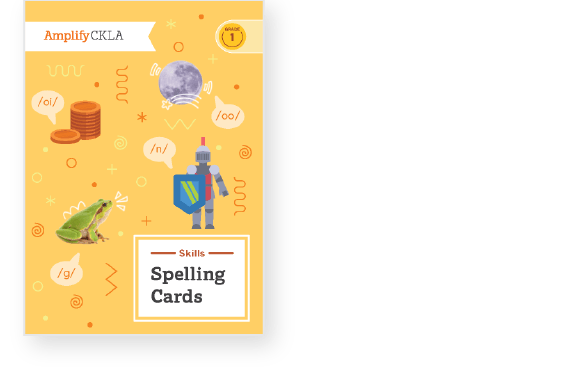
Teacher materials
Spelling Card Set

Teacher materials
Large Letter Card Set
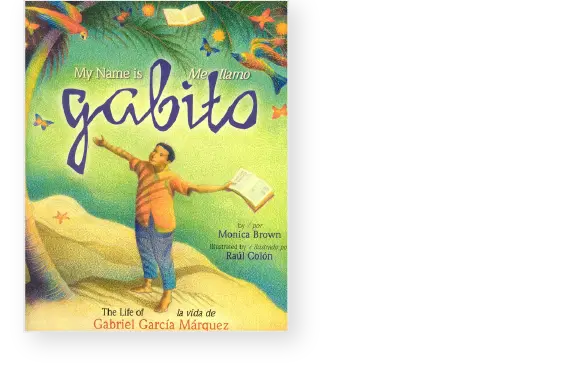
Teacher materials
My Name is Gabito/Me llamo Gabito

Teacher materials
Tomas and the Galapagos Adventure

Teacher materials
The Astronaut with a Song for the Stars: The Story of Dr. Ellen Ochoa

Teacher materials
Mae Among the Stars

Teacher materials
Shark Lady: The True Story of How Eugenie Clark Became the Ocean’s Most Fearless Scientist
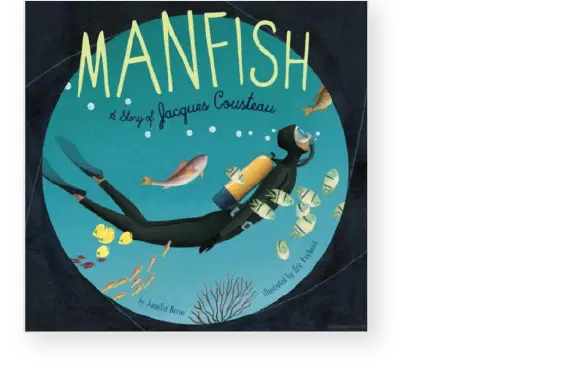
Teacher materials
Manfish

Teacher materials
Keep On! The Story of Matthew Henson, Co-Discoverer of the North Pole

Teacher materials
The Top of the World: Climbing Mount Everest

Student materials
Unit 2, 3 and 4 Skills Activity Book Sample
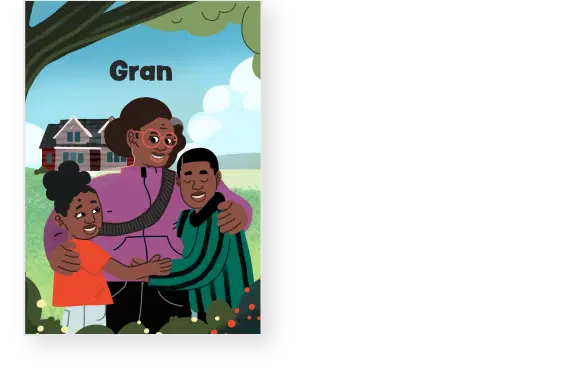
Student materials
Skills Unit 2 Reader

Student materials
Skills Unit 3 Reader

Student materials
Skills Unit 4 Reader

Student materials
Knowledge 2, 3, 5 and 10 Activity Book Sample
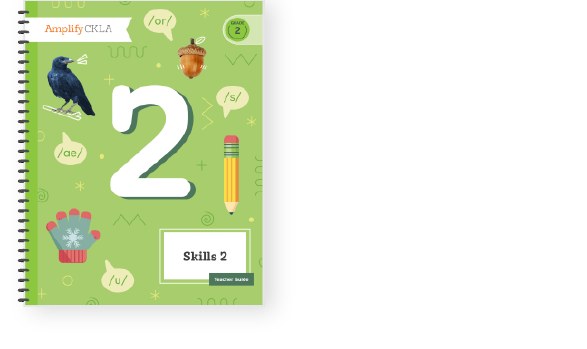
Teacher materials
Skills Unit 2 Teacher Guide
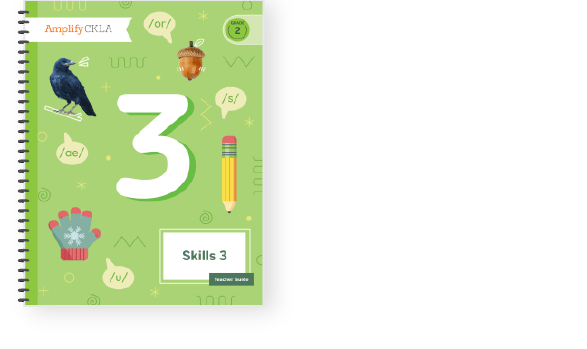
Teacher materials
Skills Unit 3 Teacher Guide

Teacher materials
Code Posters
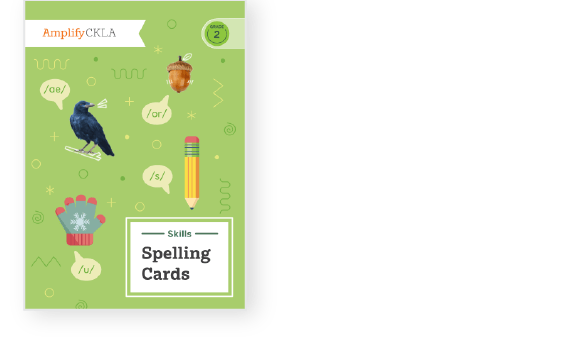
Teacher materials
Spelling Card Set
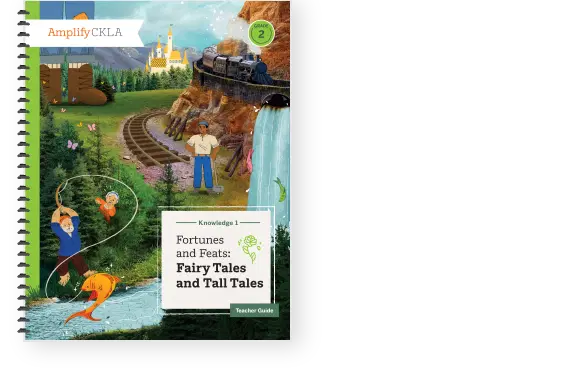
Teacher materials
Knowledge 1 Teacher Guide
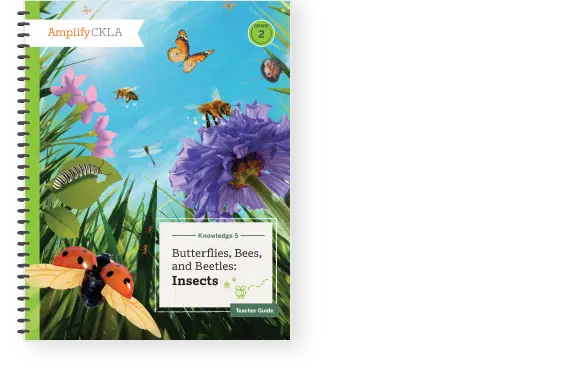
Teacher materials
Knowledge 5 Teacher Guide
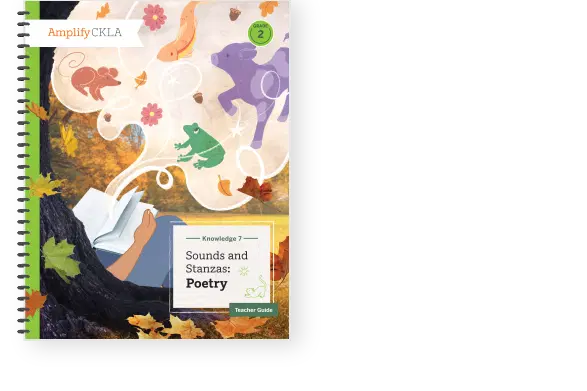
Teacher materials
Knowledge 7 Teacher Guide
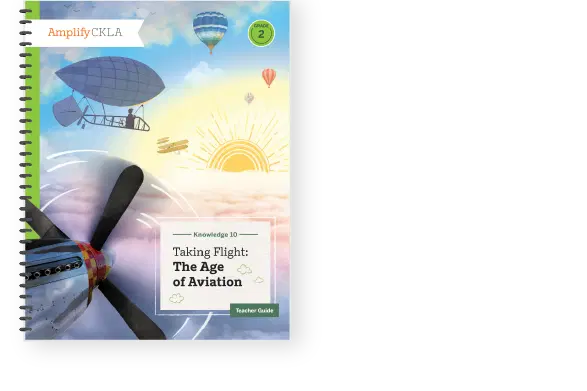
Teacher materials
Knowledge 10 Teacher Guide
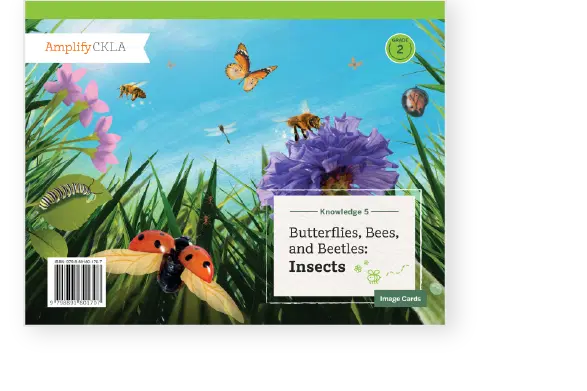
Teacher materials
Knowledge 5 Image Cards

Teacher materials
Knowledge 7 Image Cards

Teacher materials
Up and Away! How Two Brothers Invented the Hot Air Balloon
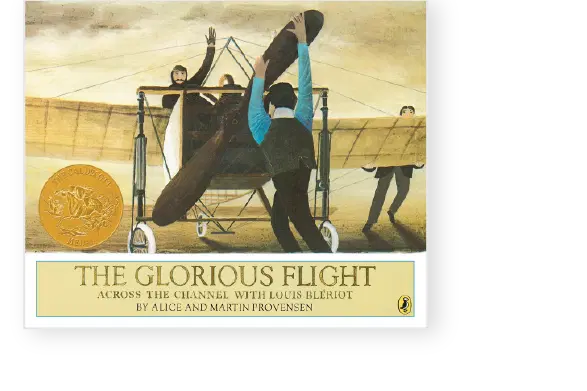
Teacher materials
The Glorious Flight: Across the Channel with Louis
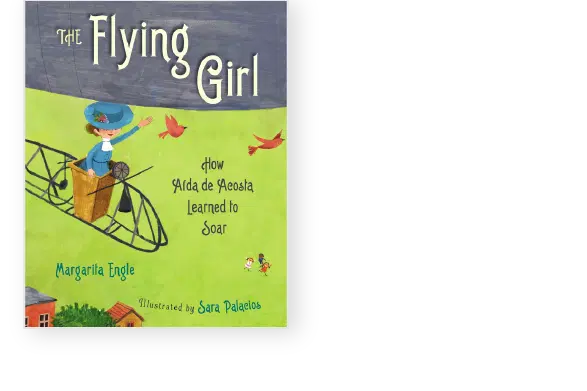
Teacher materials
The Flying Girl: How Aída de Acosta Learned to Soar
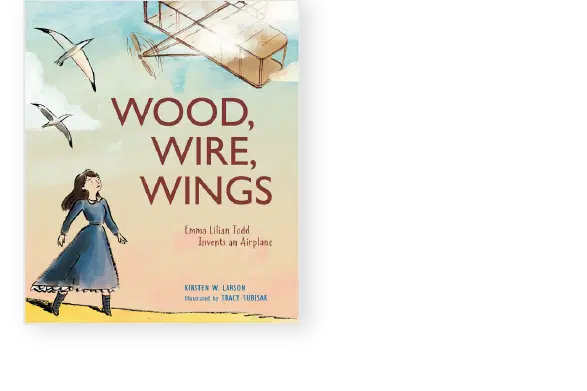
Teacher materials
Wood, Wire, Wings: Emma Lilian Todd Invents an Airplane

Teacher materials
Helicopter Man: Igor Sikorsky and His Amazing Invention
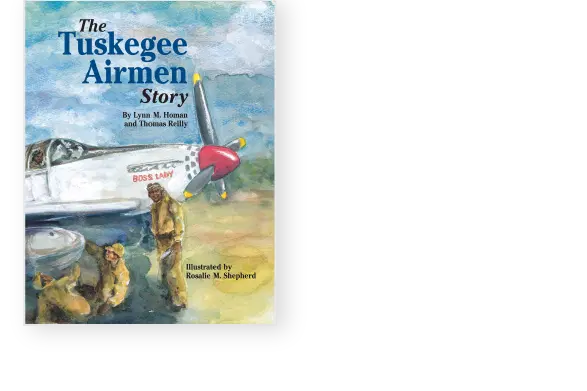
Teacher materials
The Tuskegee Airmen Story

Teacher materials
Skyward: The Story of Female Pilots in WWII
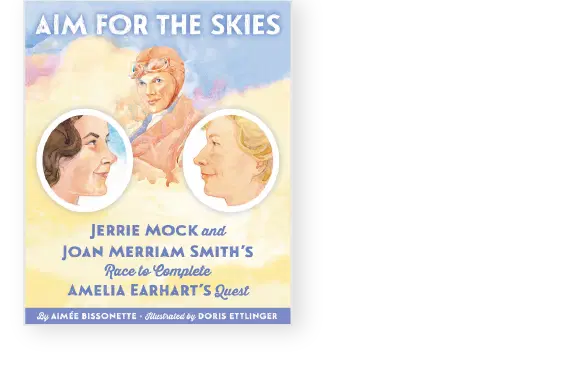
Teacher materials
Aim for the Skies: Jerrie Mock and Joan Merriam Smith’s Race to Complete Amelia Earhart’s Quest
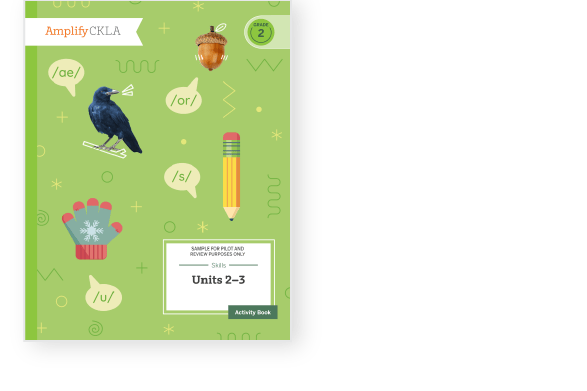
Student materials
Skills Unit 2 and 3 Activity Book Sample

Student materials
Skills Unit 2 Reader
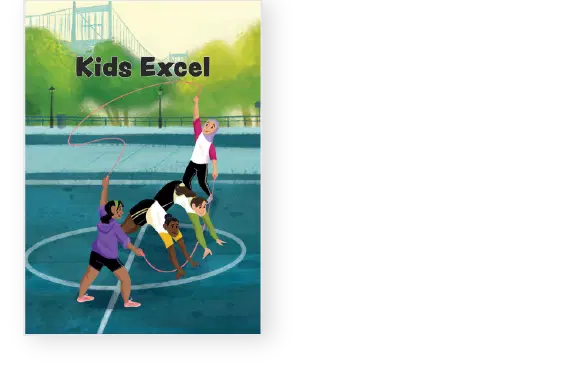
Student materials
Skills Unit 3 Reader
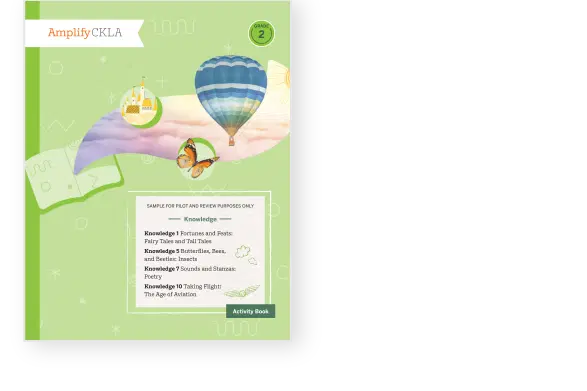
Student materials
Knowledge 1, 5, 7 and 10 Activity Book Sample
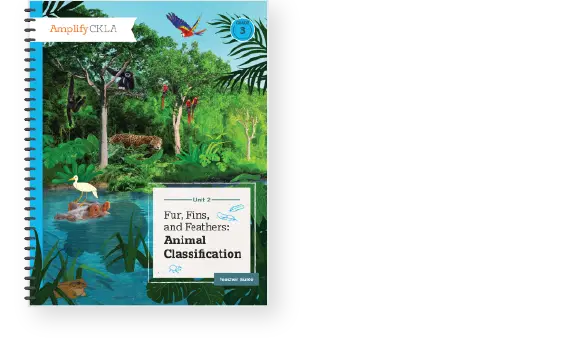
Teacher materials
Unit 2 Teacher Guide
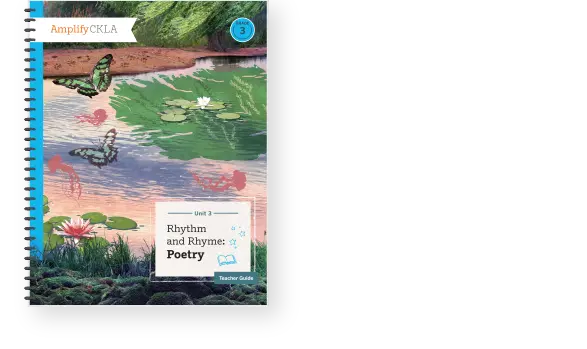
Teacher materials
Unit 3 Teacher Guide
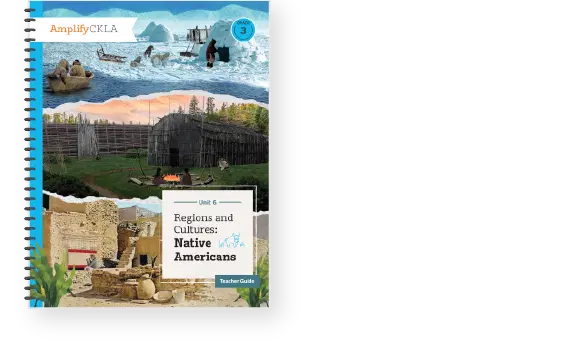
Teacher materials
Unit 6 Teacher Guide
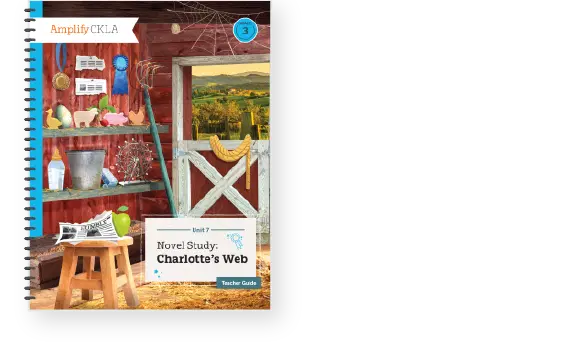
Teacher materials
Unit 7 Teacher Guide

Teacher materials
Unit 6 Image Cards
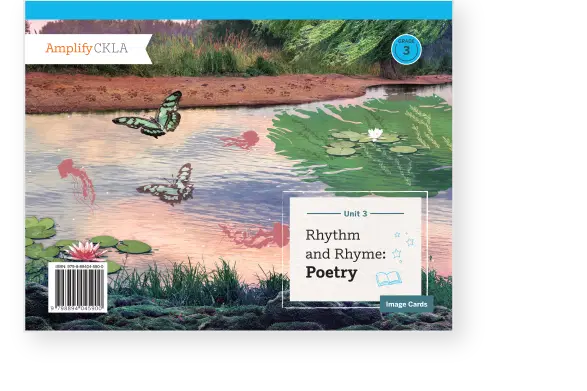
Teacher materials
Unit 3 Image Cards

Student materials
Unit 2 and 6 Activity Book Sample
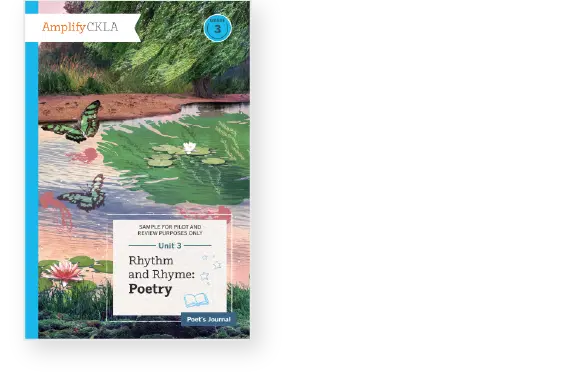
Student materials
Poet’s Journal
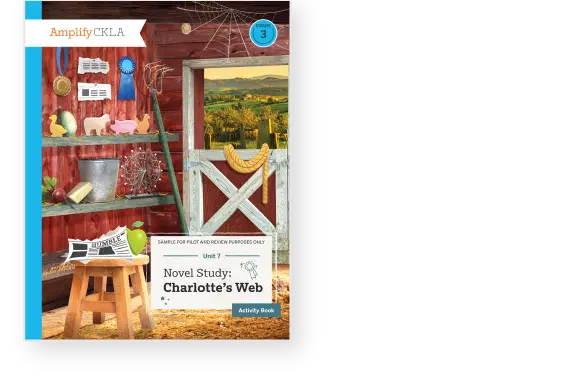
Student materials
Unit 7 Activity Book Sample
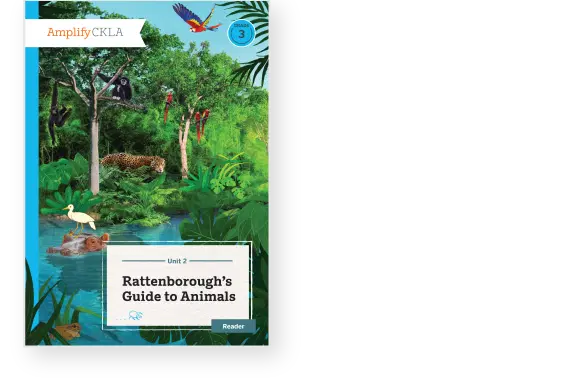
Student materials
Unit 2 Reader
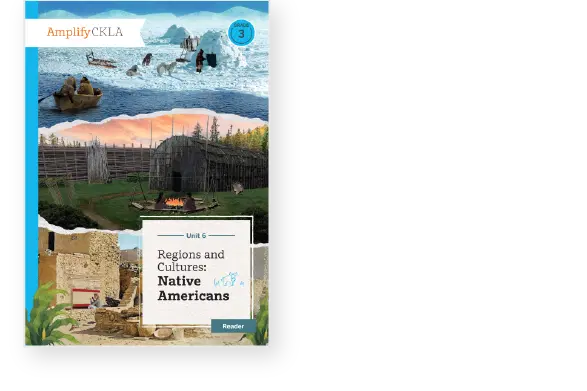
Student materials
Unit 6 Reader
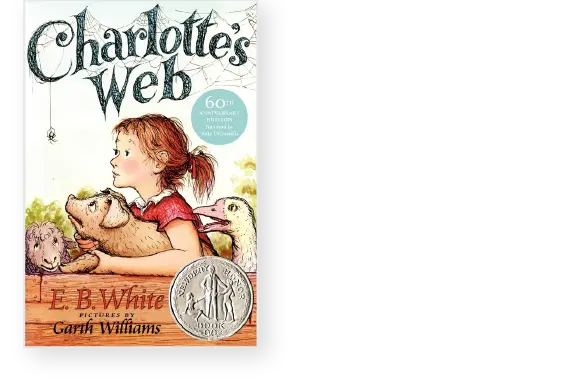
Student materials
Charlotte’s Web
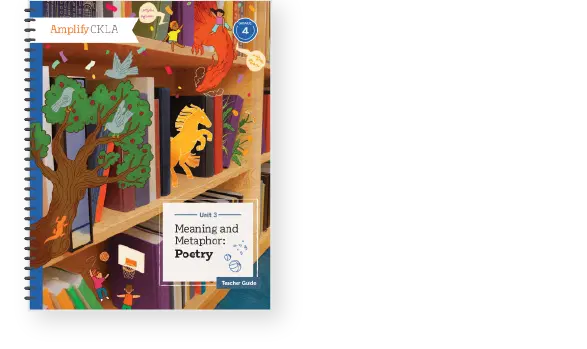
Teacher materials
Unit 3 Teacher Guide
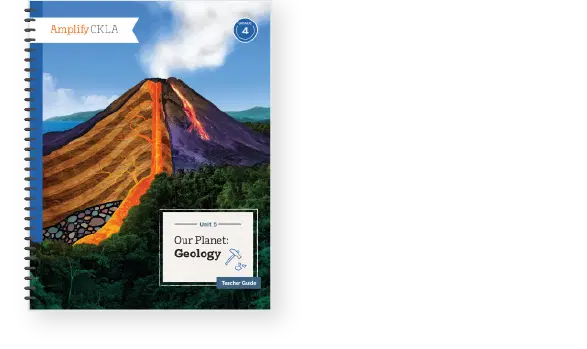
Teacher materials
Unit 5 Teacher Guide
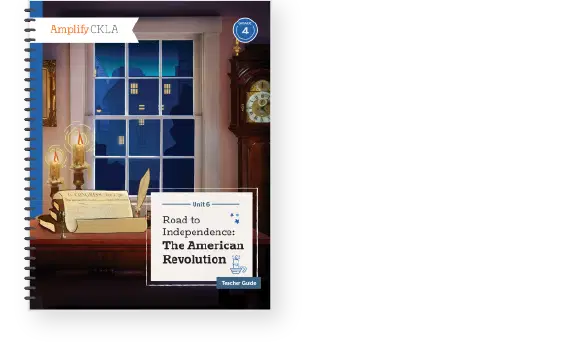
Teacher materials
Unit 6 Teacher Guide
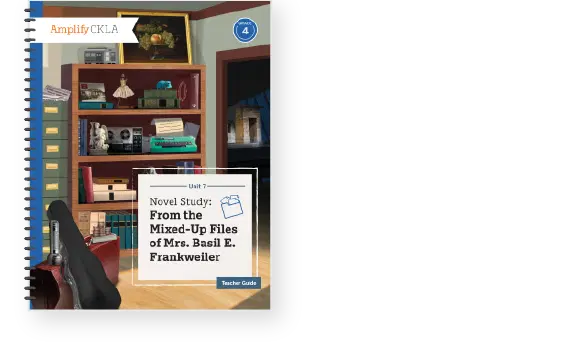
Teacher materials
Unit 7 Teacher Guide
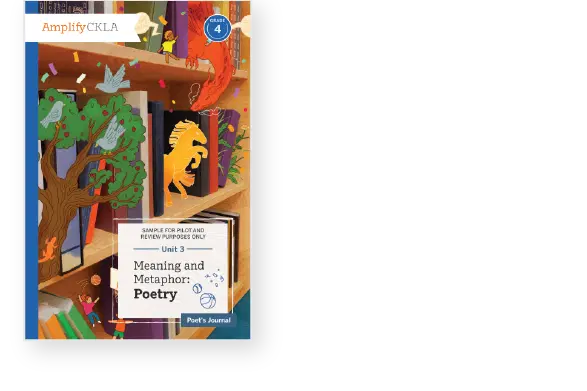
Student materials
Poet’s Journal
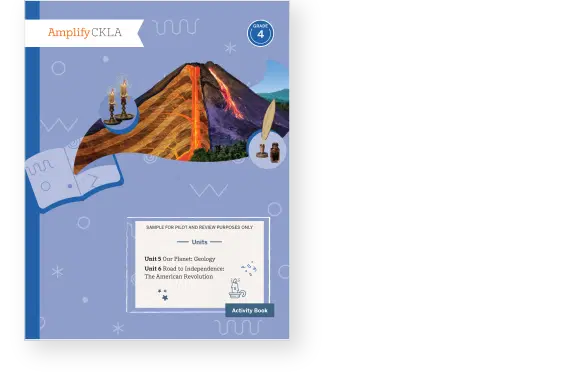
Student materials
Unit 5 and 6 Activity Book Sample
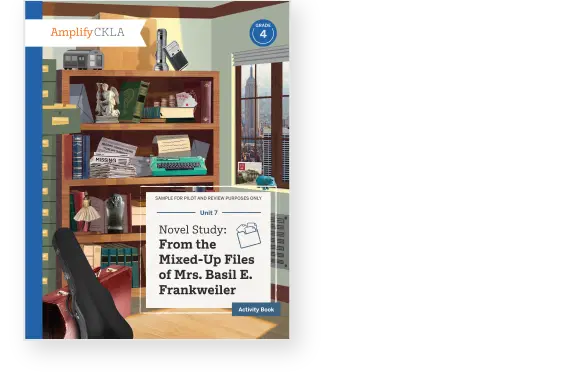
Student materials
Unit 7 Activity Book Sample
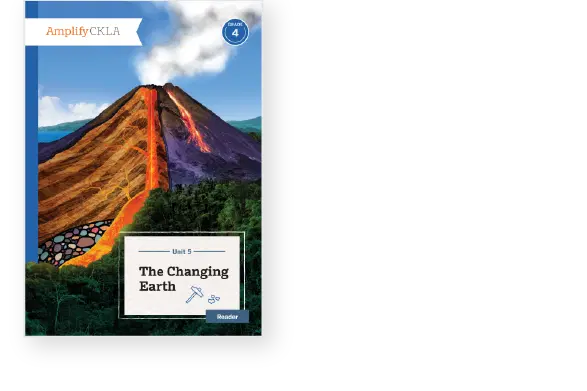
Student materials
Unit 5 Reader
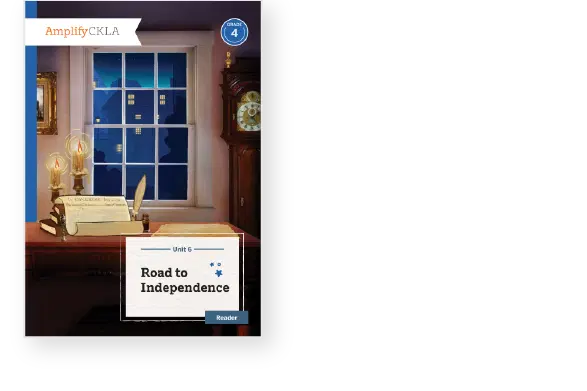
Student materials
Unit 6 Reader
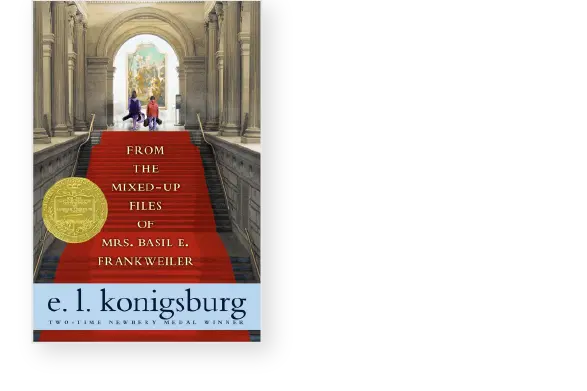
Student materials
From the Mixed Up Files of Mrs. Basil E. Frankweiler
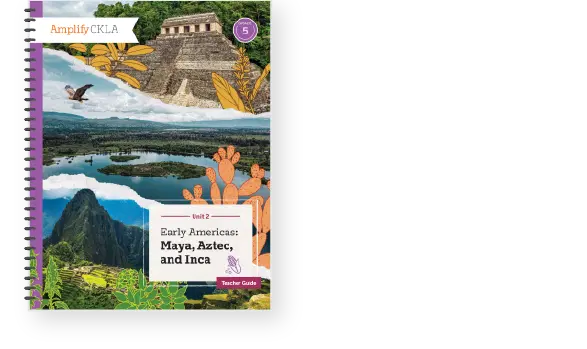
Teacher materials
Unit 2 Teacher Guide
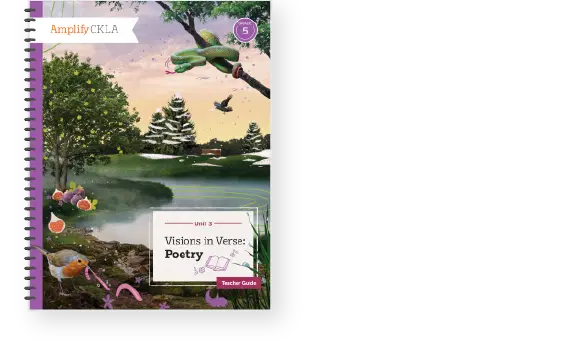
Teacher materials
Unit 3 Teacher Guide

Teacher materials
Unit 5 Teacher Guide

Teacher materials
Unit 7 Teacher Guide
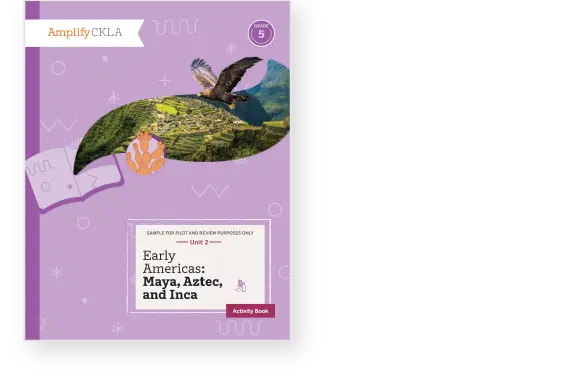
Student materials
Unit 2 Activity Book Sample

Student materials
Unit 5 Activity Book Sample
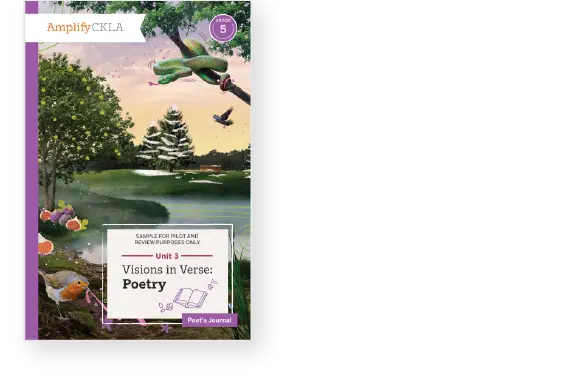
Student materials
Poet’s Journal
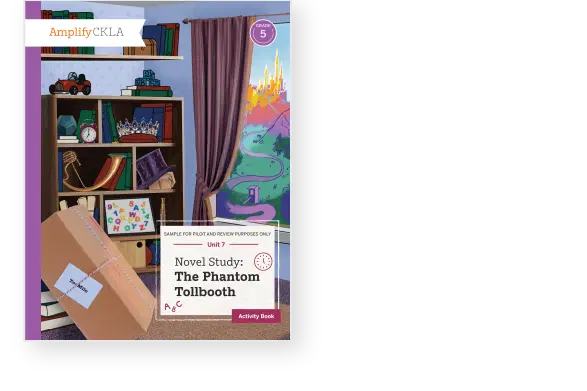
Student materials
Unit 7 Activity Book Sample
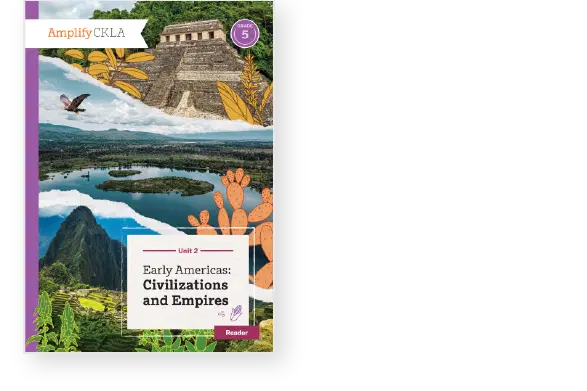
Student materials
Unit 2 Reader

Student materials
Unit 5 Reader

Student materials
The Phantom Tollbooth
Access the Amplify CKLA all-in-one digital platform
Teachers and students piloting CKLA 3rd Edition will receive login information to access the digital platform.
If you have not received your login information please contact your administrative team. If you are in charge of licensing and enrollment for your school/district and have not received login information please reach out to your account representative or help@amplify.com.

Amplify CKLA 3rd Edition Pilot Packs
Beginning-of-year pilot
We know it can be overwhelming to start a new curriculum, but we’re here to help every step of the way! Within this site, you’ll find resources to help you get started before your implementation training, including a materials checklist, unit and domain summaries, support videos, and more. These tools will support your core literacy instruction with Amplify CKLA during your pilot period. We hope this site is helpful in getting you started.
Beginning-of-year pilot
Get started
To get started with your new pilot of Amplify CKLA 3rd Edition, you’ll first want to review the following:
You may also find the resources below helpful as you begin your pilot:
Access key materials designed to support your review of Amplify CKLA 3rd Edition.
- Program Guide
- Components checklist
- Knowledge Sequence
- Unit Summaries
- Full Program Review site
- Password: TheNextChapter
Amplify CKLA’s all-in-one digital platform offers essential tools that streamline instruction for teachers and engage students with meaningful content. Teachers can plan and deliver lessons efficiently, while students can access assignments, assessments, and fun practice games.
Presentation Screens
Deliver interactive lessons with ready-made, customizable slides for every lesson.
Auto-scored digital assessments
Assess vocabulary, comprehension, and knowledge development at the end of each K–2 Knowledge and 3–5 Integrated Unit.
Standards-based reports
Identify strengths and growth areas for individuals or your entire class. Interactive dashboards offer detailed results from assessments and activities.
Skill-building practice games
Engage students with interactive games that reinforce concepts and make learning fun. Powered by Boost Reading™, these games align with lessons and provide real-time feedback.
eReader
Students access texts, take notes, and use audio-enabled eReaders to enhance their reading experience.
Sound Library
Students watch articulation videos and listen to songs for each sound to support phonological awareness.


Beginning-of-year Pilot Pack materials
Below are the components of your Amplify CKLA Pilot Pack, organized by grade level and teacher/student materials. Please click on your grade level to review the teacher and student materials listed and verify that all items have been received.

Teacher materials
Skills Unit 1 Teacher Guide

Teacher materials
Skills Unit 2 Teacher Guide

Teacher materials
Skills Unit 3 Teacher Guide

Teacher materials
Skills Unit 4 Teacher Guide

Teacher materials
Skills Unit 5 Teacher Guide

Teacher materials
Skills Unit 4 Big Book

Teacher materials
Skills Unit 5 Big Book

Teacher materials
Small Letter Card Set

Teacher materials
Large Letter Card Set

Teacher materials
Sound Posters Sample

Teacher materials
Sound Cards Sample

Teacher materials
Skills Assessment Guide (Black Line Master)

Teacher materials
Knowledge 1 Teacher Guide

Teacher materials
Knowledge 2 Teacher Guide

Teacher materials
Knowledge 3 Teacher Guide

Teacher materials
Knowledge 4 Teacher Guide

Teacher materials
Knowledge 1 Image Cards

Teacher materials
Knowledge 2 Image Cards

Teacher materials
Knowledge 3 Image Cards

Teacher materials
Knowledge 4 Image Cards

Student materials
Skills 1–5 Activity Book Sample

Student materials
Chaining Folder

Student materials
Picture Reader Sample

Student materials
Knowledge 1–4 Activity Book Sample

Teacher materials
Skills Unit 1 Teacher Guide

Teacher materials
Skills Unit 2 Teacher Guide

Teacher materials
Skills Unit 3 Teacher Guide

Teacher materials
Skills Unit 1 Big Book

Teacher materials
Skills Unit 2 Big Book

Teacher materials
Skills Unit 3 Big Book

Teacher materials
Code Poster Set

Teacher materials
Spelling Card Set

Teacher materials
Large Letter Card Set

Teacher materials
Skills Assessment Guide (Black Line Master)

Teacher materials
Knowledge 1 Teacher Guide

Teacher materials
Knowledge 2 Teacher Guide

Teacher materials
Knowledge 3 Teacher Guide

Teacher materials
Knowledge 4 Teacher Guide

Teacher materials
Knowledge 1 Image Cards

Teacher materials
Knowledge 2 Image Cards

Teacher materials
Knowledge 3 Image Cards

Teacher materials
Knowledge 4 Image Cards

Student materials
Skills 1–3 Activity Book

Student materials
Skills Unit 1 Reader

Student materials
Skills Unit 2 Reader

Student materials
Skills Unit 3 Reader

Student materials
Knowledge 1-4 Activity Book Sample
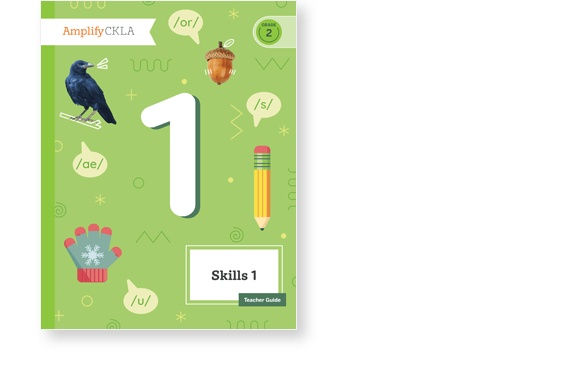
Teacher materials
Skills Unit 1 Teacher Guide

Teacher materials
Skills Unit 2 Teacher Guide
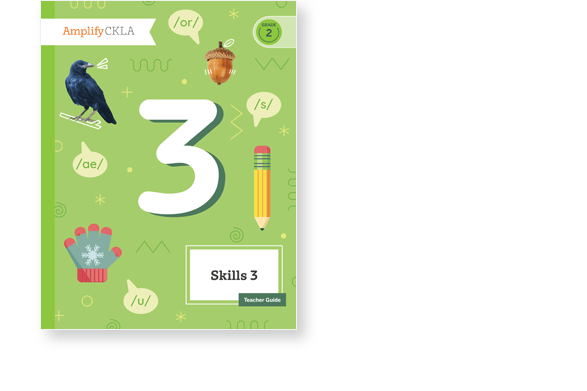
Teacher materials
Skills Unit 3 Teacher Guide
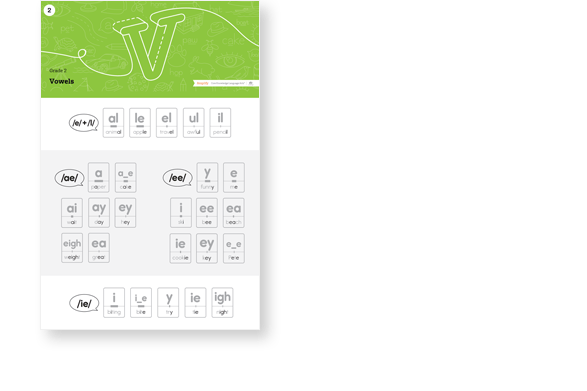
Teacher materials
Code Posters
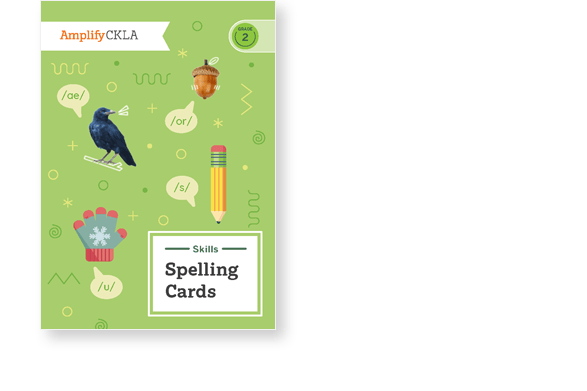
Teacher materials
Spelling Card Set
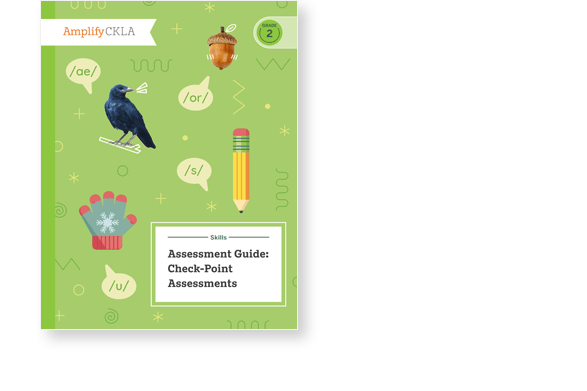
Teacher materials
Skills Assessment Guide (Black Line Master)
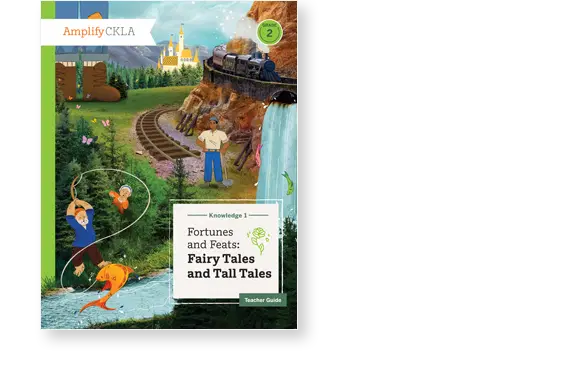
Teacher materials
Knowledge 1 Teacher Guide

Teacher materials
Knowledge 2 Teacher Guide
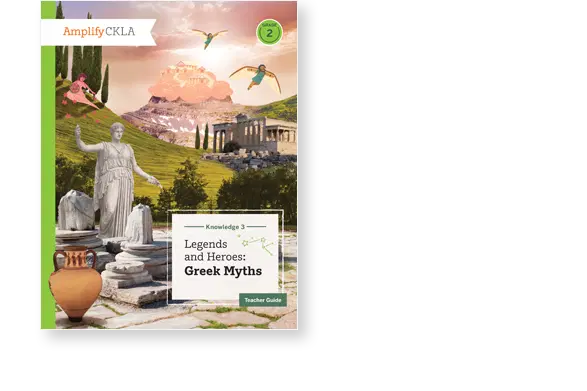
Teacher materials
Knowledge 3 Teacher Guide
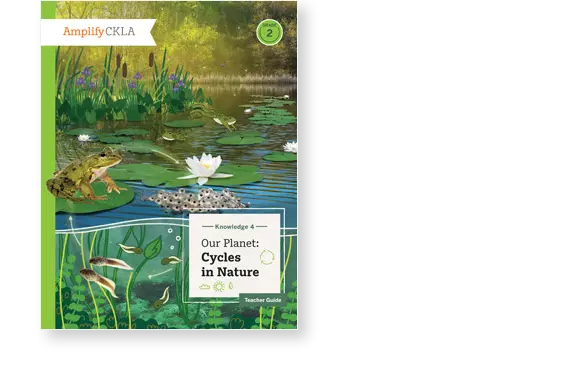
Teacher materials
Knowledge 4 Teacher Guide
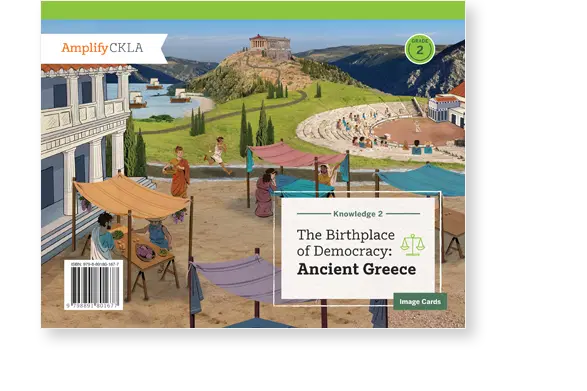
Teacher materials
Knowledge 2 Image Cards
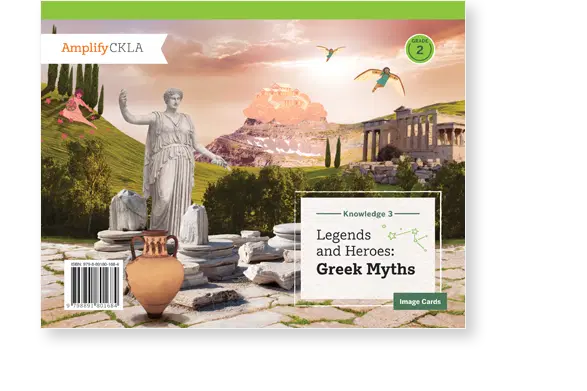
Teacher materials
Knowledge 3 Image Cards
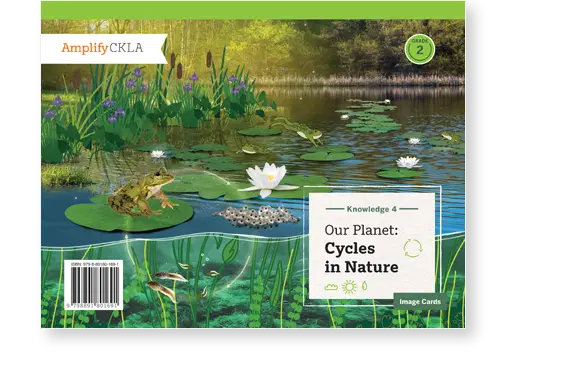
Teacher materials
Knowledge 4 Image Cards

Student materials
Skills 1–3 Activity Book Sample
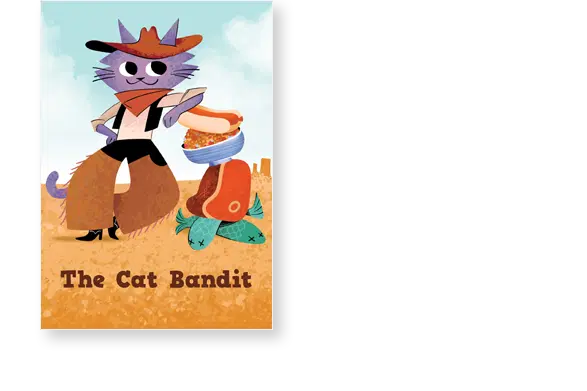
Student materials
Skills Unit 1 Reader
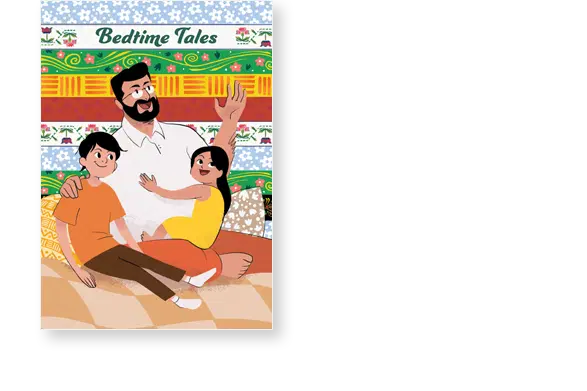
Student materials
Skills Unit 2 Reader
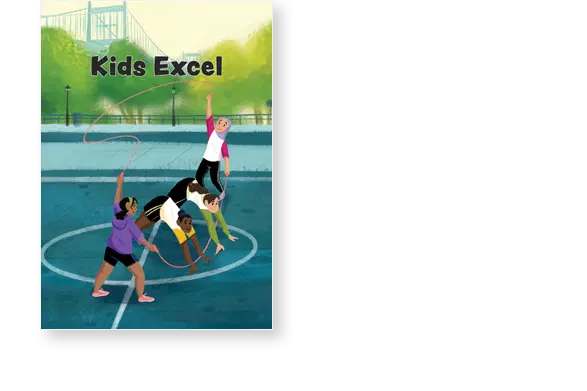
Student materials
Skills Unit 3 Reader

Student materials
Knowledge 1-4 Activity Book Sample

Teacher materials
Unit 1 Teacher Guide

Teacher materials
Unit 2 Teacher Guide

Teacher materials
Unit 3 Teacher Guide

Teacher materials
Unit 4 Teacher Guide

Teacher materials
Unit 1 Image Cards

Teacher materials
Unit 3 Image Cards

Teacher materials
Unit 4 Image Cards

Teacher materials
Spelling Card Set

Student materials
Unit 1–2 Activity Book

Student materials
Unit 3 Poet’s Journal

Student materials
Unit 4 Activity Book

Student materials
Unit 1 Reader

Student materials
Unit 2 Reader

Student materials
Unit 4 Reader

Teacher materials
Skills Unit 1 Teacher Guide (supplemental)

Teacher materials
Skills Unit 2 Teacher Guide (supplemental)

Teacher materials
Skills Assessment Guide Black Line Master (supplemental)

Student materials
Skills Activity Book: Unit 1–2 Black Line Master (supplemental)

Teacher materials
Unit 1 Teacher Guide

Teacher materials
Unit 2 Teacher Guide

Teacher materials
Unit 3 Teacher Guide

Teacher materials
Unit 4 Teacher Guide

Student materials
Unit 1–2 Activity Book

Student materials
Unit 3 Poet’s Journal

Student materials
Unit 4 Inventor’s Notebook

Student materials
Unit 1 Reader

Student materials
Unit 2 Reader

Student materials
Unit 4 Reader

Teacher materials
Unit 1 Teacher Guide

Teacher materials
Unit 2 Teacher Guide

Teacher materials
Unit 3 Teacher Guide

Teacher materials
Unit 4 Teacher Guide

Student materials
Unit 1–2 Activity Book

Student materials
Poet’s Journal

Student materials
Unit 4 Activity Book

Student materials
Unit 1 Reader

Student materials
Unit 2 Reader

Student materials
Unit 4 Reader
Access the Amplify CKLA all-in-one digital platform
Teachers and students piloting CKLA 3rd Edition will receive login information to access the digital platform.
If you have not received your login information please contact your administrative team. If you are in charge of licensing and enrollment for your school/district and have not received login information please reach out to your account representative or help@amplify.com.
The power of data: From literacy assessment to action

Teaching literacy is a balancing act. Your classroom may have students who soar through grade-level reading lessons and others who need additional support—or even intensive intervention—to keep up. And you may feel like there’s never enough time to meet everyone’s needs.
But with data, you can do it. By leveraging assessment data strategically, making the most of core instruction, and integrating intervention and personalized learning, you can give every student the support they need—without adding extra hours to your day.
Let’s break it down.
Types of data, defined
This you know: Not all assessments are created equal. Universal screeners help identify which students need extra support. Formative assessments track ongoing progress. Summative assessments measure overall learning. Each is a tool that equips you with the right information at the right time to adjust your instruction.
- Before core instruction: Universal screening and diagnostic assessments enable you to see where students are starting from and plan accordingly.
- During instruction: Formative assessments (e.g., quick checks, observations, and exit tickets) catch misunderstandings early so you can reteach on the spot.
- After instruction: Summative assessments measure progress; progress monitoring during intervention helps you know if students are on the right track before final assessments.
The goal isn’t more testing—it’s using the data from the assessments you have to make smarter instructional decisions.
Making the most of Tier 1 instruction
You spend most of the school day on core instruction. Making it as effective as possible benefits all students, not just those who are struggling. The key? Teach explicitly; use high-quality materials grounded in the Science of Reading; and keep instruction aligned to grade-level standards while allowing flexibility for different learning needs. Specifically:
- Model first, then guide, then let them try. Clear explanations and step-by-step modeling give students confidence before they work independently.
- Use formative assessments to adjust in real time. If an exit ticket shows most students didn’t grasp a concept, a quick reteach the next day can prevent gaps from growing.
- Group students for targeted support. Small groups during core instruction can help address specific skill gaps without taking students away from grade-level learning.
When core instruction is strong and built around what students actually need, intervention becomes more about fine-tuning rather than catching up from major gaps.
An MTSS framework: The right help at the right time
When assessment data shows that a student needs extra support, targeted intervention helps prevent small struggles from turning into bigger ones. A Multi-Tiered System of Supports (MTSS) can ensure that interventions are structured, data-driven, and matched to student needs.
- Intervention blocks and small groups: Some classrooms use dedicated intervention blocks to provide students extra support without missing core instruction. Others incorporate targeted small-group instruction during the literacy block. Either way, intervention works best when it’s built into the schedule, not squeezed in as an afterthought.
- Progress monitoring: Once students enter intervention, regular check-ins track their progress and allow you to make adjustments as needed without waiting for the next big assessment.
Small shifts, big impact
For students who are on track or need more challenge, personalized learning tools—such as adaptive reading programs—can provide meaningful independent practice. High-quality programs adjust automatically based on student performance, so each student gets exactly the right level of support or enrichment without adding extra prep for you.
In other words, teaching literacy well isn’t about working more—it’s about working strategically. By using assessments to inform your instruction, strengthening core teaching, and providing structured support or intervention when needed, you can position every student for success, no matter where they start.
More to explore
- MTSS: The key to success
- What Does Data Tell Us? Building Buy-in and Determining Areas of Need with Data
- Starting Your Science of Reading Shift: How to Use Assessment Data as a Building Block of MTSS
- The Story That Data Tells: Using Data to Chart Your Course With the Science of Reading
- Data as Your Compass: How Data and Assessment Guide Change When You’re Implementing a New Literacy Curriculum
Five years out from the pandemic, young readers have made much progress—but the pace has slowed.
The latest end-of-year data show improvement in early literacy across grades K–2. Overall, insights suggest:
- More young learners are above benchmark, and fewer are behind.
- Year over year improvements have slowed.
- Outcomes vary for boys and girls.

Explore Amplify’s end-of-year research brief.
Research briefs for the 2024–2025 school year
October 2024
BOY: Summer instructional loss highlights the importance of quality core instruction for the youngest grades.
February 2025
MOY: Early literacy gains offer hope for COVID recovery, though broader literacy challenges persist nationwide.
July 2025
EOY: Reading scores rise overall; gender disparities present a complex picture.
Read more research and case studies.
Amplify’s high-quality programs benefit millions of students every day using methods that are evidence-based, ESSA-aligned, and showing efficacy in a variety of contexts. Read more research and case studies and see more briefs on early literacy.
Expect more from your assessments with mCLASS Math.
Understanding student thinking is the key to accelerating student performance.
Welcome to mCLASS® Math, the benchmarking and progress monitoring system for grades K–8 that measures proficiency, reveals underlying mathematical thinking, and informs instructional support for every learner. Analyzing student responses to reveal valid underlying mathematical thinking—even in wrong answers—helps better target individualized instructional recommendations that build grade-level proficiency.
Meet mCLASS Math.
mCLASS Math’s research-based benchmark and progress monitoring assessment system tracks performance against grade-level expectations to help predict later growth outcomes.
With screening and diagnostic capabilities and empirically established cut scores to assess risk, mCLASS Math reporting helps educators pinpoint strengths and areas of growth for individualized instructional support for every student. Together, these establish a strong Multi-Tiered System of Supports (MTSS).
This powerful assessment is digitally assigned to the whole class three times annually: beginning-of-year (BOY), middle-of-year (MOY), and end-of-year (EOY). The open responses of the assessment give more robust data-points gathered from each item, and it only takes 30 to 40 minutes to complete.
Designed to target critical grade-level skills that predict success, the rich data can be used as a diagnostic tool for Tier 2 and Tier 3 intervention and flags for the potential risk of dyscalculia.
mCLASS Progress Monitoring assessments help teachers chart students’ progression between benchmark assessment windows. For students receiving targeted support, mCLASS Progress Monitoring determines if intervention is effective or adjustments are needed to enhance student learning.
These short yet effective assessments enable teachers to monitor a student’s math performance between mCLASS Benchmark assessments. mCLASS Progress Monitoring assessments can be assigned to a select group of students needing targeted support in a specific skill or Tier 2 or Tier 3 intervention, and are aligned around crucial math domains for each grade level.
Assess in less time.
With the groundbreaking digital analysis of student thinking, mCLASS Math teachers can rely on the predictive validity of assessments in less time.
The powerful Student Response Analysis of open-ended questions provides deep insight into what and how students think—faster and with fewer questions.

Access deeper insights.
mCLASS Math’s dynamic data reports offer a window into student thinking, reliably guiding intervention across Tiers 1–3.
The more teachers understand how their students think, the better they can support their growth. The assessment system recognizes students’ individual strengths, experiences, understandings, and strategies—or assets, as we collectively refer to them—to inform the robust data that powers mCLASS Math.
Educator and caregiver reports
Empirically established cut scores and domain-specific measures help teachers plan for tiered intervention with classroom, school, and district-level performance reports set to predict end-of-year outcomes.
To reinforce learning at home, Home Connect letters provide caregivers with easy-to-use reports on their child’s math development.
Student Thinking Report
The Student Thinking Report gives teachers actionable recommendations tailored to how individual students or groups of students approach problems. By understanding the different ways of thinking in skimmable, yet robust, reports, teachers have the tools they need to efficiently plan differentiation to achieve instructional targets.
Actionable recommendations enable teachers to quickly differentiate with intervention resources aligned to common misconceptions.
Research behind mCLASS Math
Based on decades of research for best practices in math, mCLASS Math efficiently assesses students’ skills and thinking to give teachers instant recommendations for small group and individualized instruction.
Following research from leading math experts and an in-depth validation analysis through WestEd, a technical report will be released summer 2025.

A dedicated team at Amplify with over 500 combined years of classroom teaching, school leadership, and assessment experience thoughtfully created mCLASS Math with teachers and students in mind.
Following research from leading math experts and an in-depth validation analysis through WestEd, data will be continuously released starting in spring 2025.

Sandra Pappas
Associate Director of Research

Patrick Callahan, Ph.D.
Educator and Founder of Math ANEX

Jason Zimba, Ph.D.
Chief Academic Officer of STEM
at Amplify
The mCLASS Math K–5 assessment system is designed to provide educators with reliable and valid measures to identify students needing additional support in mathematics and to inform instructional decisions. Preliminary data presents evidence supporting the psychometric quality of the assessment using the technical standards outlined by the National Center on Intensive Intervention (NCII) and state requirements for screening measures.
Data informs
instruction.
mCLASS Math works alongside your core instruction, differentiation, and intervention. The data model behind mCLASS Math provides comprehensive data for each student across grades K–8, easily connecting teachers to the immediate next steps that will support, strengthen, and stretch all learners.

Boost Personalized Learning accelerates student growth with daily, targeted 15-minute digital activities. Supported by a virtual tutor, students tackle individualized tasks linked to daily lessons, receiving just-in-time support to foster grade-level success.

Teacher-led, 15-minute Mini-Lessons can build grade-level proficiency by providing research-based, targeted intervention to small groups of students who need additional support.

Reinforce students’ understanding of concepts through collaborative, hands-on Centers (grades K–5). These student-led routines provide additional practice with vertical alignment across grade levels.
Fluency Practice uses spaced repetition, an evidence-based approach to promoting memory retention, to teach basic facts. The adaptive nature of the practice allows students to focus less and less on the facts they already know. We’ve partnered with Math for Love to iterate on the popular Multiplication by Heart to create Division by Heart and Addition and Subtraction by Heart I & II. These proven fluency decks—plus Skills Fluency for supporting procedural fluency practice—help students practice crucial skills independently.

Item Banks provide space for teachers to create custom practice and assessments by using filters and searching for standards, summative-style items, and more.

All students should have access to fun and challenging problems. Extensions are 10- to 15-minute activities aligned to the most critical topics for the grade, providing flexible, low-lift activities for the whole class or targeted intervention to small groups of students ready for an extra challenge.
One cohesive math experience
As part of Amplify Desmos Math, Amplify’s comprehensive math suite, mCLASS Math provides a strong foundation of actionable data to help teachers diagnose and capitalize on student strengths. Amplify Desmos Math ensures that you have all the core, intervention, and personalized instruction you need to support each stage of a student’s math journey.

Piloting mCLASS Lectura and Boost Lectura
Pilot educator,
Thank you for taking the time to sample Amplify’s Spanish language universal and dyslexia screener with personalized instruction. Making this important shift shows your commitment and dedication to your students. We truly appreciate the work you’re doing and are here to help you along the way.
This website is designed to set you up for success as you take this critical step to better understand your students and help them grow as confident, life-long readers.
Thank you for all you do,
—The Amplify team
Getting started

Ensure you’ve completed the following before launching your pilot programs:
- Participated in pilot training | Participant Notebook
- Logged into mCLASSⓇ Lectura and Boost Lectura via learning.amplify.com and confirmed your classes are set up as intended
- Talked with your pilot team about your benchmark dates and pilot goals
Then review the following implementation guidance for what to do before, after, and between benchmarks. Note that some recommendations are indicated as “Optional” to help narrow the focus of your pilot experience to the most critical elements of the mCLASS suite.
Implementing mCLASS Lectura and Boost Lectura

Gather Materials

Integrate Boost Reading into your classroom routine
Biliteracy considerations
(Note: Only applicable if your school or district is also piloting or using mCLASS Lectura with Boost Lectura)

Integrate Boost Reading and Boost Lectura into your classroom routine

Piloting mCLASS® and Boost Reading
Pilot educator,
Thank you for taking the time to sample Amplify’s universal and dyslexia screener with personalized instruction. Making this important shift shows your commitment and dedication to your students. We truly appreciate the work you’re doing and are here to help you along the way.
This website is designed to set you up for success as you take this critical step to better understand your students and help them grow as confident, life-long readers.
Thank you for all you do,
—The Amplify team
Getting started
Ensure you’ve completed the following before launching your pilot programs:
- Participate in pilot training | Participant Notebook
- Log in to mCLASS® and Boost Reading via learning.amplify.com to confirm your classes are set up as intended.
- Talk with your pilot team about your benchmark dates and pilot goals.
Note: If you’re piloting mCLASS Intervention, you can review this Participant Notebook and access your program at learning.amplify.com.
Once you’ve completed these steps, you’re ready to review the following implementation guidance for information about what to do before, after, and between benchmarks. Note that some recommendations are indicated as “Optional” to help narrow the focus of your pilot experience to the most critical elements of the mCLASS suite.

Implementing mCLASS and Boost Reading

Gather Materials

Integrate Boost Reading into your classroom routine

Use mCLASS Intervention with Tier 2–3 students (Note: Only applicable if your school or district added this program to your pilot.)
Biliteracy considerations
(Note: Only applicable if your school or district is also piloting or using mCLASS Lectura with Boost Lectura)

Integrate Boost Reading and Boost Lectura into your classroom routine
What’s new in Amplify CKLA 3rd Edition
Experience the next chapter in the Science of Reading with Amplify CKLA 3rd Edition.
In this edition, you’ll enjoy an enhanced knowledge-building sequence, more differentiation to reach all learners, digital assessments and reports, and enriched writing instruction grounded in the Science of Writing, the research behind how kids learn to write.

Enhanced knowledge-building sequence
We’ve added new units and updated existing ones to include a broader range of people, perspectives, and high-quality texts. New Choice Units even enable districts to select topics that best reflect their community’s values while maintaining standards coverage.
New units include:
- Geography in K–1
- Poetry units now starting in Grades 2–3
- Novel Study Units in Grades 3–5
- Oceans in Grade 5
- Research Units in every grade!
Instruction based on the Science of Writing
Our writing instruction is fully integrated and grounded in the Science of Writing, the research behind how kids learn to write effectively. Systematic daily lessons align with the Simple View of Writing and make it easier to help students develop writing proficiency—without additional programs.

K–2 writing
The Skills Strand covers all text types, and every Knowledge Strand unit now has high-impact writing activities, including sentence combining, sentence expanding, and pre-writing exercises like graphic organizers.
3–5 writing
Writing instruction remains explicit and systematic in Grades 3–5, with added high-impact writing activities to deepen learning.

More authentic, diverse texts
A variety of texts—from complex read-alouds and decodable chapter books to trade books and content-rich readers—connect to learning goals. Amplify CKLA 3rd Edition also features new Culminating Research and Novel Study Units!
Culminating Research Units
Each grade now includes a core Culminating Research Unit featuring carefully selected trade books. These units build critical thinking and research skills, from selecting topics to presenting findings.
Novel Study Units
Novel Study Units are part of district-level Choice Units in Grades 3–5. Districts can select one novel per grade, from classic or contemporary options, choosing the book that best reflects their community’s goals and values while still covering all required standards.
Easy-to-use materials, pacing for real classrooms
Running out of instructional time? We understand! Our streamlined units now cover all standards within 165 days, leaving more time for enrichment and remediation.

All-in-one digital platform
Amplify CKLA 3rd Edition is part of a digital platform that enables seamless integration across all Amplify programs.
The platform includes familiar tools like lesson slides—now Presentation Screens—along with new features such as skill-building games, assessments, and detailed reports.
Digital assessments
Auto-scored K–2 Knowledge and 3–5 End-of-Unit assessments deliver immediate insights to enable quick, data-driven decisions.
Standards-based reports
Detailed reports highlight strengths and growth opportunities at individual, group, and class levels, all aligned to standards.
Embedded support to reach all learners
We’ve worked with experts and practitioners to enhance our differentiation strategies, making content more accessible to all students—including multilingual/English learners. Improved iconography helps you quickly find in-the-moment support, ensuring these strategies are seamlessly integrated.


Grade 3 foundational skills instruction
Recognizing the ongoing need for foundational skills instruction beyond Grade 2, we’ve introduced Grade 3 Skills to reinforce and build on the K–2 Skills Strand. Use it to support core lessons or serve as an intervention, depending on your students’ needs.
The instruction follows a familiar sequence and offers flexibility: It can be taught in two 15-minute sessions or one 30-minute session.
Grade 3 Skills resources are included in core classroom kits, although the instruction isn’t required for Grade 3 standards coverage.
Bold new look and feel
With modernized covers, full-color interiors, and enhanced iconography, Amplify CKLA 3rd Edition materials are not only visually appealing, but also easier to navigate.


Amplify Caminos Pilot Packs
Pilot educator,
This is the beginning of the Amplify Caminos journey in your classroom! Making this important, evidence-based shift shows your commitment and dedication to your emergent bilingual students. We truly appreciate the work you’re doing and are here to help you along the way.
As a previous pilot teacher myself, I know how overwhelming it can feel to start a new curriculum. Within this site, you’ll find resources to help you get started before your implementation training, including a materials checklist, scope and sequence documents, support videos, and more! These tools will support your 6–12 weeks of core Spanish literacy instruction with Amplify Caminos. I hope this site is helpful in getting you started with your pilot.
Thank you for all you do,
—Maggie Buttaccio
Get started
To get started with your new pilot of Amplify Caminos, you’ll first want to review the following:
You may also find these documents helpful as you begin your pilot:

Pilot Pack components checklist
Below you’ll find the Amplify Caminos Pilot Pack components you should have received in your shipment, outlined by grade level and teacher/student materials. Please click your grade-level teacher materials and student materials to review the list and ensure that you received all of the materials.

Teacher materials
Lectoescritura Unit 4 Teacher Guide

Teacher materials
Lectoescritura Unit 5 Teacher Guide

Teacher materials
Lectoescritura Unit 6 Teacher Guide

Teacher materials
Lectoescritura Unit 4 Big Book

Teacher materials
Lectoescritura Unit 5 Big Book

Teacher materials
Lectoescritura Unit 6 Big Book

Teacher materials
Lectoescritura Large Letter Cards

Teacher materials
Lectoescritura Small Letter Cards

Teacher materials
GK Lectoescritura Image Cards SAMPLER

Teacher materials
Conocimiento Domain 2 Teacher Guide: Los cinco sentidos

Teacher materials
Conocimiento Domain 3 Teacher Guide: Cuentos

Teacher materials
Conocimiento Domain 4 Teacher Guide: Plantas

Teacher materials
Conocimiento Domain 2 Image Cards: Los cinco sentidos

Teacher materials
Conocimiento Domain 3 Image Cards: Cuentos

Teacher materials
Conocimiento Domain 4 Image Cards: Plantas

Student materials
Lectoescritura Unit 5 Reader

Student materials
Lectoescritura Unit 6 Reader

Student materials
Lectoescritura Unit 4 Activity Book

Student materials
Lectoescritura Unit 5 Activity Book

Student materials
Lectoescritura Unit 6 Activity Book

Student materials
Conocimiento SAMPLER (Domains 2, 3, 4)

Teacher materials
Lectoescritura Unit 1 Teacher Guide

Teacher materials
Lectoescritura Unit 2 Teacher Guide

Teacher materials
Lectoescritura Unit 3 Teacher Guide

Teacher materials
Lectoescritura Unit 1 Big Book

Teacher materials
Lectoescritura Unit 2 Big Book

Teacher materials
Lectoescritura Unit 3 Big Book

Teacher materials
Lectoescritura Large Letter Cards

Teacher materials
G1 Lectoescritura Image Cards SAMPLER

Teacher materials
Conocimiento Domain 2 Teacher Guide: El cuerpo humano

Teacher materials
Conocimiento Domain 3 Teacher Guide: Tierras diferentes

Teacher materials
Conocimiento Domain 5 Teacher Guide: Antiguas civilizaciones

Teacher materials
Knowledge Domain 2 Image Cards: El cuerpo humano

Teacher materials
Knowledge Domain 3 Image Cards: Tierras diferentes, cuentos similares

Teacher materials
Knowledge Domain 5 Image Cards: Antiguas civilizaciones de América

Student materials
Lectoescritura Unit 1 Reader

Student materials
Lectoescritura Unit 2 Reader

Student materials
Lectoescritura Unit 3 Reader

Student materials
Lectoescritura Unit 1 Activity Book

Student materials
Lectoescritura Unit 2 Activity Book

Student materials
Lectoescritura Unit 3 Activity Book

Student materials
Conocimiento SAMPLER (Domains 2, 3, 5)

Teacher materials
Lectoescritura Unit 1 Teacher Guide

Teacher materials
Lectoescritura Unit 2 Teacher Guide

Teacher materials
Conocimiento Domain 1 Teacher Guide: Cuentos de hadas

Teacher materials
Conocimiento Domain 4 Teacher Guide: Mitos griegos

Teacher materials
Conocimiento Domain 8 Teacher Guide: Los insectos

Teacher materials
Knowledge Domain 8 Image Cards: Los insectos

Teacher materials
Knowledge Domain 4 Image Cards: Mitos griegos

Student materials
Lectoescritura Unit 1 Reader

Student materials
Lectoescritura Unit 2 Reader

Student materials
Lectoescritura Unit 1 Activity Book

Student materials
Lectoescritura Unit 2 Activity Book

Student materials
Conocimiento SAMPLER (Domains 1, 4, 8)

Teacher materials
Unit 2 Teacher Guide: La clasificación de los animales

Teacher materials
Unit 5 Teacher Guide: La luz y el sonido

Teacher materials
Unit 8 Teacher Guide: Los nativos americanos

Teacher materials
Unit 5 Image Cards: La luz y el sonido

Teacher materials
Unit 8 Image Cards: Los nativos americanos: regiones y culturas

Student materials
Unit 2 Spanish Reader

Teacher materials
Unit 5 Spanish Reader

Student materials
Unit 8 Spanish Reader

Student materials
Unit 2 Activity Book

Student materials
Unit 5 Activity Book

Student materials
Unit 8 Activity Book

Teacher materials
Unit 3 Teacher Guide: Poesía

Teacher materials
Unit 5 Teacher Guide: Geología

Teacher materials
Unit 7 Teacher Guide: La Revolución estadounidense

Student materials
Unit 3 Poet’s Journal

Student materials
Unit 5 Spanish Reader

Student materials
Unit 7 Spanish Reader

Student materials
Unit 5 Activity Book

Student materials
Unit 7 Activity Book

Student materials
Anthology SAMPLER

Teacher materials
Unit 2 Teacher Guide: Las primeras civilizaciones americanas

Teacher materials
Unit 3 Teacher Guide: Poesía

Teacher materials
Unit 4 Teacher Guide: Las aventuras de Don Quijote

Student materials
Unit 2 Spanish Reader

Student materials
Unit 2 Activity Book

Student materials
Unit 3 Poet’s Journal

Student materials
Unit 4 Activity Book

Student materials
Anthology SAMPLER
How to access the Amplify Caminos Teacher Resource Site
You will receive your teacher demo account login information from your sales representative.

Piloting Boost Reading
Pilot educator,
Thank you for taking the time to sample Boost Reading – Amplify’s personalized reading curriculum for students in grades K-5. Making this important shift shows your commitment and dedication to your students. We truly appreciate the work you’re doing and are here to help you along the way.
This website is designed to set you up for success as you take this critical step to help your students grow as confident, life-long readers.
Thank you for all you do,
—The Amplify team
Getting started
Ensure you’ve completed the following before launching your pilot program:
- Participated in pilot training | Participant Notebook
- Logged into Boost Reading via learning.amplify.com and confirmed your classes are set up as intended
- Talked with your pilot team about your pilot schedule and goals
Then review the following implementation guidance for what to do before, during and towards the end of your pilot. Note that some recommendations are indicated as “Optional” to help narrow the focus of your pilot experience to the most critical elements of Boost Reading.

Implementing Boost Reading

Develop your plan for integrating Boost Reading into your classroom routine

Monthly: Review performance data
Biliteracy considerations
(Note: Only applicable if your school or district is also piloting or using mCLASS Lectura with Boost Lectura)

Integrate Boost Reading and Boost Lectura into your classroom routine

Piloting Boost Lectura
Pilot educator,
Thank you for taking the time to sample Boost Lectura – Amplify’s new personalized Spanish literacy instruction program for students in grades K–2. Making this important shift shows your commitment and dedication to your students. We truly appreciate the work you’re doing and are here to help you along the way.
This website is designed to set you up for success as you take this critical step to help your students grow as confident, life-long readers.
Thank you for all you do,
—The Amplify team
Getting started
Ensure you’ve completed the following before launching your pilot program:
- Participated in pilot training | Participant Notebook
- Logged into Boost Lectura via learning.amplify.com and confirmed your classes are set up as intended
- Talked with your pilot team about your pilot schedule and goals
Then review the following implementation guidance for what to do before, during and towards the end of your pilot. Note that some recommendations are indicated as “Optional” to help narrow the focus of your pilot experience to the most critical elements of Boost Lectura.

Implementing Boost Lectura

Develop your plan for integrating Boost Lectura into your classroom routine
(Note: Only applicable if your school or district is also piloting or using mCLASS Lectura with Boost Lectura)

Integrate Boost Reading and Boost Lectura into your classroom routine
Welcome to Amplify Desmos Math!
Science of Reading Resources
Watching students learn to read: magic. Knowing how they get there: science.
As you consider your next core ELA program, it’s critically important to understand what the Science of Reading really means and what it tells us about how to teach more effectively. Unlike other programs, Amplify CKLA was built upon these insights and practices, making it easier for teachers to implement this proven approach.

Welcome, Idaho ELA Review Committee!
Amplify CKLA and Amplify ELA aren’t your traditional core programs. They’re different to make a difference — and the results are undeniable. Truly built on the Science of Reading, our high-quality ELA solutions help teachers bring evidence-based practices to life in the classroom.
This site includes everything you need for your review, including digital access to teacher and student materials and additional review resources.

Welcome, Davis ELA Reviewers!
Amplify’s ELA solutions aren’t your traditional core programs. They’re different to make a difference — and the results are undeniable. Truly built on the Science of Reading, our high-quality ELA solutions help teachers bring evidence-based practices to life in the classroom.
This site includes information for your review, including digital access to teacher and student materials and additional review resources. Click below to get started.

Contact Us
Looking to speak directly with your Amplify representative? Please contact…
Bob McCarty
Senior Account Executive
435-655-1731
rmccarty@amplify.com
Welcome, Washington County ELA Review Committee!
Amplify CKLA and Amplify ELA aren’t your traditional core programs. They’re different to make a difference — and the results are undeniable. Truly built on the Science of Reading, our high-quality ELA solutions help teachers bring evidence-based practices to life in the classroom.
This site includes everything you need for your review, including digital access to teacher and student materials and additional review resources.

Recognized Quality
Amplify CKLA is one of only a few high-quality, knowledge-building literacy curricula recognized by the Knowledge Matters campaign. Our shared message: Background knowledge is essential to literacy and learning.

Science of Reading Approved by USBE
Amplify CKLA is a content-rich literacy curriculum that systematically braids knowledge-building with skills instruction. Click below to see our state submission rubric on how Amplify CKLA addresses the Science of Reading requirements outlined in SB 127.
Independently and rigorously reviewed
Amplify CKLA not only received an all-green rating from the rigorous evaluators at EdReports, but it was also recently recognized by the Knowledge Matters Campaign as a literacy program that excels in building knowledge.
Intentional knowledge-building
The Science of Reading reveals knowledge as an essential pillar of reading comprehension and lifelong literacy. Hear from author Natalie Wexler and CKLA customers on edWebinar about the importance of knowledge-building in reading instruction.
Program Overview
Amplify CKLA is a core ELA program for grades K–5 that delivers:
- A unique research-based approach truly built on the Science of Reading.
- A combination of explicit foundational skills with meaningful knowledge building.
- Embedded support and differentiation that gets all students reading grade-level texts together.
- Opportunities for students to see the strengths and experiences that all people share while also celebrating each others’ unique identities and experiences.
- Authentic Spanish language arts instruction with Amplify Caminos.
Amplify CKLA for Grades K–2
After watching the K–2 video below, scroll down to learn even more, download resources, and access a demo.
Amplify CKLA for Grades 3–5
After watching the 3–5 video below, scroll down to learn even more, download resources, and access a demo.
How it works
Amplify CKLA teaches both foundational skills and background knowledge in K–2 and combines them in 3–5, as required by the science of reading.
- In grades K–2, students complete one full lesson that builds foundational reading skills, as well as one full lesson that builds background knowledge.
- In grades 3–5, student complete one integrated lesson that combines skills and knowledge with increasingly complex texts, close reading, and a greater writing emphasis.

Rich topics
Amplify CKLA builds knowledge coherently across subjects and grades.
Students make connections from year-to-year by exploring grade-appropriate subject-area knowledge and vocabulary in history, science, literature, and the arts while learning to read, write, and think creatively and for themselves.

Diverse text
Amplify CKLA puts a variety of texts in the hands of students every day to build and strengthen background knowledge and vocabulary, listening and reading comprehension, and decoding and fluency skills.
More than that, we ensure the texts students read represent the world around them. With a diverse range of authors, topics, and characters, all students have ample access to both windows and mirrors. Our texts include:
- Authentic books.
- Authentic text passages.
- Student Readers.
- Novel Guides (grades 3–5).

Aligned to LETRS and Orton Gillingham
Amplify CKLA aligns with the instructional principles recommended by Orton Gillingham and LETRS.
- Structured–Concepts are taught through consistent routines
- Sequential–Concepts are taught in a logical, well-planned sequence
- Systematic–Phonemes are taught from simplest to most complex
- Explicit–Decoding and encoding concepts are taught directly and explicitly
- Multi-sensory–Instruction is delivered through visual, auditory, and kinesthetic-tactile pathways
- Cumulative–Concepts are applied in decodable, connected texts with constant review and reinforcement
Universal access
We believe we have a responsibility to provide literacy instruction that gives every student the same opportunity to succeed and excel.
We know that early reading affects achievement throughout school and beyond—well into college and career. Yet most literacy programs continue to fall short of supporting early literacy success. That’s why we’re so proud that CKLA is helping close the reading gap between students within diverse communities.

Complete curriculum
A strong literacy program is not just about a reading program or an assessment tool: it brings together curriculum, instruction, regular practice, intervention, and assessments.
Amplify has brought these components together in our early literacy suite of curriculum, ensure that you have what you need for multi-tiered support.
Science of Reading Resources
Watching students learn to read: magic. Knowing how they get there: science.
As you consider your next core ELA program, it’s critically important to understand what the Science of Reading really means and what it tells us about how to teach more effectively. Unlike other programs, Amplify CKLA was built upon these insights and practices, making it easier for teachers to implement this proven approach.

Access demo
Ready to explore on your own? Follow the instructions below to access your demo account.
Explore the CKLA Teacher Digital Site
First, watch the quick navigation video to the right. Then follow the directions below:
- Go to learning.amplify.com or click Access CKLA Teacher Digital
- Select Log in with Amplify.
- Enter this username: t1.davislangarts@demo.
tryamplify.net - Enter this password: Amplify1-davislangarts
- Click the CKLA button on the left hand side
- Select your desired grade level from the Program drop down
Explore the CKLA Student Digital Site
To access the student digital site follow the directions below:
- Go to learning.amplify.com or click Access CKLA Student Digital
- Select Log in with Amplify.
- Enter this username: s1.davislangarts@demo.
tryamplify.net - Enter this password: Amplify1-davislangarts
- From the Home page, scroll down to the robot and “Click to go to the Hub“
- From the Hub, click the Grade button to select the grade.
Welcome, Anoka-Hennepin Public Schools literacy review committee!
Thank you for taking the time to review Amplify’s high-quality instructional literacy resources. Amplify Core Knowledge Language Arts® (CKLA K-2 and 3-5) is your students’ core literacy resource with explicit and systematic foundational skills and a rich knowledge-building curriculum. CKLA was developed with the Core Knowledge Foundation and designed to help teachers implement proven evidence-based instructional practices. CKLA is all green on EdReports–read the full review on EdReports.org.
Click here for correlations to the Minnesota Learning Standards.
Click here for a crosswalk between CKLA and LETRS.
Scroll down to access your review credentials and learn more about CKLA.

Trial Access
Ready to explore on your own? Follow the instructions below to access your demo account.
Go to learning.amplify.com
Select Log in with Amplify
Login: t1.ah-ckla@demo.tryamplify.net
Password: Amplify1-ah-ckla
Watch this video to help you navigate CKLA digital.
Creating lasting change in K–5 math and literacy instruction

Transforming math and literacy education takes more than just tips and tricks—it requires vision, commitment, and the right support. Whether you’re rethinking early literacy skills instruction, refining math core curriculum, or fostering a culture of collaboration, you need strong leadership and proven strategies for real change to occur.
“Sustained, meaningful change doesn’t happen overnight,” said Kymyona Burk, Ed.D., a senior policy fellow at ExcelinEd and the keynote speaker at our recent Leading With Vision symposium. “It requires commitment, collaboration, and a clear vision for supporting both educators and students.”
At the symposium—which included keynotes, panels, and math and literacy tracks—education experts from across the country shared experiences navigating instructional shifts, leading curriculum implementation, and setting schools up for success. From building buy-in to making data-driven decisions, their actionable insights can empower you with the knowledge and tools to create lasting change in your district.
Read on for a recap of the core presentations. You can also watch or listen along—and, for extra credit, download the workbook to deepen your learning.
Opening keynote: Key Factors for Successful Transformation in Literacy and Math
Kymyona Burk, Ed.D.
Senior Policy Fellow, ExcelinEd
In her session, Kymona Burk made the case that real student learning progress in literacy and math doesn’t come from policy alone—it requires systemic, research-based change in classrooms. Too often, schools focus on interventions for struggling students instead of strengthening core instruction to prevent gaps in the first place. She pointed to Mississippi’s success in narrowing achievement gaps as proof that evidence-based teaching, teacher support, and family engagement drive meaningful, lasting improvement.
A key factor in that success, she argued, was a firm commitment to the Science of Reading. “We have decades of research on how children learn to read, and we can’t afford to ignore it,” she said.
Burk also stressed math’s similarities to literacy when it comes to effective teaching methods. Just as students need structured, research-backed reading instruction, they also need math teaching and instructional materials that build deep understanding rather than rely on rote memorization. Achieving this, she said, requires strong materials, better teacher training, and a commitment to using data to refine strategies. The path to better outcomes isn’t a mystery—what’s needed is leadership and persistence.
Key takeaways:
- Tier 1 instruction is the foundation. Schools must prioritize high-quality core instruction to prevent learning gaps.
- Literacy and math both need urgent attention. Math reform has lagged behind literacy efforts, but both require evidence-based teaching and structured support.
- Teachers need more than just training. Professional development must be paired with coaching, collaboration, and access to the right materials.
- Sustained effort leads to results. Mississippi’s success proves that achievement gaps can be closed with consistent investment in people, resources, and accountability.
Leadership Lessons Learned in Baltimore City Schools That Impact Change Everywhere
Janise Lane
VP of Customer Transformation, Amplify; former Executive Director of Teaching and Learning, Baltimore City Schools
Janise Lane’s talk centered on Baltimore City Schools’ multi-year effort to implement a more effective literacy curriculum, highlighting the importance of managing both the logistical and emotional aspects of change. While the district had strong, committed educators, student performance remained stagnant, prompting a curriculum audit and a shift toward evidence-based instruction.
Lane described how to build buy-in and sustainability by ensuring that change is not dictated solely by district leadership. “We had to shift from a system where decisions were made at the top, to one where teachers, families, and community members were true decision-makers,” Lane said.
She also emphasized the need to recognize and address resistance. “Everybody approaches change differently, and it’s our job as leaders to attend to all of those emotions,” Lane said. The key to success, she noted, is creating structured pathways for implementation while remaining adaptable and open to feedback and real classroom experiences.
Key takeaways:
- Balance structure with flexibility. A clear plan is necessary, but it must adapt based on feedback, data, and the realities of implementation.
- Small wins build momentum. Celebrating early progress helps shift mindsets from skepticism to belief in the change.
- Trust and transparency matter. Educators need to see that leadership is engaged, responsive, and committed to making change work for everyone.
Making Math People: Key Shifts in How We Think of Math Assessment
Patrick Callahan, Ph.D.
Educator; Founder, Math ANEX
During his talk, Patrick Callahan emphasized the ways that asset-based assessments measure not just what students don’t know, but the depths of their mathematical thinking. Instead of relying on traditional multiple-choice tests, his approach encourages open-ended responses, allowing teachers to analyze how students arrive at their answers.
Callahan noted that by looking beyond correctness to understand reasoning, teachers can better target instruction. “If all I see is that 37% of my students got an area problem right, I might think I need to reteach area,” Callahan explained. “But if I analyze responses, I see that some kids are correctly multiplying but misunderstanding overlapping rectangles, while others are actually calculating perimeter instead. That tells me exactly where to focus my instruction.”
His research also shows a correlation between students who demonstrated conceptual understanding (such as interpreting remainders in division problems) and higher performance on standardized tests—evidence that fostering deep thinking supports both engagement and achievement.
Key takeaways:
- Assessments should focus on thinking, not just accuracy. Open-ended questions provide deeper learning opportunities.
- Targeted teaching saves time. Knowing why students struggle prevents unnecessary reteaching.
- Classroom discussions boost comprehension. Encouraging students to explain their thinking deepens understanding.
Creating a Supportive Environment for Educators During Times of Instructional Change
Ricky Robertson
Educator; author; consultant
“The number one influence on team effectiveness is psychological safety,” Ricky Robertson said during his symposium session. “Not how talented the individuals are, but how they interact with one another.” His talk focused on how the knowledge that one can speak up without fear of punishment or humiliation affects school culture, educator well-being, and student success, citing research such as Google’s Project Aristotle that demonstrates how high-performing teams thrive not on individual expertise but the quality of interactions among team members.
He also noted that toxic workplace dynamics—such as fear-based leadership, cliques, and bullying—contribute to burnout, disengagement, and resistance to change. Stressing that “strategies don’t transform schools, systems do,” he shared case studies of schools that changed their culture by fostering open communication, restructuring leadership teams, and implementing clear decision-making processes. Creating a safe environment isn’t just about being nice, Robertson said. Robertson noted that creating a safe environment isn’t just about being nice, but about building systems that allow educators to collaborate, support one another, and better serve their students.
Key takeaways:
- Psychological safety boosts performance. Schools that report a high sense of psychological safety see increased collaboration, innovation, and teacher retention.
- Structured collaboration matters. Schools with clear communication protocols and leadership structures create more productive teams.
- Change starts with educators. Supporting teachers’ well-being and professional growth is the foundation for student success.
More to explore
Meet the 2025 Science of Reading Star Awards finalists

Celebrating the 2025 Science of Reading Star Awards finalists
Every day, teachers and education leaders across the country are guiding students toward a future lit up by literacy.
It’s not always easy—especially when they’re the ones championing and implementing shifts toward literacy programs grounded in the Science of Reading.
That’s why we’re thrilled to celebrate the finalists of the 2025 Science of Reading Star Awards!
These awards recognize the educators who go above and beyond to make evidence-based reading instruction a reality for students learning in their schools and districts. Whether they’re rolling out new district-wide literacy programs, coaching fellow educators, or introducing innovative teaching practices, these education leaders are making a real difference for students.
And just like the light from distant stars, the impact of their efforts reaches far and wide, shaping futures for years to come.
Empowering students through literacy
The Science of Reading Star Awards aim a beacon on the champions of literacy—teachers, administrators, and education leaders who are putting the best literacy research into action.
Studies show that systematic phonics instruction—one of the key components of the Science of Reading—leads to significantly higher reading achievement than alternative methods, particularly for struggling readers. Literacy instruction grounded in the Science of Reading strengthens critical thinking by systematically building the language comprehension skills—like vocabulary, syntax, and background knowledge—that students need to make meaning, draw inferences, and evaluate ideas in complex texts. And when you teach knowledge in tandem with literacy, you inspire students to become confident readers, writers, and thinkers.
But shifting to instruction aligned to the Science of Reading isn’t just about swapping one program for another or bringing innovative teaching methods into one classroom—it’s about leading change, engaging stakeholders, and being an inspiration to others.
These awards celebrate the educators, schools, and districts whose innovative approach to literacy is doing just that. Here’s a look at this year’s categories and finalists:
- District: The District Captain For the leaders bringing Science of Reading practices to life across entire districts
- Puyallup School District, WA
- Celina City Schools, OH
- Waukegan CUSD #60, IL
- Madison County School District, MS
- School: The Literacy Legend For the school that has seen significant reading gains among their students school-wide when using the Science of Reading
- Angie Grant Elementary School, Benton School District, AR
- Bataan Memorial Primary School, Port Clinton City School District, OH
- Bruin Point Elementary School, Carbon School District, UT
- Individual: The Changemaker For showcasing exemplary Science of Reading routines and practices, and serving as an inspiration to others on the journey
- Stephanie Wilcox, District Elementary School Improvement Specialist, Redmond School District, OR
- Emily Tessalone Garcia, Grade 8 Teacher, Passaic City Public School District, NJ
- Reena Mathew, Literacy Coach, Suffern Central School District, NY
- Individual: The Language Luminary For outstanding success in developing the skills and strengths of multilingual/English learners
- Johanna Quinde, Teacher, The Nancy DeBenedittis School, NY
- Dayana Orozco Rojas, Kindergarten Dual Language Teacher, Kannapolis City School District, NC
- Eimy Maria Galindo Medina, Grade 2 DLI Teacher, Denver Public Schools, CO
- Individual: The Background Knowledge Builder For showing the world that the Science of Reading empowers students with knowledge, context, and vocabulary from elementary through middle school
- Ann Ingham, Grade 3 Teacher, Cedarburg School District, WI
- Katie Chappell. Grade 5 Teacher, Rome City School District, GA
- Demi Grosely, Teacher, Clarkston School District, WA
- Individual: The MTSS Maestro For implementing a data-driven Multi-Tiered System of Supports (MTSS) framework that creates a thriving and robust literacy ecosystem
- Samantha Umali, Special Education Teacher and Elementary K–4 General Education Teacher, Bering Strait School District, AK
- Kylie Altier, Grade 1 Teacher, East Baton Rouge Parish School System, LA
- Erin Custadio, Elementary Literacy Manager, Falmouth Public School District, MA
- Victoria Green, Reading Specialist, Roswell Independent School District, NM
- Individual: The Science of Reading Rookie For a teacher in their first year already making strides with the Science of Reading
- Miracle Austin, Kindergarten Teacher, Guilford Preparatory Academy, NC
- Pei-Ching Peng, Instructional Apprentice, Uplift Elevate Preparatory, TX
- Todd Payne, Elementary Teacher, Renaissance School, WI
- Individual: The Cross-Disciplinarian For skilled weaving of literacy practices across subject areas in the classroom
- Katie Kirkpatrick, Teacher, Graham Dustin Public Schools, OK
- Laura Horvath, K–12 Science & Social Studies Curriculum Coordinator, Harrison School District 2, CO
- Christina Miller, Lower Elementary Teacher, South Bend Community School Corporation, IN
- Individual: The Writing Whiz For integrating writing instruction with the Science of Reading and cultivating articulate and confident writers through innovative and effective practices
- Michelle Luebbering, Grade 5 Teacher, Jefferson City School District, MO
- Jennifer Dove, Grade 3 Teacher, Rockingham County Public School District, VA
- Daphne Long, Teacher, St. Clair County School District, AL
From districts undergoing transformations to educators supporting professional development on the ground, these finalists are proving that with the right approach—and the right support—every child can become a strong reader.
Congratulations, finalists! We know the long hours, extra effort, and deep belief in your students that fuels your work. You’re making the future brighter, one reader at a time!
Learn more on our Science of Reading Star Awards page.
LITERACY CHAMPIONS
The 2025 Science of Reading Star Awards
Making the shift to the Science of Reading is no small feat. Every day, educators like you are successfully improving student outcomes in their schools and communities, and we’re eager to celebrate your accomplishments with the Science of Reading Star Awards.

Recognizing leaders in education
Imagine the spark in a child’s eye when letters and words on a page come alive. Learning to read is nothing short of a transformation—and at the heart of this transformation are literacy educators harnessing the Science of Reading to ignite lifelong learning.
Science of Reading Star Award winners shine bright, going above and beyond to light the path for students nationwide. Be part of this celebration—help us recognize these heroes!
An award category for everyone!

District:
The District Captain
For the district that exemplifies strong Science of Reading practices across the board

School:
The Literacy Legend
For the school that has seen significant reading gains among their students school-wide when using the Science of Reading

Individual:
The Changemaker
For showcasing exemplary Science of Reading routines and practices, and serving as an inspiration to others on the journey

Individual:
The Language Luminary
For outstanding success in developing the skills and strengths of multilingual/English learners.

Individual:
The Background Knowledge Builder
For showing the world that the Science of Reading empowers students with knowledge, context, and vocabulary from elementary through middle school

Individual:
The MTSS Maestro
For implementing a data-driven Multi-Tiered System of Supports (MTSS) framework that creates a thriving and robust literacy ecosystem

Individual:
The Science of Reading Rookie
For a teacher in their first year of teaching, already making strides with the Science of Reading

Individual: The
Cross-Disciplinarian
For skilled weaving of literacy practices across subject areas in the classroom

Individual:
The Writing Whiz
For integrating writing instruction with the Science of Reading, cultivating articulate and confident writers through innovative and effective practices
Unleash the potential of knowledge building in language comprehension
Every child is capable of becoming a skilled reader. Every classroom can provide that opportunity and drive student success, through a content-rich literacy curriculum.
We’ll show you how.
The relationship among knowledge, language comprehension, and literacy skills
The Science of Reading shows that early literacy skills are best built deliberately, on a foundation of knowledge. Knowledge building is not a result of reading and language comprehension; it’s a vital prerequisite and a fundamental part of the process. When students read a text on a familiar topic–event a tough one–they’re more likely to comprehend it. In other words: The more you know, the more, and faster, you learn.
Why is building knowledge so important?
Background knowledge—coupled with comprehension strategies—fuels students’ capacity to understand texts, answer questions, and grapple with ideas.

Students bring different bodies of knowledge into school. Some are whizzes at baseball or mechanics; some visit museums, have tons of books at home, and know the word “yacht.” That means their comprehension of a given topic or text will correlate with what they already know. But what happens when they learn the same content together? A recent independent study showed that a knowledge-building literacy curriculum in elementary school raised test scores and helped eliminate income-based opportunity gaps.
It is our responsibility as educators to bring the world into the classroom for all students and help them grow their literacy skills.
Literacy instruction has typically focused on decontextualized skills—finding the main idea, making inferences—before, or instead of, the content of texts and resources that students engage with. Many teachers may have been trained to “put the skills and strategies in the foreground, like a skill of the week, then bring in texts that they find suited for demonstrating the skill or strategy,” says Natalie Wexler, author of The Knowledge Gap. But science shows that harnessing skills and strategies to content is actually more effective. That is, using a coherent and systematic progression of content that helps knowledge and skills build on each other has been shown to result in better student outcomes.
“The advantage of a coherent curriculum is that the topics it covers can build on one another, with one unit providing a foundation of knowledge for others that come later, both throughout a single school year and across grade levels,” according to Barbara Davidson and David Liben. Along the way, students also cultivate curiosity and confidence, accelerating the entire process. So the more you know, the faster you learn—and that lasts a lifetime.

Getting started with knowledge based learning
Effective literacy instruction must celebrate the experiences students have but not assume each student has specific pieces of prior knowledge. Rather, it must build knowledge in the classroom. Students (and teachers) need curricula that expose them to a diverse array of new topics—spanning history, science, literature, culture, and the arts—in an intentional sequence that builds a rich and common knowledge base from which all students can draw.
Want to get started now? We’ve got an ebook to help you out.
Professional development to support your shift to the Science of Reading
Ignite literacy transformation with Amplify’s Science of Reading: The Learning Lab—an inspiring three-course series.
- Course 1: Foundations to the Science of Reading
- Course 2: Advanced Topics in the Science of Reading: Assessment and Reading Difficulties
- Course 3: Applied Structured Literacy
Crafted to the standards of the International Dyslexia Association, this self-paced online series provides unparalleled, research-backed instruction. Explore enriching activities, curated resources, and learn from Susan Lambert, chief academic officer and host of Science of Reading: The Podcast.
The best investment you can make is in knowledge, and the returns are priceless.

Learn more about the online courses or request a quote!

Tap into individual online course seats.
Before and after knowledge building: What knowledge looks like in the classroom

Making connections to what students already know
Before: Teachers “activate” students’ prior knowledge before reading.
After: Teachers build students’ knowledge explicitly for students to leverage later as background knowledge.

Developing reading comprehension
Before: Teachers focus instruction on comprehension strategies (e.g., “strategy of the day” instruction).
After: Teachers focus on content and use comprehension strategies to help students gain knowledge of that content.

Introduction of new topics and information
Before: Students learn about content-area topics individually in disconnected units of instruction.
After: Students learn topics through a coherent approach that builds knowledge within and across units of instruction.
See the remarkable difference shifting to a knowledge-building approach can make in your school. Our enlightening flyer guides you through a before-and-after journey, illustrating the profound impact of knowledge building on learning. Check it out!
What to look for in a knowledge-building literacy curriculum:

It develops content knowledge.
The program should immerse students in a given domain for weeks—that’s how they acquire academic knowledge. The content should also develop from grade to grade, so that students learning about Renaissance art can reflect on and compare to what they previously learned about art in the Middle Ages.

It leverages read-alouds for exposure to complex language.
In early grades, students’ listening comprehension outpaces their reading comprehension. Interactive read-alouds can be used to expose students to academic language and rich vocabulary. With background knowledge, vocabulary words are “the main support beams in the comprehension house.” This approach also helps teachers introduce students to new information and experiences—in a supportive and interactive environment.

It introduces students to a wide variety of topics and content.
A content-rich curriculum exposes students to broad knowledge over time in a systematic, cumulative way, which is more effective than spending several months on just one topic. And while that’s happening, students are participating in enriching discussions and writing activities so they can further interact with the content, promoting deeper engagement and supporting retention of both the knowledge and associated vocabulary.

It builds both knowledge and foundational skills.
Knowledge building is just one component of literacy development. A content-rich curriculum that helps students build both knowledge (language comprehension) and skills (word recognition) takes into account both sides of the Reading Rope, giving students everything they need to build the foundation for a lifetime of literacy success. Instead of learning to read so they can read to learn, students who use a content-rich curriculum learn to read and learn about the world at the same time, enabling them to understand what they’re reading.
2025 WINNERS
Amplify Science of Reading Star Awards
The Amplify Science of Reading Star Awards honor educators, schools, and districts that have transformed their classrooms and empowered their students with the Science of Reading. These educators and leaders have gone above and beyond implementing Science of Reading principles—they have lit the path for students to pursue lifelong literacy.
Meet our 2025 Star Award winners and learn more about each of their Science of Reading journeys!

Meet the 2025 winners
Thank you for requesting our Science of Reading Resources!
You may now download them using the links below.
- Change Management Playbook
- Science of Reading: A Primer, Part One
- Science of Reading: A Primer, Part Two
- Reading Rope placemat
- Science of Reading: Making the Shift ebook
- Five shifts for true Science of Reading instruction
- Science of Reading principles
- MTSS principles
- The Importance of Dual Language Assessment infographic
Seleccione un programa a continuación:

Confirmed: Knowledge matters.
Amplify Core Knowledge Language Arts (CKLA) for K–5 and Amplify ELA for 6–8 are high-quality, knowledge-building literacy programs recognized by the Knowledge Matters Campaign.
Our shared message: Background knowledge is essential to literacy and learning.
High-quality curriculum recognized
Rigorous evaluators have affirmed the quality of both Amplify CKLA and Amplify ELA. Now each curriculum has been recognized by the Knowledge Matters Campaign as a literacy program that excels in building knowledge.


Knowledge fuels comprehension.
The Science of Reading reveals knowledge as an essential pillar of reading comprehension, and even lifelong literacy. That’s why leading scientists say knowledge building must be incorporated into reading instruction from the beginning—and continued throughout every subsequent grade level.
The more you know, the faster you learn.
That’s the message of the Knowledge Matters Campaign, and it’s the foundation of Amplify CKLA and Amplify ELA. Both content-rich literacy programs systematically braid knowledge building with skills instruction, creating a curriculum that enables all students to build reading comprehension and confidence alike.
Get struggling K–6 readers on track with our reading intervention program.
mCLASS® Intervention is a staff-led reading intervention that does the heavy lifting of data analysis and lesson sequencing, freeing up teachers to teach the reading skills each student needs.
Research-based, classroom-tested
K–2 students in mCLASS® Intervention grew by up to 8 student growth percentile points more in early literacy skills than similar peers not enrolled in mCLASS Intervention, according to a study by the Institute of Education Sciences (IES).
PROVEN RESULTS
K–2 students in mCLASS® Intervention grew by up to 8 student growth percentile points more in early literacy skills.

About mCLASS Intervention
Getting students caught up on reading skills requires more than just “extra help” in small groups. It requires teaching that directly targets the specific skills each group needs to learn next. How does mCLASS Intervention help? It does the heavy lifting of data analysis and lesson generation.
Our approach
mCLASS® Intervention follows a research-based skills progression and uses software to analyze results, form small groups, build engaging lessons for each group, and update skill profiles and groups every 10 days.
Measure skills
Every 10 days, educators progress-monitor students on the skills they’re working to build. mCLASS Intervention analyzes these results, updates students’ placement on the learning progression, and identifies what they should focus on next.


Group students
Once each student’s profile is updated, mCLASS® Intervention analyzes the results of other students and arranges students by skill into small groups of 4–6.
Generate lessons
Once groups are formed, mCLASS® Intervention determines the ideal focus for each group and automatically prepares two weeks of targeted lessons. See a sample here.


Teach students
Staff then deliver the lessons to the small group of students—either with the interventionist coming into the room or the students going to a different room.
What’s included
mCLASS Intervention covers the five big ideas of reading: phonological awareness, phonics, fluency, vocabulary, and comprehension. The program comes with a mix of print and digital components to help you serve students.
Targeted lesson plans
mCLASS Intervention provides a bank of more than 4,000 research-backed activities, including multisensory activities that use auditory, visual, tactile, and kinesthetic techniques.
Lesson builder
The lesson builder automatically assembles activities into detailed lessons that target the skills each group is ready to learn.

Easy-to-use lesson materials
mCLASS Intervention provides both print kit materials and a digital card app to help you streamline lesson preparation.
Practice app
The practice app allows students to continue to improve their automaticity in decoding with engaging games.

Progress monitoring
Standardized diagnostic probes allow educators to closely monitor progress.
Educator and administrator reports
Analytical reporting allows educators to see each student’s progress throughout the year.


Training resources
Embedded training modules and a pedagogical help desk get you started and maximize your students’ success.
Explore more programs based on the Science of Reading
Our literacy programs are designed to support and complement each other. Learn more about our related programs.
Be a changemaker for science.
Profound science learning experiences have the power to transcend classroom walls—cultivating students’ curiosity, fostering critical thinking and creativity, building knowledge about the real world, and supporting students on their pathway to college and beyond. Unfortunately, science continues to fight for sufficient instructional time and resources.
The good news? Intentional shifts, combined with evidence-based practices and effective high-quality instructional materials, can help teachers make the most of the time they do have—transforming students into concerned global citizens ready to take on the world.


Science instruction designed for all students
K–8 science instruction is the crucial foundation that prepares students for high school learning. Our change management playbook details manageable and realistic changes to your process and practice that will make your K–8 instruction even more powerful.
Establishing high-quality teaching and learning
Access to high-quality instructional materials (HQIM) is a vital piece of the change management puzzle. Support the leaders who are on a mission to identify HQIM and set up the best possible conditions for implementation success.


Connecting science and literacy
Want to make every instructional moment count? Integrate science and literacy more deeply—and witness the transformation in student learning. Find out how with this resource pack.
The foundation for long-lasting and sustainable change
Change is more likely to stick and get results when you take a systemic approach. Partner with us to do just that by developing a learning plan that will drive your program implementation, enrich your instructional practices, and increase student impact. Amplify’s high-quality programs make it easier for you to teach inspiring, impactful lessons that celebrate and develop the brilliance of your students.


Science free resource library
Find free K–8 activities, posters, and guides to engage all students in science.

2024 Science Symposium
Access best practices and tips from science leaders through our on-demand Science Symposium.

Science Connections archives
Hear more strategies from educator Eric Cross and other experts in this podcast.
Lleve el mundo a los estudiantes con un plan de estudios de alfabetización comprobado de PreK a 5.º grado
Amplify Core Knowledge Language Arts (CKLA) es el plan de estudios líder en alfabetización temprana basado en la Ciencia de la lectura. Mediante la combinación del desarrollo de conocimientos y de destrezas fundamentales a partir de la investigación, nuestra instrucción orienta a los educadores en el desarrollo de lectores, escritores y pensadores capaces.
Con una poderosa plataforma en línea y un plan de estudios paralelo de lengua y literatura en español, Amplify CKLA ofrece una solución integral para educadores y estudiantes de PreK a 5.º grado. For English version, please click here.

Los resultados son fruto del conocimiento previo
El plan de estudios de alfabetización de Amplify CKLA de PreK a 5.º grado equipa a los estudiantes con un rico conocimiento que se construye intencionalmente para inspirar curiosidad e impulsar resultados. Explore las investigaciónes que revelan la eficacia del plan de estudios basado en el conocimiento, así como el logro de Amplify CKLA como intervención educativa de conformidad con la ESSA (nivel 1 de evidencia fuerte).
Amplify CKLA serves
38,000+
Salones de clase
2,700,000+
Estudiantes
50
Estados de EE. UU. y D.C.
Revisado de forma independiente y rigurosa
Amplify CKLA se encuentra entre los pocos planes de estudio que es tanto reconocido por la campaña Knowledge Matters (por su excelencia en construir conocimiento intencionalmente) y como calificado verde en EdReports, obteniendo puntuaciones verdes en todos los criterios.

Nuestro enfoque
Basado en la Ciencia de la lectura y siguiendo el principio de Core Knowledge, el plan de estudios Amplify CKLA para PreK a 5.º grado combina conocimientos de contenido ricos y diversos en historia, ciencias, literatura y artes con una instrucción sistemática de destrezas fundamentales basada en la investigación.
Basado en la Ciencia de la lectura
Como la primera casa editorial en crear un plan de estudios basado en la Ciencia de la lectura, ponemos la investigación en acción con una instrucción explícita y sistemática de destrezas fundamentales junto con una secuencia comprobada de construcción de conocimientos. En colaboración con expertos y profesionales de la educación, proporcionamos recursos poderosos que generan resultados reales. Explore nuestras historias de éxito de Ciencia de la lectura.


Desarrolla destrezas fundamentales con instrucción explícita y sistemática
El alcance y la secuencia basados en la investigación de Amplify CKLA progresan desde el desarrollo de destrezas simples hasta el más complejo, comenzando con la conciencia fonológica y fonémica. La instrucción le guía en la enseñanza explícita de las 150 ortografías de los 44 sonidos del inglés, con una progresión intencional y una revisión de las destrezas para preparar a sus estudiantes para el éxito.
Adopta una metodología demostrada de adquisición de conocimientos
Siguiendo la Core Knowledge Sequence, un enfoque coherente, acumulativo y de contenido específico para desarrollar conocimientos, los estudiantes profundizan y hacen conexiones entre áreas de contenido para construir una base de conocimientos sólida que les permita comprender textos complejos. Vea cómo se ha demostrado que el plan de estudios Core Knowledge mejora los puntajes de lectura y elimina las brechas en el rendimiento.


Creado en colaboración con la Core Knowledge Foundation
Amplify CKLA es el líder en materiales educativos de alta calidad para lengua y literatura de primaria, creado en colaboración con la Core Knowledge Foundation para ayudar a los estudiantes a desarrollar con eficacia un conocimiento profundo del contenido y destrezas fundamentales.
Cultivar la alfabetización bilingüe con programas paralelos en inglés y español
Amplify Caminos es el compañero perfecto en lengua y literatura del idioma español para Amplify CKLA. Los programas alineados combinan un rico conocimiento del contenido con una instrucción sistemática de destrezas fundamentales basada en la Ciencia de la lectura que sigue los principios de alfabetización bilingüe, y respalda múltiples modelos de enseñanza.

Qué se incluye
El programa proporciona atractivos materiales impresos y multimedia diseñados para construir una base sólida y rica en lectoescritura en todos los salones de clase.
Materiales de alta calidad para los maestros
Los maestros de Amplify CKLA brindan instrucción de manera eficaz con recursos impresos y digitales, que incluyen:
- Guías para el maestro con diferenciación integrada.
- Evaluaciones formales e informales.
- Diapositivas de lecciones listas para usar y personalizables.
- Libros comerciales y Guías literarias.
- Recursos docentes y desarrollo profesional a pedido.
Recursos inmersivos para estudiantes
Los estudiantes de Amplify CKLA se mantienen interesados con una amplia gama de recursos impresos y digitales, que incluyen:
- Descodificables originales y Libros grandes de lectura en voz alta (K a 2.º grado), Libros de lectura (3.er a 5.º grados) y libros comerciales (K a 5.º grado).
- Cuadernos de actividades para estudiantes con evaluaciones integradas (K a 5.º grado).
- Unidades de investigación para investigaciones independientes desarrollados en torno a un libro comercial (K a 5.º grado).
- Diario del poeta y Diario del escritor (libros de lectura con espacio para escribir para 4.º y 5.º grados).
- Misiones de conocimiento para apoyar el aprendizaje inmersivo basado en problemas en los grados 3.º a 5.º.
Materiales prácticos de fonética
La fonética multisensorial y los recursos de destrezas fundamentales ayudan a los estudiantes a practicar destrezas clave utilizando enfoques divertidos y variados que desarrollan la independencia.
- Carpetas para la práctica de ortografía (K).
- Tarjetas de letras (K a 2.º grado).
- Tarjetas de sílabas (K a 2.º grado).
- Tarjetas de imágenes (K a 3.er grado).
- Tarjetas de combinación de imágenes (K).
- Rotafolios de códigos de consonantes y vocales (1.er y 2.º grados).
- Biblioteca de sonido digital exclusiva.
Experiencia digital robusta
Los recursos para maestros y estudiantes de Amplify CKLA están disponibles a través de una plataforma de experiencia digital que mejora la instrucción y le ahorra tiempo. Con todo lo que necesita en un solo lugar, puede planificar lecciones, presentar contenido y revisar el trabajo de los estudiantes de manera eficaz.
- Presentaciones de lecciones con diapositivas listas para usar y personalizables.
- Herramienta dinámica para estudiantes con revisión en vivo.
- Experiencia interactiva y amigable para los estudiantes.
- Integración LMS.
- Videos animados de Desarrollo de conocimiento
- Lecturas en voz alta grabadas.
- Sitio web de desarrollo profesional.
- Apoyo al programa en tiempo real por correo electrónico, chat en vivo y teléfono.


Programa para estudiantes del idioma inglés
Language Studio, diseñado para Amplify CKLA, brinda instrucción diaria alineada con WIDA para que los estudiantes del idioma inglés profundicen su inglés académico.
Programa de exploración de escritura
Writing Studio, un complemento único para Amplify CKLA, ofrece una inmersión profunda en la redacción de información, narrativa y opinión para formar escritores fuertes y apasionados.

Explore otros programas basados en la Ciencia de la lectura
Todos los programas de nuestro paquete de alfabetización están diseñados para que se respalden y complementen entre sí. Aprenda más sobre nuestros programas relacionados:
Tap into your Arkansas math students’ curiosity and brilliance.
As a math teacher, you work every day to celebrate student brilliance, build deep conceptual understanding, and create the conditions for every student to be successful.
We’re here to help.


Desmos Classroom
Grades 3+
Free
A teaching and learning platform offering a collection of free digital lessons and lesson building tools
- Teachers can build their own lessons using the Activity Builder tool
- Teachers can explore lessons including:
- Library of user created lessons
- Featured Collection lessons authored by the Desmos Classroom team
Learn more at teacher.desmos.com

Desmos Math 6–A1
Grades 6–8, Algebra 1
Paid
A year-long, blended middle school math curriculum delivered through the Desmos Classroom platform
- A rigorous curriculum based on Illustrative Mathematics® IM K–12™, authored by the Desmos Classroom team
- Grades 6–8 courses rated perfect scores on EdReports (Algebra 1 not yet reviewed)
- Pre-made, fully customizable lessons, available in English and Spanish
- Powerful facilitation tools to allow for real-time insight and feedback
Learn more amplify.com/desmosmath

Amplify Desmos Math
Grades K–Algebra 2
Paid
Coming Soon: A new core PreK–12 program from Amplify and Desmos Classroom
- The power of Desmos Classroom technology and instruction with additional easy-to-use print and digital components
- Based on Illustrative Mathematics® IM K–12™
- Aligned to standards
- Available in English and Spanish
- K–A1 pilots available back-to-school 2024
A new core PreK–12 program from Amplify and Desmos Classroom
Amplify Desmos Math taps into students’ natural curiosity from the start of every lesson. When students are presented with age-appropriate, interactive, social learning experiences, spaces open up for creative thinking in which they can fully engage with interesting and important math ideas.
Key features of Amplify Desmos Math:
- Interactive, 45-minute lessons in print and online based on Illustrative Mathematics® IM K–12™
- Powerful facilitation tools at point-of-use in the lesson, including:
- Teacher dashboard, providing real-time insights into student thinking
- Sharing student work features to highlight student thinking
- Classroom conversation toolkit to facilitate productive classroom discussions
- Differentiation, including just-in-time prerequisite supports
- Instructional and language development routines
- Assessment customization
- Reporting
Expect more from your math program.

For students
Every student feels connected and a part of the conversation when participating in an Amplify Desmos Math lesson. And when students are actively engaged with the content, they achieve more.

For teachers
The program delivers what math educators want and need, including:
- Standards-aligned print and digital lessons that capture students’ interest every day.
- The right mix of informal and more substantive diagnostic and summative assessments.
- Differentiation support
- Additional practice sets
- Spanish language supports

For leaders
The program delivers what school and district leaders want and need, including:
- A coherent core program based on the industry-leading IM K–12 Math™ by Illustrative Mathematics®.
- A comprehensive suite of usage and performance reports that gives educators a better sense of which students might be at risk of falling behind.
- A team from Amplify dedicated to making your implementation a success.
What’s included
We’ve taken the power of Desmos’ technology and lessons and added beautiful, easy-to-use print and digital components to make a game-changing program that makes teaching a breeze.
- Student Editions (two volumes)
- Digital lessons, practice, assessment, and differentiation, built with Desmos technology
- Teacher Edition
- Digital tools and support
- Classroom monitoring and management
- Reporting
- Assessment customization
- Differentiation, including just-in-time prerequisite supports and mini-lessons
- Additional practice and Assessment blackline masters (print and digital)
Stay up-to-date on the latest Amplify Desmos Math and Desmos Classroom news.
Digital lessons should be powerful in their ability to surface student thinking and spark interesting and productive discussions. Sign up to learn more about how Amplify Desmos Math and Desmos Classroom bring all students into the math conversation.
The Math Teacher Lounge is open!
Amplify presents the Math Teacher Lounge, a podcast with hosts Bethany Lockhart Johnson and Dan Meyer.

Bring the world to students with a proven PreK–5 literacy curriculum
Amplify Core Knowledge Language Arts (CKLA) is the leading early literacy curriculum grounded in the Science of Reading. By combining knowledge-building and research-based foundational skills, our instruction guides educators in developing strong readers, writers, and thinkers.
With a powerful online platform and a parallel Spanish language arts curriculum, Amplify CKLA provides a comprehensive solution for PreK–5 educators and students. Para la versión en español, haga clic aquí.

Background knowledge drives results
The Amplify CKLA PreK–5 literacy curriculum equips students with rich knowledge that intentionally builds to inspire curiosity and drive results. Explore research revealing the power of our knowledge-based curriculum including a study that meets qualifications for ESSA Tier I: Strong Evidence.
Amplify CKLA serves
38,000+
Classrooms
2,700,000+
Students
50
U.S. States and D.C.
Independently and rigorously reviewed
Amplify CKLA is among the few curricula that is both recognized by the Knowledge Matters Campaign—for its excellence in intentionally building knowledge—and rated all-green on EdReports, earning green scores across all gateways.

Our approach
Grounded in the Science of Reading and following the Core Knowledge approach, the Amplify CKLA PreK–5 curriculum combines rich content knowledge in history, science, literature, and the arts with systematic, research-based foundational skills instruction.
Grounded in the Science of Reading
As the first publisher to build a curriculum based on the Science of Reading, we put research into action with explicit systematic foundational skills instruction alongside a proven knowledge-building sequence. In collaboration with education experts and practitioners, we provide powerful resources that drive real results. Explore our Science of Reading success stories.


Developing foundational skills with explicit, systematic instruction
Amplify CKLA’s research-based scope and sequence progresses from simple to more complex skill development, starting with phonological and phonemic awareness. Instruction guides you in explicitly teaching the 150 spellings for the 44 sounds of English, with an intentional progression and review of skills to set your students up for success.
Following a proven knowledge-building approach
Following the Core Knowledge Sequence–a content-specific, cumulative, and coherent approach to building knowledge–students dig deeper and make connections across content areas to build a robust knowledge base for comprehending complex texts. See how the Core Knowledge curriculum is proven to improve reading scores and eliminate achievement gaps.


Built in partnership with the Core Knowledge Foundation
Amplify CKLA is the premier high-quality instructional materials offering for elementary language arts, built in partnership with the Core Knowledge Foundation to help students effectively develop deep content knowledge and foundational skills.
Cultivating biliteracy with parallel English and Spanish programs
Amplify Caminos is the perfect Spanish language arts partner to Amplify CKLA. The aligned programs combine rich content knowledge with systematic foundational skills instruction grounded in the Science of Reading that follows biliteracy principles, and supports multiple teaching models.

What’s included
The program provides engaging print and multimedia materials designed to build a robust literacy-rich foundation in every classroom.
High-quality teacher materials
Amplify CKLA teachers effectively deliver instruction with print and digital resources, including:
- Teacher Guides with embedded differentiation.
- Formal and informal assessments.
- Ready-made and customizable lesson slides.
- Trade books and Novel Guides.
- Teacher resources and on-demand professional development.
Immersive student resources
Amplify CKLA students stay engaged with a variety of print and digital resources, including:
- Original decodables and read-aloud Big Books (K–2), Student Readers (3–5), and trade books (K–5).
- Student Activity Books with embedded assessments (K–5).
- Research units for independent research built around a trade book (K–5).
- Poet’s Journal and Writer’s Journal (write-in student readers for Grades 4–5).
- Quests for the Core to support immersive, problem-based learning in Grades 3–5.
Hands-on phonics materials
Multisensory phonics and foundational skills resources help students practice key skills using fun, varied approaches that build independence.
- Chaining Folder (K)
- Letter Cards (K–2)
- Syllable Cards (K–2)
- Image Cards (K–3)
- Blending Picture Cards (K)
- Consonant and Vowel Code Flip Books (1–2)
- Exclusive digital Sound Library
Robust digital experience
Amplify CKLA teacher and student resources are available through a digital experience platform that enhances instruction and saves you time. With everything you need in one place, you can effectively plan lessons, present content, and review student work.
- Ready-made yet customizable lesson presentation slide decks
- Dynamic live-review student tool
- Interactive and student-friendly experience
- LMS integration
- Knowledge Builder animated videos
- Recorded Read-Alouds
- Professional development website
- Real-time program support via email, live chat, and phone


English Language Learner program
Language Studio, designed for Amplify CKLA, provides WIDA-aligned daily instruction for English Language Learners to deepen their academic English.
Writing explorations program
A unique companion for Amplify CKLA, Writing Studio provides a deep dive into informational, narrative, and opinion writing to build strong, passionate writers.

Explore more programs based on the Science of Reading
All of the programs in our literacy suite are designed to support and complement each other. Learn more about our related programs:
Amplify is excited to introduce our complete Amplify Desmos Math Texas suite of products!
We’re proud to announce we recently submitted our core math program, Amplify Desmos Math Texas K-5, for the state IMRA review! It will be ready for implementation in Texas schools for the 2026-27 school year. In the meantime, explore some of our free Desmos Classroom activities to get a feel for what’s to come in the core program!
But you don’t have to wait to start implementing our Texas math suite! mCLASS Math Texas K-5, our robust math screener and Boost Math K-5, our new personalized instruction and intervention program, are ready to purchase now and implement in the 2025-26 school year!
Click below to learn more.
Math that motivates
Picture a classroom where students are so eagerly engaged in a lesson, they wish it wouldn’t end. The room is buzzing with the sounds of natural curiosity. This is what an Amplify Desmos Math Texas classroom looks and sounds like. This is math that motivates.
A structured approach to problem-based learning
Amplify Desmos Math Texas combines and connects conceptual understanding, procedural fluency, and application. Lessons are designed with the Proficiency Progression™, a model that provides teachers with clear instructional moves to build from students’ prior knowledge to grade-level learning.
A powerful suite of math resources
Amplify Desmos Math Texas combines the best of problem-based lessons, intervention, personalized practice, and assessments into a coherent and engaging experience for both students and teachers.
Data informs instruction. Comprehensive student profiles provide full data on students’ assets and skills, empowering teachers to provide just-in-time scaffolds throughout core instruction and targeted intervention when needed.
Student thinking is valuable and can be made evident.
We believe that math class is a place where teachers can elicit, celebrate, and build on their students’ interesting ideas. Those ideas fuel meaningful classroom conversations and drive the learning process.


Robust assessments that drive learning and inform instruction
A variety of performance data in Amplify Desmos Math Texas provides evidence of student learning, while helping students bolster their skills. With explicit guidance on what to look for and how to respond, teachers can effectively support students as they develop their understanding.
Diagnostic screening and progress monitoring assessments identify what math students know and can do.
Integrated mCLASS® Assessments go beyond accuracy to reveal students’ math thinking through an asset-based approach. This data provides better insights about what students know, what math assets to leverage, and where students need support.


Amplify Desmos Math Reporting and insights
Teachers and administrators have visibility into what students know about grade-level math with a variety of data reports. By evaluating not only what students know about grade-level math but also providing insight into how they think, teachers can confidently plan whole-class instruction and targeted intervention.
Access to grade-level math for every student, every day
Amplify Desmos Math Texas provides teachers with lessons, strategies, and resources to eliminate barriers and increase access to grade-level content without reducing the mathematical demand of tasks.


Differentiation when and where it matters most
Teachers are provided with clear student actions to look for, matched with immediately usable suggestions for how to respond to student thinking. Each lesson also includes recommendations for resources to use with students to support, strengthen, and stretch their understanding of the lesson goal.
Boost Personalized Learning
Boost Personalized Learning™ activities in Amplify Desmos Math Texas target a skill or concept aligned to the day’s core lesson, with each student receiving personalized scaffolds based on what they already know. Activities adapt to each student’s unique needs.

Intervention Mini-Lessons aligned to core instruction
Amplify Desmos Math Texas Mini-Lessons are aligned to the most critical topics throughout a unit and provide targeted intervention for small groups of students who need additional support or need more time.
Resources for teachers: Bring the world to students with knowledge!
The Science of Reading shows that literacy develops best on a foundation of knowledge. In other words, the more you know, the easier and faster you learn!
The Amplify CKLA literacy curriculum intentionally builds students’ background and academic knowledge—along with comprehension strategies—that fuel their capacity to understand texts, answer questions, and grapple with ideas.
Explore resources for teachers from educators across the country who are bringing Amplify CKLA Knowledge Domains to life in their classrooms!

Kindergarten
In kindergarten, students develop phonemic awareness with storybook characters like Zack and Ann Chang; draw a chart to identify different smells; learn about the Lenape, Wampanoag, and Lakota Sioux; and pay homage to classic nursery rhymes by jumping a candlestick.


Domain 1: Nursery Rhymes and Fables
To celebrate the end of the Nursery Rhymes and Fables unit, students participated in a Nursery Rhyme Olympics.
Credit: Kelly O’Connor, Huber Street Elementary School, NJ
BONUS VIDEO: Watch this video to see Nursery Rhyme Olympics in action!

Domain 2: The Five Senses
As a special activity for the Five Senses unit, students explored their sense of taste with a pop-up farmers market.
Credit: Debbie Braaten, Abraham Lincoln Elementary School, OH
BONUS VIDEO: Hear how Jamie Vannoy, a teacher in Wirt County, WV, plans a braille activity for this unit!

Domain 3: Stories
Kindergarteners worked in groups to construct houses using straw, sticks, and bricks to commemorate the reading of “The Three Little Pigs.”
Credit: Manal Abuhouran, Clarendon Elementary School, NJ

Domain 4: Plants
To apply their learning, students at Superior Elementary planted grass seeds at the beginning of the Plants unit, then cared for and observed the grass daily to ensure it flourished.
Credit: Emma Fynbu, Superior Elementary School, NE

Domain 5: Farms
To celebrate the Farms unit, students visited a local farm to study the equipment and farm animals!
Credit: Kirsten Tingley, Cumberland Valley School District, PA

Domain 6: Native Americans
To showcase their knowledge, students created a gallery walk that displays information about the Lakota Sioux, Wampanoag, and Lenape tribes.
Credit: Dalphne Harrison, Aldine ISD, TX

Domain 7: Kings and Queens
To mark the end of the Kings and Queens unit, this class hosted a royal tea party in the cafeteria, featuring cloaks and handmade crowns.
Credit: Chrystal Wise, Malvern School District, AR

Domain 8: Seasons and Weather
Teach your students more about seasons and weather: Invite your local meteorologist to visit, like this classroom did!
Credit: Chrystal Wise, Malvern School District, AR

Domain 9: Columbus and the Pilgrims
Students create illustrations of Columbus’s journey to present their knowledge for this unit!
Credit: Mandy Collins, Fayette County Public Schools, TN

Domain 10: Colonial Towns and Townspeople
As you wrap up this unit, take inspiration from this school: Make shop signs and tables to create your own colonial town!
Credit: Andrea Gatten, Propel Schools, PA

Domain 11: Taking Care of the Earth
We love this culminating activity! Students create awareness for a cause by creating persuasive signs, videos, and a class petition. This multimedia display shows them embracing the values of environmental stewardship.
Credit: Heather Keating, Gulliver Prep, FL

Domain 12: Presidents and American Symbols
To close the Presidents and American Symbols Domain, hold a sample election in your classroom! Create a voting booth, ballot box, ballot cards, election music, campaign posters, stickers, balloons, and confetti! Before announcing the winner, discuss the importance of voting, the voting process, what a campaign looks like, and what to look for in a great leader.
Credit: Andrea Gatten, Propel Schools, PA
Grade 1
In Grade 1, students sing about a fabulous fox, learn to tell the difference between fairy tale heroes and villains, write an opinion statement about the worst part of going to the moon, and learn ancient Egyptian techniques for mummifying an apple.


Domain 1: Fables and Stories
To celebrate the Fables and Stories domain, students participated in a “wolf in sheep’s clothing” race while teachers dressed as fable characters.
Credit: Brittany Sachs, Monon Trail Elementary School, IN
BONUS VIDEO: Hear how Brittany planned a Fable Olympics for her Grade 1 students!

Domain 2: The Human Body
To showcase their knowledge of the topic, students participated in a “hospital day.” The classroom was transformed to look like different operating rooms. Stations included blending and segmenting CVC words with Band-Aids, a Tricky Words eye exam, sentence writing, an X-ray light table, food sorting according to the food pyramid, and an operation game!
Credit: Erin Chester, Thompson Crossing Elementary School, IN
BONUS VIDEO: Erin explains how she planned the activity, and shows us snippets of the culminating activity in action.

Domain 3: Different Lands, Similar Stories
Take inspiration from this classroom and have your students create a Thumbelina floral craft to round out the unit’s celebration of folktales.
Credit: Elizabeth Sillies, Three Rivers Local School District, OH

Domain 4: Early World Civilizations
Looking for a culminating activity for this domain? Plan an ancient Egypt day filled with crafts and activities, including pyramid-making, writing in hieroglyphics, trying Egyptian food, and mask-making.
Credit: Camy Stirling, Brevard Academy, NC
BONUS VIDEO: Watch this short video about how to make pyramid-making easy in your classroom!

Domain 5: Early American Civilizations
Students can apply their learning about early American civilizations by creating their very own Moctezuma headdresses.
Credit: Emmett J. Hoops, Moriah Central School, NY

Domain 6: Astronomy
A surefire way to ignite your students’ excitement about astronomy is to create a moon phase Oreo chart!
Credit: Shelby Varchmin, Fred Wild Elementary School, FL
BONUS IDEA: Have your class send postcards to space through the Club for the Future program.

Domain 7: The History of the Earth
Students channeled their inner geologists during this unit and dug for rocks.
Credit: Ronda Scott, Dixon Public Schools, IL

Domain 8: Animals and Habitats
Students can express their creativity by drawing animals, plants, and environments on rocks, then sorting by habitats or comparing by Venn diagram.
BONUS: Check out these students’ creative and colorful dioramas that were showcased at the end of this unit!
Credit: Christine Thomas, The School District of Palm Beach County, FL

Domain 9: Fairy Tales
To wrap up the Fairy Tales unit, sharpen your students’ drama skills by having them act out their favorite stories.
Credit: Elizabeth Sillies, Three Rivers Local School District, OH

Domain 10: A New Nation: American Independence
Posters beautifully summarize the learning from a unit. Pair students up to create and present to their classmates!
Credit: Tracy Hatch Gagnon, Holy Name Parish School, MA

Domain 11: Frontier Explorers
Students can celebrate this unit by hosting a Pioneer Day and making Daniel Boone hats!
Credit: Shelby Varchmin, Fred Wild Elementary School, FL
Grade 2
In Grade 2, students thrill to the crimes of the Cat Bandit, assemble books about ancient Chinese culture, write their own Greek myths, and learn the story of the people who escaped to freedom from slavery by “follow[ing] the Drinking Gourd.”


Domain 1: Fairy Tales and Tall Tales
To celebrate the end of the Fairy Tales and Stories Unit, encourage students to showcase their favorite stories by crafting paper collages and clay figures.
Credit: Jessica Berg, Arlington Public Schools, VA

Domain 2: Early Asian Civilizations
Second-grade teachers worked together to create an amazing dragon at the end of their Early Asian Civilizations Unit. Each student created a scale for their grade-level dragon!
Credit: Emma Bridgeforth, Windsor Elementary School, WI
BONUS: This class at Windber Elementary, PA, celebrated this unit by hosting a Chinese New Year dragon parade.

Domain 3: The Ancient Greek Civilization
This class had a great time becoming world travelers and celebrating all the knowledge gained throughout the Ancient Greek Civilization domain. The students started their day getting their passport stamped. After entering ancient Greece, they engaged in many centers. They built the Parthenon and Athena’s throne, wrote facts about Sparta, created locks for Pandora’s box, built a harp for Apollo, and played vocabulary games. In addition to centers, the students learned that they all qualified for the Olympics, and were led by teachers on a victory walk as the entire school cheered for them!
BONUS: Take inspiration from this Louisiana educator and plan a potato Olympics day with your students!
Credit: Terri Hart, Jefferson Parish Public School District, LA

Domain 4: Greek Myths
Students wrote and shared their very own Greek myths, made props, and dressed in togas to celebrate this unit!
Credit: Chelsey Steinmetz, Cornell Elementary School, WI

Domain 5: The War of 1812
Bring a battle to life by having students create boats out of foil and other common household materials to participate in a boat race!
Credit: Jerica Falevai, Pacific Heritage Academy, UT

Domain 6: Cycles in Nature
To bring the Cycles in Nature unit to life, students learned how to make their own greenhouses and watched lima beans germinate and sprout.
Credit: Amber Taylor, Corbin Primary School, KY

Domain 7: Westward Expansion
To commemorate the end of this domain, this class had two grandparents come to the classroom to bake bread, make trail mix, and pan for gold.
BONUS: In another classroom, students made people, animals, and their very own pioneer wagons out of paper.
Credit: Jennifer Murphy, John E. Bryan Elementary School, AL

Domain 8: Insects
These students celebrated all the knowledge they gained by researching and writing about an insect, then using household items to build a model of their chosen insect!
Credit: Tamara Gore, Harrison Hill Elementary School, IN

Domain 9: The U.S. Civil War
Have your students showcase their knowledge of the U.S. Civil War by creating posters of important historical figures of the time!
Credit: Heather Griffin, Rochester School District, NH

Domain 10: The Human Body
We love this culminating activity! Students made digestive-system models out of air-dry clay and traced themselves on large paper to make a life-size model of the body systems!
Credit: Olga Cabrera, Aldine ISD, TX

Domain 11: Immigration
Students participated in an Ellis Island simulation in their classrooms at the end of the Immigration Unit, and even created their own passports!
Credit: Sandra Garcia, Austin Independent School District, TX

Domain 12: Fighting for a Cause
To wrap up this unit and showcase their knowledge, students created VIP books about important historical figures!
Credit: Meghan Scheffler, Community Unit School District 300, IL
Grade 3
In Grade 3, students write a newspaper story about the invention of the telephone, go on a digital quest with Viking explorers, reflect on the stars with astronomy lab notes, and learn the secret to writing an excellent narrative ending.


Domain 1: Classic Tales: The Wind in the Willows
To immerse themselves in the Classic Tales domain, students hosted a party inspired by classic literary celebrations.
Credit: Laurie Valente, Secaucus Public School District, NJ

Domain 2: Animal Classification
A great way to shift perspective and get students to apply their knowledge? Transform your classroom into a vibrant “rainforest café” that showcases students’ published writing. Each student can create an informational piece about a specific vertebrate, learning how to introduce a topic, group related information, and support it with facts and details. They turn their writing, complete with text features, into restaurant-style menus! Dressed as rainforest and safari guides, students can present their work to other students and staff, answering questions about their animal and its classification.
Credit: Nicole Desmond, Riverside School District 96, IL
BONUS: To celebrate the Light and Sound unit as well as all units about animals in grades K–4, take a cue from Windber Elementary and plan an animal-themed glow show with your students!

Domain 3: Human Body
Get crafty in this unit by having students make body parts out of household supplies: a pipe cleaner becomes the spinal cord, noodles represent the vertebrae, and gummy Life Savers turn into cartilage. You can also make X-rays by tracing hands and wrists on construction paper. Students can color around the bones with a dark crayon, then use vegetable oil and a Q-tip to “paint” the bones. When held up to a light, the project resembles an X-ray!
Credit: Crystal Chwatek, Muhlenberg Elementary Center, PA

Domain 4: The Ancient Roman Civilization
Have your students put their knowledge of ancient Roman civilization to the test: Challenge them to use packing peanuts to build iconic Roman landmarks.
Credit: Melissa Vasquez, Eureka City Schools,CA

Domain 5: Light and Sound
To celebrate the Light and Sound unit, your students can make colorful suncatchers and witness the science of light and color in action.
Credit: Stephanie Schuettpelz, Marion Elementary School, WI
BONUS VIDEO: Watch how another teacher plans a black light party for this unit!

Domain 6: The Viking Age
CKLA students love Vikings! In this classroom, students made paper swords before participating in a special ceremony.
Credit: Kerri Lintl, Merrimac Community School, WI

Domain 7: Astronomy
As a culminating activity for the Astronomy unit, an Oreo moon phase exercise really motivates students to apply their knowledge.
Credit: Stephanie Schuettpelz, Marion Elementary School, WI

Domain 8: Native Americans
Flex your students’ creativity at the end of the Native Americans unit by having them gather natural materials and creating Native American shelters!
Credit: Alisa Byrd Fesmire, Roane County Schools, TN
BONUS VIDEO: Hear how a teacher in Wisconsin plans a basket-weaving activity for her students during this unit!

Domain 9: Early Explorations of North America
To help your students visualize North American exploration, they can draw maps of the studied expeditions and use yarn to show the various routes!
Credit: Maria Woytko-Morris, Manitou Springs School District, CO

Domain 10: Colonial America
Take inspiration from this classroom and set up a colonial town where students can barter goods and work as apprentices at the general store, blacksmith, tailor shop, and cobbler shop.
Credit: Heidi Graci, Sporting Hill Elementary School, PA

Domain 11: Ecology
For this unit, these students practiced their speaking and listening skills by presenting about an endangered animal to the rest of the class.
Credit: Stephanie Schuettpelz, Marion Elementary School, WI
Grade 4
In Grade 4, students take part in a dramatic invention competition judged by Thomas Edison, George Washington Carver, and Hedy Lamarr; use writing to investigate the function of a mysterious contraption; become poets; and bring their reading skills to bear on the classic novel Treasure Island.


Domain 1: Personal Narratives
To celebrate the Personal Narratives domain, students created posters using information about their names.
Credit: Daphne Long, Steele Elementary School, AL
BONUS VIDEO: Hear how an educator in New York plans an engaging culminating activity for the Personal Narratives unit!

Domain 2: Empires in the Middle Ages
Flex your students’ creativity: Have them create their very own shields and write a paragraph describing them.
Credit: Elisabeth Freligh, Spring Hill Elementary School, AK
BONUS VIDEO: See how students in Minnesota participated in a stained glass art project to celebrate the Middle Ages.

Domain 3: Poetry
Empower students to apply their knowledge of this writing discipline with poetry journals.
Credit: Elizabeth Sillies, Three Rivers Local School District, OH

Domain 4: Eureka! Student Inventor
Encourage students to showcase their innovation at an Invention Showcase! Here, they pitched their ideas using the slides they created and the models they made.
Credit: Daniella Cucunato, Merchantville School District, NJ

Domain 5: Geology
Geology offers great opportunities to facilitate hands-on learning! Students can examine rocks and fossils, or bust geodes to supplement their lessons.
Credit: Spring Choate, Overton County Schools, TN

Domain 6: Contemporary Fiction
Students can take their favorite stories off the page in this unit! For example, lead students in a craft activity creating their own house inspired by The House on Mango Street.
Credit: Lara Andree, Aldine ISD, TX

Domain 7: American Revolution
Work a STEM activity into this Knowledge Domain by inviting students to recreate the Boston Tea Party with sticks and items of various weights.
Credit: Maureen Elliott, West Irondequoit CSD, NY

Domain 8: Treasure Island
To celebrate the end of the Treasure Island domain collaboratively, students can build their very own map sections and put them together.
Credit: Daphne Long, Steele Elementary, AL
Grade 5
In Grade 5, students learn about villanelles and Mayan codices, read and perform Shakespeare’s “A Midsummer Night’s Dream,” use their writing skills to teach a robot about human emotions, and solve a scientific mystery involving ancient fossils.


Domain 1: Personal Narratives
Have your students refine their personal narratives into graphic stories to celebrate the end of this unit.
Credit: Anna Barba, Arlington Traditional School, VA
BONUS VIDEO: Hear how a teacher plans name posters for her students to wrap up this domain.

Domain 2: Early American Civilizations
To celebrate this unit, have your students create codices and Mayan mythical character sculptures using clay!
Credit: Anita Trolese, TASIS Portugal

Domain 3: Poetry
Transform your classroom into a poetry café where students share their work with the rest of the class.
Credit: K.D. Meucci, Bethel Park School District, PA

Domain 4: Adventures of Don Quixote
These students are an inspiration! To celebrate they reenacted scenes from Adventures of Don Quixote by choosing a chapter, summarizing its plot, writing scripts, and acting out their chapter for their classmates. They even chose their own backdrops and props to help embody the characters.
Credit: Riley Montgomery, Hamilton Local School District, OH

Domain 5: The Renaissance
The arts and the Renaissance go hand in hand, so have your students get creative and create their own Leonardo da Vinci portraits.
Credit: Windber Elementary, PA

Domain 6: The Reformation
Immerse your students in the Reformation era by having them make stamps and write out some text as a great way to mimic the effect of the printing press!
Credit: Jessica Kingery, Jefferson City School District, MO

Domain 7: A Midsummer Night’s Dream
Turn your classroom into a theater for this unit and have your students read the play using character cards and donkey headbands.
Credit: Daphne Long, Steele Elementary, AL

Domain 8: Native Americans
A successful extension project for the Native Americans unit is personal totem poles! Have your students determine their own personal totems, write paragraphs to explain totem poles and why they selected their own personal totems, and use a template to create their own totem pole.
Credit: Kristin Rea, Cicero School District 99, IL

Domain 9: Chemical Matter
A great way to bring knowledge to life in this unit? Make fossils out of clay molds!
Credit: Teresa Karney, Reese Public Schools, MI
Science of Reading resources hub
The Science of Reading is complex, so your understanding of it should be, too. That’s why our resource pages break it all down for you, from word recognition and comprehension to dyslexia and Multi-Tiered Systems of Supports. Equip yourself with the knowledge you need to make the greatest difference to your students!

Select a resource:

Amplify’s Science of Reading overview
Learn the ins and outs of the Science of Reading—what it means, and why its principles matter.

Science of Reading: The Podcast
Listen to the latest insights from researchers and practitioners in early reading.

Science of Reading programs
Achieve next-level literacy growth with a cohesive Science of Reading suite.

Science of Reading success stories
We’ve helped thousands of Science of Reading champions make the shift, and they’re eager to share the secrets of their long-term success with fellow educators like you.

Science of Reading webinars
Get on-demand professional development to build and refine your toolkit of Science of Reading resources and instructional practices.

Science of Reading Star Awards
Nominate a literacy changemaker for our prestigious Science of Reading Star Awards!

Science of Reading data and MTSS
Fortify your Science of Reading implementation using essential data and a Multi-Tiered System of Supports (MTSS).

Change management
Educational change doesn’t happen overnight, or by itself. We’ll walk you through the process to help you make literacy success a lasting reality in your classroom.

Knowledge building
Learn the ins and outs of the Science of Reading—what it means, and why its principles matter.

Dyslexia and the Science of Reading
Discover how assessment and instruction grounded in the Science of Reading helps identify children at risk of developing dyslexia at the earliest possible moments, creating the widest opportunity for intervention.

Science of Reading professional development course
Learn everything you need to know about Science of Reading instruction with Amplify’s Chief Academic Officer and host of Science of Reading: The Podcast Susan Lambert.
Desmos Classroom Fellows Cohort 2025
Are you a Amplify Classroom super user or a math teacher who loves incorporating technology to improve the teaching and learning process? If so, consider applying to join the next Desmos Classroom Fellows cohort!
Applications will open Winter 2025. If you have any questions, feel free to reach out to us at desmoseducators@amplify.com.

What is the Desmos Classroom Fellowship program?

Desmos Classroom Fellows are:
- A diverse community of like-minded K–12 math educators with firsthand experience using Amplify Classroom.
- Educators who love to support students in math classrooms as they learn.
- Educators who enjoy sharing their insights and experiences.
As a Desmos Fellow, you’ll receive:
- Invitations to unique PD experiences, both online and in person.
- Access to the Amplify Classroom Fellows community.
- Opportunities to learn about new features and updates to Amplify Classroom and our math products before other educators.


Desmos Classroom Fellows are asked to:
- Participate in presentations, publications, and share experiences with other K–12 educators over the course of the school year.
- Connect and collaborate with other Desmos Classroom Fellows and Amplify teams.
- Attend an in-person New Fellows Orientation event.
Interested in becoming a Desmos Classroom Fellow?
Applications will open Winter 2025. If you have any questions, feel free to reach out to us at desmoseducators@amplify.com.
Unlock possibility with the Science of Writing
The reality is…writing is hard. It’s hard to learn, it’s hard to teach, it’s hard to do.
Natalie Wexler, author of The Knowledge Gap and The Writing Revolution, says, “Writing is the hardest thing we ask students to do.” Fortunately, we have decades of research that shows us how best to teach and learn how to write, known as the Science of Writing. As an educator your job is to make this hard task easier and more fulfilling for students. And our job is to help you.

Why writing matters: Connection, expression, and better reading comprehension
Without writing, there would be no need for reading, and of course, writing is a part of literacy.
Through writing, students can express their ideas, connect with others, and deepen and communicate their understanding of what they are reading and thinking.
Having strong writing skills ensures students can engage fully in all settings, share their opinions and information, tell stories, and have a voice.
What is the Science of Writing?
Learning to write (and read) isn’t natural but it can be taught—and research shows us how. Like the Science of Reading, the Science of Writing is the collection of research and evidence-based practices that explains how writing develops along with the teaching strategies that help students develop into skilled writers.
Writing proficiency involves mastering the use of a complex set of skills that must be taught explicitly, again just like reading proficiency. The Simple View of Writing breaks down these processes into transcription and composition, and provides us with a framework for guiding instruction.


The relationship between reading and writing
Reading and writing reinforce and support each other. When reading, students are exposed to vocabulary, grammar, and syntax. And when writing, students can get more practice to improve the fluency and efficiency of their handwriting, and apply their knowledge of spelling and their understanding of vocabulary, grammar, and syntax.
Readers use comprehension skills such as summarizing, predicting, and making inferences to help them create meaning as they read. Writers use those same skills to develop a piece of writing that is clear and concise for the reader.
The benefits of applying reading skills and strategies when writing
- If you teach students decoding skills, then they become better spellers.
- If students learn strategies for planning, drafting, and revising during composition, then their reading comprehension improves.
- If students have word and vocabulary knowledge, then they’re better at expressing their ideas in writing.


Oral language and writing
Oral language is the foundation for literacy, and its development begins in infancy. As their oral language develops, children learn how to string words into phrases and sentences, which progresses into telling stories and answering questions in detail. And as they listen to stories, children develop vocabulary and understanding of syntax and grammar. All of these build a foundation for writing.
Discovering the Science of Writing
Explore helpful resources to learn more about the Science of Writing, and the importance of implementing evidence-based instructional practices into your classroom, school, and district.


Books:

Articles:

Webinars:
- The Science of Reading: The Next Chapter
- The Science of Reading + Writing: Turning a New Page Together
- The Writing Chapter: Sparking the Writing Revolution with the Latest Insights and Research
- Writing and the Science of Reading Forum Panel Discussion: How does Writing Intersect with Reading?, Education Week
Join our User Research Community!
Help shape Amplify products.
Educators and students are at the center of what we do. That’s why we test our products with real users, visit classrooms across the country, and gather ideas and feedback from educators like you! This is how we ensure that we’re developing new products that meet your needs, as well as continuously improving our existing products to better support your classrooms.
That’s where our User Research Community comes in. This is a group of valued educators we look to for their expertise! They regularly participate in research and feedback opportunities and share their insights with our Product teams.
We hope you’ll consider joining Amplify’s User Research Community. When we have a study that’s a good fit for you, our team will reach out with details and next steps.

Why participate in user research?
Make an impact
Help influence and improve Amplify products by sharing your feedback and ideas
Get sneak peeks
Learn about new products and features that Amplify teams are working on
Connect with us
Share your thoughts and feedback directly with Amplify product development teams
Enjoy thank-you gifts
Receive incentives as a thank you for your time
What to expect
When you sign up to join the Amplify User Research Community, we’ll ask you some questions that will help us match you with research studies. When an opportunity sounds like a good fit, we’ll send you an email and share the details up front, such as study topic, research format, time commitment, and compensation. Then, you can decide if you’d like to participate.


Frequently asked questions
We’re looking for all types of educators to join our User Research Community: new Amplify users, power users, and everyone in between. We’re also looking for people who don’t use our products. If you work in a school setting or support schools, we want to hear from you. Here are some of the people we’d love to connect with:
- Classroom teachers (PreK–12)
- Biliteracy teachers
- Special education teachers
- Interventionists
- Coaches
- Curriculum directors
- School administrators
- District administrations
- Parents and caregivers
We have a separate research program for K–12 students. Learn more about our Playtesting program below.
Amplify runs a variety of research studies, and we’ll include the details of the study in our email. When you participate in one of our studies, you might be invited to:
- Talk to a researcher in a video call: Share your experiences with a specific product.
- Share your screen: Show us how you use Amplify’s products, try out a prototype, or test new features.
- Complete a survey: Answer questions about your current practices and/or preferences.
- Host a school visit: Have a few Amplify employees visit your classroom to observe our programs in action.
- Participate in a long-form study: These studies may involve a small commitment for several days or over a few weeks. You may be asked to review new materials or designs or to try something out in your classroom. Our researchers may ask you to respond to questions or take notes based on your experience using a product.
The information you provide will only be used to match you with suitable research studies and won’t be shared or sold to external parties. All data is stored on a secure server. See our Privacy Policy for more detail.
Amplify’s goal is to design welcoming product experiences. To do this well, it’s important for us to get feedback from everyone. We collect demographic information to help ensure that study participants represent the educators, students, and school environments we serve. All questions are optional and your information is kept confidential in accordance with our Privacy Policy.
You can opt out at any time by clicking unsubscribe in any of our research emails.
We typically offer e-gift cards as a way of saying thank you to those who participate in our research studies. We’ll include the exact details of the thank-you gift in the email invitation for the session. If your session is eligible for a thank-you gift card, you should receive it within five business days after completing your session. Please note that not all study participants will receive a thank-you gift.
Amplify Playtesting Program
A fun and empowering experience for kids
Students in our Playtesting Program provide feedback on new Amplify games and features as they’re being developed. Our researchers work one-on-one with students for 30 minutes at a time, inviting them to interact with new games and designs and gathering their feedback. We then integrate that feedback directly into our product development. It’s a chance for students to share their thoughts and ideas and have a real impact on the programs we’re building.

Who can participate?
Any students in kindergarten through grade 12 this school year can be part of our playtesting program, with parental permission.
What are the perks?
Aside from a fun time and a sneak peek at what’s in development, all students receive a $20 Amazon gift card for participating in a playtesting session.
When, where, and how do kids participate?
When playtesting needs arise, our User Research team will reach out to parents/caregivers to schedule a Google Meet session at a time that’s convenient for you and your child.
How can I sign my child up?
To enroll your student, please fill out this consent form. Your child will then be added to our playtesting program database. When a playtesting opportunity arises that we think would be a good fit, we’ll reach out!

Amplify CKLA 3rd Edition Pilot Packs
We know it can be overwhelming to start a new curriculum, but we’re here to help every step of the way! Within this site, you’ll find resources to help you get started before your implementation training, including a materials checklist, unit and domain summaries, support videos, and more. These tools will support your core literacy instruction with Amplify CKLA during your pilot period. We hope this site is helpful in getting you started.
Select your CKLA journey:
Save the date
You’re invited to New Fellows Orientation 2025
Get ready for an unforgettable New Fellows Orientation event in Dallas, Texas! Come join a community of math enthusiasts (yes, that’s you!) and immerse yourself in an exciting journey of professional learning, jam-packed with enriching collaboration, thoughtful mentorship, new friends, and a whole lot more.

About the event
This interactive retreat for new Desmos Classroom Fellows will be held at the Fairmont Dallas Hotel July 15–17.
During the New Fellows Orientation, you will:
- Engage in professional learning experiences led by Desmos Classroom experts.
- Get early access to our best ideas and technology.
- Share how you are supporting students with and without technology.
- Collaborate with other Desmos Classroom Fellows to create a resource to share with other teachers.
- Receive a certificate of attendance.
- Leave with new perspectives, friends, and goals for the upcoming school year.
Logistics:
Please plan to arrive for the meeting by noon on Tuesday, July 15.
Participants will be provided lunch and dinner on July 15 and all meals on July 16. Attendees may depart on Thursday, July 17.
Lodging costs for July 15 and July 16 at the on-site hotel will be covered by Amplify. Travel costs are the responsibility of each attendee.
Register for New Fellows Orientation
Transform literacy in Indiana with intentional knowledge building and systematic skills instruction
Amplify Core Knowledge Language Arts (CKLA) is a core literacy resource aligned with the Indiana Academic Standards for English/Language Arts that empowers Indiana grades K–5 students. Developed in partnership with the Core Knowledge Foundation, Amplify CKLA was specifically designed to enable teachers to implement proven, evidence-based instructional practices.
Looking for core instruction for Grades 6–8? Click here.


Recognized quality
Amplify CKLA stands out as one of only a few high-quality, knowledge-building literacy programs recognized by the Knowledge Matters Campaign. Our shared message: Background knowledge is essential to literacy and learning.

Independently and rigorously reviewed
Amplify CKLA not only received an all-green rating from the rigorous evaluators at EdReports, but it was also recognized by the Knowledge Matters Campaign as a literacy program that excels in building knowledge.

Intentional knowledge building
The Science of Reading reveals knowledge as an essential pillar of reading comprehension and lifelong literacy. Hear from author Natalie Wexler and Amplify CKLA customers on edWebinar about the importance of knowledge building in reading instruction.
Program overview
Amplify CKLA is a core ELA program for Grades K–5 that delivers:
- A unique research-based approach truly built on the Science of Reading.
- A combination of explicit foundational skills with meaningful knowledge building.
- Embedded support and differentiation that gets all students reading grade-level texts together.
- Opportunities for students to see the strengths and experiences that all people share while also celebrating each others’ unique identities and experiences.
- Authentic Spanish language arts instruction with Amplify Caminos.

How it works
Amplify CKLA teaches both foundational skills and background knowledge in Grades K–2 and combines them in Grades 3–5, in alignment with the Science of Reading.
- In grades K–2, students complete one full lesson that builds foundational reading skills, as well as one full lesson that builds background knowledge.
- In grades 3–5, students complete one integrated lesson that combines skills and knowledge with increasingly complex texts, close reading, and a greater writing emphasis.
Rich topics
Amplify CKLA builds knowledge coherently across subjects and grades.
Students make connections from year to year by exploring grade-appropriate subject-area knowledge and vocabulary in history, science, literature, and the arts, while learning to read, write, and think creatively and for themselves.


Science of Reading resources
Watching students learn to read? Magic. Knowing how they get there? Science.
As you consider your next core ELA program, it’s critically important to understand what the Science of Reading really means—and what it tells us what it tells us about how to teach more effectively. Unlike other programs, Amplify CKLA was built upon these insights and practices, making it easier for teachers to implement this proven approach.
Indiana CKLA resources for your review

Contact us
Support is always available. Our team is dedicated to helping you every step of the way. Contact your dedicated Indiana representative here for program access, samples, and additional information.

Elizabeth Sillies Callahan
Southern IN
(513) 407-5801

Janet Barry
West/Northwest IN
(630) 777-6923

John Lash
East/Northeast IN
(260) 318-5729

Paige Lawrence
District enrollment below 1200
(980) 421-2608
Amplify Desmos Math Summer bridge program
This upcoming back-to-school season is sure to be anything but normal. It will be critical to use the summer months to tend to unfinished learning and prepare students for the math to come.


Thinking ahead
Amplify is offering free complete middle school and Algebra 1 units that support a number of typical summer school or bridge programs. The lessons are based on the highly rated Illustrative Mathematics program and designed to make problem-based instruction easier for teachers and more exciting for students.
Units available (June 2020)
Find a complete list of lessons available here.
Materials available June 2020
- Complete unit Teacher’s Guide available online or for printing
- Delivery format: Google Docs
- Complete unit Student Edition pages available online or for printing
- Delivery format: Google Docs
- Digital lessons
- Delivery format: Desmos
- Pre- and post-assessments
- Delivery format: Desmos and Google Docs

Making the materials work for you
We’re offering free, asynchronous professional learning resources to help your teachers quickly get up to speed with the Amplify Desmos Math lessons. These resources include:
- Quick-start videos for each unit, including a unit overview and a walkthrough of the print and digital lessons.
- Pacing suggestions for a variety of summer school scenarios.
- Regularly scheduled office hours in July and August with an Amplify Desmos Math product expert.
Proposed learning models


Samples
Printable Google Docs
Including Teacher Edition pages, Student Edition pages, and practice
Digital lessons powered by Desmos
Using the Science of Writing to support literacy instruction

There are plenty of creative and effective ways to inspire and teach students to write. Many teachers tap into their own experiences, insights, and talents to help students learn how to communicate with the written word.
And there’s also science behind how kids become effective written communicators. Just as the Science of Reading has transformed literacy development and instruction, the Science of Writing offers research-backed strategies to help students learn to write with clarity and confidence.
Here’s how the Science of Writing can help you support student learning.
The Science of Reading and Writing, defined
The Science of Reading represents the large and ever-growing body of research into how students best learn to read—and, therefore, how best to teach them. (You might call it the Science of teaching reading.) It emphasizes the principle that kids don’t learn to read just by being immersed in words on pages around them. Rather, instruction must be structured, explicit, and systematic.
Likewise, the Science of Writing is a research-based approach to effective instruction that emphasizes structured, explicit, and systematic methods to help students develop strong and confident writing skills. While the Science of Reading focuses on how students decode and comprehend text, the Science of Writing addresses how students construct and communicate meaning through written language.
Reading and writing are deeply connected. Strong reading skills support strong writing skills, and vice versa. A simple example: When students are expressly taught to identify the characteristics and purpose of a given text structure (say, the presentation of a problem and its solution) while reading, they are better able to replicate that structure in their writing; they can continue to improve their writing by analyzing additional and more advanced texts with that structure.
A Science of Reading curriculum and Science of Writing curriculum—that is, a comprehensive literacy curriculum—must integrate both, ensuring that students are not only able to understand texts but also to articulate their own thoughts clearly and effectively. By aligning high-quality instructional materials with these proven frameworks, educators can significantly enhance student learning outcomes.
How to bring the Science of Writing into your core curriculum
Effective writing instruction requires a comprehensive approach that addresses transcription skills and composition skills, both of which require explicit teaching and practice. If you’re looking to improve writing instruction in your classroom or district, there are five critical shifts you need to consider. Below, we’ll give you a peek at two of them. Note that we’re not asking you to add more to your plate every day; each of these approaches will actually allow you to sunset some others.
1. Develop both transcription and composition skills, not one or the other.
Skilled writing is a product of transcription skills (such as handwriting and spelling) and composition skills (such as developing and expressing ideas). Both are best taught through an integrated reading and writing approach that recognizes reading and writing as reciprocal processes.
By working on the development of both skills, you’ll be able to shift away from:
- Focusing exclusively on handwriting and spelling at the expense of composition practice.
- Free writing time without explicit guidance or goals.
2. Teach transcription skills in tandem with phonics, not in isolation.
As you know, reading and writing are reciprocal and strengthened when taught together. Some specifics:
- Transcription skills—such as handwriting and spelling—are best taught and practiced in alignment with a phonics scope and sequence.
- Research shows that building automaticity in handwriting supports the neural pathways associated with reading.
By working on transcription and phonics in tandem, you’ll be able to shift away from:
- “ABC” handwriting instruction, focusing instead on instruction aligned to sound-spellings students are learning.
- Asking students to spell words without explicit instruction in the sound-spellings.
Making this shift means moving away from phonics instruction that occurs on an “as-needed” basis and ensuring that all students receive the foundational skills necessary for fluent reading and writing.
These are just two of the essential shifts you can make to transform your literacy, and specifically writing, instruction. By focusing on evidence-based strategies, educators can make sure that students receive the support they need to become strong, independent writers.
More to explore
Want to learn all five key shifts and how to implement them in your classroom? Download our full guide to discover how the Science of Writing can help improve student learning and long-term literacy success.
Also:
- Download: Science of Writing: A Primer
- Download: Our elementary writing bundle
- Webinar series: The Science of Reading: Writing the Next Chapter
How to implement the Science of Reading in your classroom today
Four steps administrators can take to shift to the Science of Reading
10 books to get you started with the Science of Reading
Meet the Science of Reading superstars at Windber Elementary

Hardworking teachers, schools, school leaders, and school districts deserve applause every single day. We try to honor educators and their outstanding contributions in as many ways as we can at Amplify—which is why our annual Science of Reading Star Awards is one of our biggest events of the year! We’re currently accepting nominations through Jan. 31. Apply now!
This annual educator awards program is a great opportunity to shine a spotlight on the teachers, administrators, and entire schools working to improve student literacy outcomes in communities across the country—just like 2024 Science of Reading Rookie winner Windber Elementary in Windber, PA.
We hope their positive impact on student learning inspires you in your work—and inspires you to nominate a teacher or school for an award next year!
The challenge: Driving success in early literacy skills
Windber Area School District is a small, rural district in central Pennsylvania. Its preK–5 elementary school is Title One and has just over 620 students, 54% of whom are economically disadvantaged.
The district has been dedicated to helping its diverse student population succeed for years, but getting young learners to excel in literacy has always been a challenge.
That’s why, when Principal Charles Beckley stepped in to lead the way, he adopted a fresh approach to early literacy learning experiences. Principal Beckley has worked in education for a decade, first in North Carolina then at Windber Elementary as classroom teacher, dean of students, and now principal. Under his guidance, Windber’s educators worked together to transform the school’s reading program—and offer inspiration for literacy educators everywhere.
Best practices: Embracing a Science of Reading curriculum
Principal Beckley’s leadership did what truly powerful leadership does: inspire and equip others to lead, too.
First, he and his colleagues had to clarify the why of science-based literacy education. “We had to understand the literacy research and the rationale behind why we needed to make the shift,” he recalls. They collaborated with outside experts to get the information they needed, then they focused on teamwork.
“The original stakeholders who led the push for the Science of Reading, they talked to their colleagues, they collaborated. They were understanding of their teams’ needs and wants. It was a team effort and a team approach,” he says.
They knew they were on the right track when the school board offered their full support, aligning everyone behind their vision for research-based literacy education.
Individual teacher awards: Also deserved!
The most powerful drivers of this change, says Beckley, were the teachers: “Our teachers and coaches had the biggest lift because they had to learn the [CKLA] curriculum.” He affectionately calls them “the neurosurgeons of our school,” and emphasizes their ability to pinpoint areas of need and build the grade-level foundational skills students need most, as well as their readiness to embrace change and dedication to professional growth.
Beckley further emphasized his school’s collective effort, which other districts can look to as a model: “Our community has been on board with this,” he says, “and our students have been great.”
The adoption of Amplify Core Knowledge Language Arts (CKLA) was also crucial, providing the teachers with a framework and instructional materials that skillfully combined both skills and content knowledge.
The results have been undeniable. “If you look at our kindergarten,” Beckley says, “at midyear, [we] were 72% on or above benchmark through DIBELS®.”
Windber’s progress is proof of the power of an evidence-based curriculum that nurtures capable and informed readers—and of a community willing to deliver innovative literacy approaches. Their story is one of commitment to research, dedication to student success, development of shared leadership, and access to the right tools and support.
“We know that we’ve done the best for our kids,” Beckley says. “And that’s the most important thing.”
Inspired? Nominate a teacher, school, or district for an award.
We’re looking for our shining 2025 Science of Reading leaders now! Find the specs, our nomination deadline, and more on our Star Awards page. Nominate a teacher for an award.
How problem-based learning can transform the math classroom

With test scores and student engagement on the decline, it’s clear that traditional teaching methods aren’t meeting the needs of all of today’s math learners.
One solution that’s gaining momentum is problem-based learning. By focusing on real-world problems and structured approaches, this approach develops critical thinking, reasoning, and application—skills that are essential for math success.
But making this shift isn’t easy. For math teachers and educators, it requires careful planning, a clear strategy, and community commitment.
That’s why we’re here to help.
The decline in test scores and engagement
The latest National Assessment of Educational Progress (NAEP) results show a sharp decline in math proficiency across grade levels. Only 26% of eighth graders performed at or above the NAEP Proficient level in 2022. These results represent the largest score declines in NAEP mathematics at grades 4 and 8 since initial assessments in 1990. The pandemic didn’t help, but it’s not the only factor.
This downward trend is compounded by a sense of disengagement. According to YouthTruth’s report Making Sense of Learning Math: Insights from the Student Experience, only half of students feel that what they’re learning in math connects to the real world. Recent survey data also shows that less than half of U.S. students feel that they “often” or “always” work on interesting problems in math class.
When math feels irrelevant or intimidating, students disengage—and the learning gaps that follow can be difficult to close.
An opportunity to grow
But the data also includes opportunities. According to NAEP research, more than 70% of students report that they enjoy activities that challenge their thinking and thinking about problems in new ways.
Problem-based learning helps give those students what they want.
And in a world that relies increasingly on data, analysis, and innovation, students need to learn not just how to follow steps and apply formulas, but how to think mathematically. In other words, problem-solving skills need to be part of student learning. This is particularly important in elementary and middle school math, where foundational concepts are built—and where students have the chance to forget their identities as “math people.”
That’s why working to infuse problem-based math learning into your district’s instruction can help reverse negative math and engagement trends.
What does problem-based learning in math look like?
Let’s go back and define this approach more fully. Research shows that math instruction is most effective when it encourages students—individually or grouped with peers—to grapple actively with math problems. When instruction gives students the opportunity and freedom to solve problems, rather than dictating solutions and then having them practice, students are more motivated.
For example, instead of memorizing the formula for calculating area and then practicing it in a series of disconnected problems, students might tackle a problem-solving challenge like:
How much paint is needed to cover our classroom walls?” Or they might work on a broader question such as: “How can we design a park, taking into account constraints like space, cost, and accessibility?
At its core, problem-based learning values mathematical thinking and reasoning. Rather than focusing on procedures and memorization, problem-based learning encourages students to:
- Explore open-ended problems.
- Ask questions and make connections.
- Develop strategies to solve problems collaboratively.
- Build curiosity and perseverance.
- Reflect on their reasoning and process.
In the problem-based learning classroom, students are positioned as active participants in their math experiences, building a deeper understanding of concepts as they work through challenges. This is particularly critical for ensuring students don’t just learn math, but understand why it works and how to apply it. These approaches can transform math classrooms into spaces where students build both foundational and real-world math skills—and a healthy dose of math confidence, too.
Critical factors in making the shift
Integrating problem-based learning into traditional math teaching can feel like (and is!) a big change—in lesson-planning, mindset, and more.
To make it work for administrators, teachers, and students alike, schools do best when they focus on a few critical factors. These include:
- Clear vision: Understand (and communicate) why the shift matters and what it looks like in action.
- Leadership buy-in: Gain commitment from school leaders and administrators.
- Teacher support: Offer professional development, resources, and ongoing guidance specific to math instruction.
- Structured approaches: Establish a well-defined plan for implementing problem-based learning in math classrooms effectively.
What problem-based learning can look like in the classroom
While problem-based learning offers proven benefits, it can be difficult to integrate into the classroom without a clear structure. Teachers need tools and strategies to guide students through the process and ensure that learning goals are met.
A structured approach to problem-based learning in math should include:
- Defining the problem: Present a clear, engaging math challenge connected to real-world scenarios.
- Student inquiry: Encourage exploration, discussion, and different solution paths.
- Collaboration: Support teamwork to share ideas and reasoning.
- Reflection: Allow students to evaluate their process, solutions, and learning.
This structured approach not only improves students’ conceptual understanding, but also aligns with Amplify’s research findings, which show that students who engage in active learning outperform their peers in more traditional settings.
By embracing problem-based learning in math classrooms, educators can:
- Boost student engagement and confidence.
- Improve student problem-solving and mathematical reasoning skills.
- Help reverse declines in math achievement over time.
- Empower students to see the value and relevance of math in academics and in their lives.
Ready to learn more?
If you’re ready to explore how your school can make the shift to problem-based learning in math, our new change management ebook is the perfect place to start. It offers practical guidance, real-world examples, and a deeper look at the strategies highlighted above.
Download the ebook now to discover actionable insights and strategies to help make problem-based learning come alive in your math classrooms.
Navigating the shift to three-dimensional science teaching and learning

Students need science. They need it to succeed in school, and they need it to navigate the world around them—whether interpreting a weather forecast, perfecting a recipe, or troubleshooting the Wi-Fi.
But only 22% of high school students are proficient in science, and students in grades K–5 get an average of just 20 minutes of science instruction each day. For middle and high school students, access to advanced science courses is often limited. We’re not giving students all the tools they need to succeed in a world that’s increasingly shaped by science and technology.
Three-dimensional learning can help us solve that. This approach moves science education into the realm of discovery—where students learn to think and act like scientists.
But unlike hot water melting ice, shifting to this approach won’t happen in an instant! Don’t worry—we’re here to help.
Science learning: a pivotal moment
Many of us were taught science the traditional way: learning about the scientific world and how it works. (And many of us did ok!) But we know now that there’s a better way. Students need to figure out science the way scientists do.
This hands-on, problem-solving, three-dimensional approach (sometimes nicknamed “3D learning”) builds critical thinking, collaboration, and curiosity—all skills that are vital across school subjects and in life.
With content and lesson plans that focus on Science and Engineering Practices, Crosscutting Concepts, and Disciplinary Core Ideas, this model equips students with critical thinking skills and a deep understanding of scientific principles.
This shift started with the 2012 publication of A Framework for K–12 Science Education, which introduced the concept of three-dimensional learning. These principles, now embedded in the Next Generation Science Standards (NGSS), focus on three major changes:
- Helping students move from simply learning about science to actively figuring it out.
- Encouraging them to explain natural phenomena.
- Aligning science learning with English language arts and math goals.
By embracing these changes, educators can help students make meaningful connections across disciplines, setting them up for success in real-world challenges.
Driving and supporting systemic change
Transforming science education isn’t a quick fix—it’s a cultural and systemic change. To make it work and make it last, schools and districts need to focus on three key drivers: process, practice, and people.
- Process: Pinpoint challenges, create clear plans, and track progress.
- Practice: Build the infrastructure for three-dimensional learning, including aligning curriculum, offering professional development, and updating teaching practices.
- People: Communicate effectively, support teachers, and highlight science champions who can inspire others.
Real change takes time and deliberate effort. But with these elements in place, schools can establish lasting improvements and build elementary and middle school programs that benefit every student.
Amplify Science’s playbook to guide you
To help educators navigate this shift, our new Science Change Management Playbook offers practical, evidence-based resources for transitioning over time to three-dimensional learning. Here’s what you’ll find inside:
- Evidence-based practices: Learn structured approaches to problem-based learning, backed by research that highlights their benefits for students and teachers alike.
- Practical tips: Explore actionable steps for driving meaningful change, from crafting a shared vision to delivering effective professional learning.
- Real stories: Read testimonials from students and educators who have experienced the transformative power of curiosity-driven, collaborative learning.
With this playbook, schools can build K–8 and/or middle school science programs that truly engage students, equipping them with skills they’ll use for a lifetime.
The move to three-dimensional science teaching and learning opens the door to deeper understanding, better problem-solving, greater curiosity, and—more and more—a world built by students who know how to think like scientists.
More to explore
- Dive deeper into the shift to three-dimensional teaching and learning with our Science Change Management Playbook to help you navigate the shift to three-dimensional science teaching and learning.
- Discover how to be a changemaker for science through additional change management resources.
- Learn more about Amplify Science.
Your Beyond My Years 2024 recap!

In August of last year, our teaching podcast Beyond My Years took its first steps—and in no time we were exploring a lot of new territory on our journey to soak up teacher advice and wisdom from seasoned educators across the globe. Their experiences became our experiences. So let’s recap some of the top moments of 2024.
In 2024 on Beyond My Years we:
Traveled 3,469 miles to Stasia, Alaska.
We ventured all the way to the northernmost part of Alaska alongside Patti and Rod Lloyd to teach in a rural indigenous community. Joining such a rich and unique culture as outsiders taught Patti and Rod the importance of learning from their students.
“Even though they’re coming to me at five and six years old, they are coming with a lot of rich knowledge that I don’t have. And if I remain open and work with them, I’ve got a lot to learn.” —Rod Lloyd
Went back to school at the age of 80.
When the United Kingdom put out a call in 2020 for retired educators to return to aid a national shortage, Eric Jones knew he still had more left to teach, even at the age of 80! He knows that to stay in the education field as long as he has you need to celebrate and honor all areas of what a teacher does. When you honor every piece of the work you can do, you can make sure every moment stays aligned with your goals and serves your students.
“I like teaching kids things they didn’t know before and now they’re excited about. I love the idea that they will then move on into realms of industry and economic success that I would never dream of.” —Eric Jones
Shared our first Amplify podcast episode entirely in Spanish.
We even had our first bonus episode entirely in Spanish with Luz Selenia Muñoz. She taught us that some things transcend language—like the importance of knowing the “why” behind student behavior. According to Luz, whether your classroom is monolingual or multilingual, it is important to make connections with your students. You will see what they need and know what their triggers are. Behavior improves when you understand what your kids are going through.
“Yo creo que le diría que tenga paciencia. Paciencia. Que respire. Que las cosas van a mejorar cada día.” —Luz Selenia Muñoz
“I think I would tell them to be patient. Be patient. Breathe. Things will change for the better with every passing day.” —Luz Selenia Muñoz
Took time for ourselves.
Kamphet Pease called out the overachiever in all of us educators. An important piece of teacher advocacy: We all took a hard look at our school to-do lists together and recognized that we have to do better at prioritization—including prioritizing self-care.
“Make sure you take care of yourself as well. Take the time to go for a walk, take the time to take a bubble bath, cook for yourself, whatever you find enjoyment in.” —Kamphet Pease
Want even more of the best of the best from season one of Beyond My Years, which is brought to you by the team that produces Science of Reading: The Podcast? Download our key takeaways, a curated collection of invaluable wisdom and practical guidance from our lineup of inspiring educator guests.
More to explore:
Power up your Science of Reading knowledge: 2024 podcast recap

Amplify’s Science of Reading: The Podcast won both Silver and the Listeners’ Choice Award in the education category at the 2024 Signal Awards! If you haven’t already, we hope you’ll join those who have helped catapult the podcast to more than six million downloads.
You’re welcome to binge-listen all 29 podcast episodes released in 2024, but here, we’ve selected a few to highlight for you.
The power of the Science of Reading
Some context: As you probably know, the Science of Reading is a much-researched area alongside the science of learning. Applying cognitive, neuroscience, and educational principles, it helps us understand and improve how students acquire and develop reading skills. This knowledge is essential because, while humans typically learn to speak naturally, reading (and writing) require formal instruction. According to the Simple View of Reading, reading comprehension is the product of both decoding and linguistic comprehension. So kids must be taught the relationships between sounds and letters, and how to decode words. Systematic instruction presents these skills in a logical order, explicit instruction goes beyond just “exposing” kids to words and texts, and cumulative instruction builds on skills learned before.
The episodes below are a great start to exploring the fundamentals of evidence-based instruction beginning in early literacy. You’ll hear about the importance of knowledge building, the symbiosis between reading and writing, and the power of multilingual learning, just to name a few topics.
The power of knowledge
Season 8 focuses on why knowledge is so critical for literacy development and how educators can empower students to build it.
- Episode 10: Comprehension is an outcome, with Sharon Vaughn
Many of us (as students and educators) were taught or trained with comprehension framed as a skill. But award-winning researcher and author Sharon Vaughn, Ph.D., says (spoiler!) that comprehension is not a skill to be taught in a vacuum, but rather an outcome—of strong decoding, vocabulary, and background knowledge. “If students can’t read words or don’t know what they mean, emphasizing comprehension is just the wrong priority,” she says. Vaughn stresses the importance of systematically building background knowledge through coherent, high-level informational texts and relevant content lessons, enabling students to connect ideas and deepen understanding. By focusing on these foundational elements, educators can support comprehension and meaningful learning.
Episode 11: Cognitive load theory: Four items at a time, with Greg Ashman, Ph.D.
Drawing from his book A Little Guide for Teachers: Cognitive Load Theory, deputy principal and professor Greg Ashman argues that students need to build a strong foundation of knowledge in order to think and learn effectively. He challenges the idea of leaving students to “figure things out” on their own. “Kids are not little scientists,” he says, and advocates instead for structured instruction to build the schemas necessary for deeper learning.
Ashman also recommends reducing extra cognitive load—distractions that overwhelm working memory—and cautions against overrelying on approaches like “productive failure,” which can frustrate students who happen to lack relevant foundational knowledge. His advice: Use evidence-based methods and prioritize clear, incremental instruction.
The power of evidence-based literacy instruction
Season 9 dives deep into the key principles of and latest developments in the Science of Reading.
Episode 3: Know the non-negotiables in a program aligned to the Science of Reading, with Kari Kurto
Kari Kurto, national Science of Reading project director with the Reading League, discusses the organization’s curriculum evaluation tool designed to assess research-based practices in reading programs. Drawing from her experience teaching students with dyslexia, Kurto emphasizes the necessity of explicit, systematic instruction in phonics and (like Ashman) the importance of reducing extraneous cognitive load.
She says one must-have for any effective, evidence-based curriculum is explicit instruction in phonics through a clear scope and sequence, which ensures that students build foundational skills, such as phonemic awareness, in a systematic way. “No program is perfect, but understanding both its strengths and areas for improvement allows schools to maximize its impact,” she says.
Episode 4: Comprehension is not a skill, with Hugh Catts, Ph.D.
Hugh Catts, like Vaughn, continues to challenge us to rethink reading comprehension. “Comprehension isn’t the purpose of reading,” says Catts, a professor at Florida State University. “The purpose of reading is whatever you’re reading for.” Whether scanning for a fact, grasping the gist, or diving deep into a complex topic, comprehension varies based on the reader’s intent and context. He also urges educators to do what the evidence asserts: Move beyond isolated skill drills to content-rich instruction that builds knowledge and engages students meaningfully. Catts notes that comprehension grows over time, as students develop mental models and apply critical thinking in a variety of reading contexts.
The power of multilingualism
In this special miniseries, our podcast focuses on how the Science of Reading serves multilingual/English learners (ML/ELs).
Episode 1: Language is always an asset, with Kajal Patel Below
Kajal Patel Below, Amplify’s vice president of biliteracy, highlights why language is such a powerful asset, and how multilingualism is not a barrier, but a gift. “Literacy in a new language builds from literacy in the home language,” she says.
But that’s not—yet—the prevailing view. Multilingual and English learners often face challenges like being left out of research or misidentified in assessments. Below also notes schools focus too much on phonics and foundational skills, sometimes overlooking the equally important elements of language comprehension, vocabulary, and speaking skills.
With the number of multilingual learners growing fast in the U.S., Below calls for schools and educators to embrace bilingual education, create stronger resources, and celebrate the unique strengths these students bring to the classroom.
More to explore
Reading and Writing: How the Simple Views can help you teach

The processes of learning to read and write are so complex, they’ve inspired an entire body of research called the Science of Reading (along with its newer cousin, the Science of Writing). Luckily, literacy experts have distilled these processes into their simplest components.
The result? Two models that help educators understand how students learn to read and write, and the best ways to teach them.
These frameworks—the Simple View of Reading and the Simple View of Writing—align with what reading research tells us about the brain’s processes for decoding, understanding, and creating text. Together, they can support your instructional practices and help all your students become proficient readers. Let’s take a closer look.
What is the Simple View of Reading?
The Simple View of Reading is a model that breaks the capacity to read into two main components:
- Decoding: The ability to recognize words in print, which includes phonics and phonemic awareness.
- Language comprehension: The ability to understand and interpret the meaning of those words.
It’s important to note that reading is not the sum of these parts—it’s the product. Reading success results from decoding multiplied by language comprehension. Both are crucial. If either one is weak or nonexistent, the ability to read with understanding collapses. Even if a student can decode every word on a page, they won’t truly be reading if they don’t understand what the words mean. Likewise, no matter how good their comprehension skills, if they can’t decode, they can’t access the text.
Are you curious for more detail? Explore the framework known as the Reading Rope, which breaks these components down further, showing how skills such as phonological awareness, vocabulary, and background knowledge intertwine to create skilled reading. Understanding these connections helps educators develop effective instruction and address specific gaps in literacy skills.
Why is the Simple View of Reading framework so powerful?
The Simple View of Reading gives teachers a clear roadmap.
Instead of wondering why a student is struggling with reading, we can look at their decoding and language comprehension skills separately. Are they having trouble sounding out words? That’s a decoding issue. Struggling to understand a story’s plot? That’s a language comprehension issue.
Once you know where the challenge lies, it’s easier to intervene and teach students effectively.
This model also aligns with the principles of structured literacy. By focusing on explicit, systematic instruction in both decoding and comprehension, educators can build a strong foundation for all learners and support everyone in accessing grade-level text.
The Simple View of Writing: A logical extension
Just as the components of reading can be broken down into two parts, so can writing. They are:
- Transcription: The physical act of writing, including handwriting, spelling, and typing.
- Composition: The ability to generate ideas, organize them, and express them effectively in written form.
Transcription ensures that students can physically put words on a page, while composition helps them turn those words into meaningful text. Writing success equals transcription multiplied by composition. A student may have great ideas (strong composition) but struggle to write them down (weak transcription), or they may write neatly but lack substance.
Putting it together: How these models transform literacy instruction
Reading and writing are closely intertwined. As students improve their decoding, their transcription often follows because both rely on an understanding of letters and sounds. Similarly, language comprehension and composition share a connection—when students build vocabulary and understanding through reading, they’re better equipped to express themselves in writing.
These models allow educators to:
- Pinpoint needs. Are students struggling with spelling? Focus on transcription. Do they have difficulty understanding what they’ve read? Strengthen language comprehension.
- Measure progress. These models provide clear benchmarks for assessing growth. Success in one area (like decoding) can lead to noticeable improvements in another (like comprehension).
- Individualize support. No two students are the same. One child may need help with phonics, while another needs to build vocabulary. The Simple Views let teachers tailor instruction to each learner.
The Simple Views of Reading and Writing remind us that literacy is a combination of distinct yet interconnected skills. By breaking these processes into manageable parts, we can better understand how to help students thrive. And when we focus on both the mechanics and the meaning, we’re not just teaching kids to read and write—we’re giving them the tools to communicate, imagine, and succeed.
More to explore
Check out our infographic for a visual breakdown of these powerful frameworks and how they work together to support literacy success.
Plus:
- Listen: Science of Reading: The Podcast: The Simple View of Reading with Laurence Holt
- Follow @amplify.education on Instagram for reading resources and information
- Read: “Science of Reading principles that guide early literacy”
Lleve el mundo a los estudiantes con un plan de estudios de alfabetización comprobado de PreK a 5.º grado
Amplify Core Knowledge Language Arts (CKLA) es el plan de estudios líder en alfabetización temprana basado en la Ciencia de la lectura. Mediante la combinación del desarrollo de conocimientos y de destrezas fundamentales a partir de la investigación, nuestra instrucción orienta a los educadores en el desarrollo de lectores, escritores y pensadores capaces.
Con una poderosa plataforma en línea y un plan de estudios paralelo de lengua y literatura en español, Amplify CKLA ofrece una solución integral para educadores y estudiantes de PreK a 5.º grado. For English version, please click here.

Los resultados son fruto del conocimiento previo
El plan de estudios de alfabetización de Amplify CKLA de PreK a 5.º grado equipa a los estudiantes con un rico conocimiento que se construye intencionalmente para inspirar curiosidad e impulsar resultados. Explore las investigaciónes que revelan la eficacia del plan de estudios basado en el conocimiento, así como el logro de Amplify CKLA como intervención educativa de conformidad con la ESSA (nivel 1 de evidencia fuerte).
AMPLIFY CKLA
38,000+
Salones de clase
2,700,000+
Estudiantes
50
Estados de EE. UU. y D.C.
Revisado de forma independiente y rigurosa
Amplify CKLA se encuentra entre los pocos planes de estudio que es tanto reconocido por la campaña Knowledge Matters (por su excelencia en construir conocimiento intencionalmente) y como calificado verde en EdReports, obteniendo puntuaciones verdes en todos los criterios.

Nuestro enfoque
Basado en la Ciencia de la lectura y siguiendo el principio de Core Knowledge, el plan de estudios Amplify CKLA para PreK a 5.º grado combina conocimientos de contenido rico en historia, ciencias, literatura y artes con una instrucción sistemática de destrezas fundamentales basada en la investigación.
Basado en la Ciencia de la lectura
Como la primera casa editorial en crear un plan de estudios basado en la Ciencia de la lectura, ponemos la investigación en acción con una instrucción explícita y sistemática de destrezas fundamentales junto con una secuencia comprobada de construcción de conocimientos. En colaboración con expertos y profesionales de la educación, proporcionamos recursos poderosos que generan resultados reales. Explore nuestras historias de éxito de Ciencia de la lectura.


Desarrolla destrezas fundamentales con instrucción explícita y sistemática
El alcance y la secuencia basados en la investigación de Amplify CKLA progresan desde el desarrollo de destrezas simples hasta el más complejo, comenzando con la conciencia fonológica y fonémica. La instrucción le guía en la enseñanza explícita de las 150 ortografías de los 44 sonidos del inglés, con una progresión intencional y una revisión de las destrezas para preparar a sus estudiantes para el éxito.
Adopta una metodología demostrada de adquisición de conocimientos
Siguiendo la Core Knowledge Sequence, un enfoque coherente, acumulativo y de contenido específico para desarrollar conocimientos, los estudiantes profundizan y hacen conexiones entre áreas de contenido para construir una base de conocimientos sólida que les permita comprender textos complejos. Vea cómo se ha demostrado que el plan de estudios Core Knowledge mejora los puntajes de lectura y elimina las brechas en el rendimiento.


Creado en colaboración con la Core Knowledge Foundation
Amplify CKLA es el líder en materiales educativos de alta calidad para lengua y literatura de primaria, creado en colaboración con la Core Knowledge Foundation para ayudar a los estudiantes a desarrollar con eficacia un conocimiento profundo del contenido y destrezas fundamentales.
Cultivar la alfabetización bilingüe con programas paralelos en inglés y español
Amplify Caminos es el compañero perfecto en lengua y literatura del idioma español para Amplify CKLA. Los programas alineados combinan un rico conocimiento del contenido con una instrucción sistemática de destrezas fundamentales basada en la Ciencia de la lectura que sigue los principios de alfabetización bilingüe, y respalda múltiples modelos de enseñanza.

Qué se incluye
El programa proporciona atractivos materiales impresos y multimedia diseñados para construir una base sólida y rica en lectoescritura en todos los salones de clase.
Materiales de alta calidad para los maestros
Los maestros de Amplify CKLA brindan instrucción de manera eficaz con recursos impresos y digitales, que incluyen:
- Guías para el maestro con diferenciación integrada.
- Evaluaciones formales e informales.
- Diapositivas de lecciones listas para usar y personalizables.
- Libros comerciales y Guías literarias.
- Recursos docentes y desarrollo profesional a pedido.
Recursos inmersivos para estudiantes
Los estudiantes de Amplify CKLA se mantienen interesados con una amplia gama de recursos impresos y digitales, que incluyen:
- Descodificables originales y Libros grandes de lectura en voz alta (K a 2.º grado), Libros de lectura (3.er a 5.º grados) y libros comerciales (K a 5.º grado).
- Cuadernos de actividades para estudiantes con evaluaciones integradas (K a 5.º grado).
- Unidades de investigación para investigaciones independientes desarrollados en torno a un libro comercial (K a 5.º grado).
- Diario del poeta y Diario del escritor (libros de lectura con espacio para escribir para 4.º y 5.º grados).
- Misiones de conocimiento para apoyar el aprendizaje inmersivo basado en problemas en los grados 3.º a 5.º.
Materiales prácticos de fonética
La fonética multisensorial y los recursos de destrezas fundamentales ayudan a los estudiantes a practicar destrezas clave utilizando enfoques divertidos y variados que desarrollan la independencia.
- Carpetas para la práctica de ortografía (K).
- Tarjetas de letras (K a 2.º grado).
- Tarjetas de sílabas (K a 2.º grado).
- Tarjetas de imágenes (K a 3.er grado).
- Tarjetas de combinación de imágenes (K).
- Rotafolios de códigos de consonantes y vocales (1.er y 2.º grados).
- Biblioteca de sonido digital exclusiva.
Experiencia digital robusta
Los recursos para maestros y estudiantes de Amplify CKLA están disponibles a través de una plataforma de experiencia digital que mejora la instrucción y le ahorra tiempo. Con todo lo que necesita en un solo lugar, puede planificar lecciones, presentar contenido y revisar el trabajo de los estudiantes de manera eficaz.
- Presentaciones de lecciones con diapositivas listas para usar y personalizables.
- Herramienta dinámica para estudiantes con revisión en vivo.
- Experiencia interactiva y amigable para los estudiantes.
- Integración LMS.
- Videos animados de Desarrollo de conocimiento
- Lecturas en voz alta grabadas.
- Sitio web de desarrollo profesional.
- Apoyo al programa en tiempo real por correo electrónico, chat en vivo y teléfono.


Programa para estudiantes del idioma inglés
Language Studio, diseñado para Amplify CKLA, brinda instrucción diaria alineada con WIDA para que los estudiantes del idioma inglés profundicen su inglés académico.
Programa de exploración de escritura
Writing Studio, un complemento único para Amplify CKLA, ofrece una inmersión profunda en la redacción de información, narrativa y opinión para formar escritores fuertes y apasionados.

Explore otros programas basados en la Ciencia de la lectura
Todos los programas de nuestro paquete de alfabetización están diseñados para que se respalden y complementen entre sí. Aprenda más sobre nuestros programas relacionados:
Powerful, personalized reading instruction that engages students and saves teachers time
Boost Reading is our personalized reading program for grades K–5. Its captivating storylines engage students in powerful reading instruction and practice. Whether students are learning to read fluently or sharpening their comprehension skills, Boost Reading accelerates their growth while freeing educators up to work with small groups or individual students.
We’ve aligned Boost Reading to the Arkansas English Language Arts standards: Boost Reading Skill Games and Texts: Alignment to Arkansas English Language Arts Standards

Science of Reading-based support for every student
Students come to school with a range of abilities and achieve mastery at different rates. Providing each learner with the specific support they need to progress can be challenging. Enter Boost Reading’s personalized reading literacy program.
Our approach
Leveraging compelling storytelling and the latest research, Boost Reading helps students achieve true mastery of the concepts they need to become strong, life long readers. See the research behind the program.
More than a digital worksheet
Built on the Science of Reading, Boost Reading offers a fresh, modern program that builds on student strengths while adapting to their needs.


A program students love
Boost Reading offers an out-of-this world learning experience for students. The program’s age-appropriate narratives create a learning experience that leaps off the screen.
The right experience for every student
The program meets all students where they are with powerful individualized instruction and practice, enabling student growth at all reading levels.


Proven results
Boost Reading works. Efficacy studies show significant growth for students using Boost Reading. In as little as 30 minutes a week, Boost Reading accelerates growth for all students and helps multilingual learners close the gap with their peers. Learn more here.
Program highlights

Full adaptivity
Students of Boost Reading use digital texts that adapt to their needs via an adaptive algorithm that unlocks each book at the exact right point in a reader’s development.
Personalized instruction
Boost Reading adapts to each reader’s unique needs across 13 skill areas, sending students on their own personalized reading journey. The programs offer both remediation and enrichment through a comprehensive range of instruction—from foundational skills to comprehension to close reading.


Engagement engineering
Using the science behind engagement and motivation, Boost Reading is built to deliver compelling narrative experiences that speak to students’ stories of growth and development. This personal connection allows students to directly map their progress in the storyline to their reading effort and growth, helping them understand the value of effort and practice.
Based on the Science of Reading
Boost Reading is built on the latest research in the Science of Reading. It provides the explicit, systematic foundational skills essential for every student—and it goes beyond. It’s the only program that focuses on the things our brain does while we’re reading that allow us to make sense of text—also known as comprehension processes. Learn more about comprehension processes on Science of Reading: The Podcast.


Instruction based on student data
Boost Reading features an automatic placement tool that requires no prior assessment. The program is able to pinpoint the most effective starting point for each student and provide them an engaging reading program personalized for their exact individual needs. The program also integrates directly with Amplify’s mCLASS® with DIBELS® 8th Edition assessment as well as other third party assessments.
Reports at every level
Boost Reading provides actionable insights into students’ reading development across 13 literacy skill domains. The program creates reports for classroom teachers, literacy specialists, principals and district leaders, and even parents and caregivers at home.

Explore more Science of Reading-based programs.
Our programs are designed to support and complement one another. Learn more about our related programs.
Universal screening built on the Science of Reading
Based on over 30 years of research, mCLASS® is the universal K–6 assessment and intervention suite for early literacy that helps every child learn to read confidently.
What is mCLASS?
mCLASS, powered by DIBELS® 8th Edition, offers teacher-administered literacy assessments and intervention for grades K–6.
When you use mCLASS, you can be assured your students are getting the best the Science of Reading has to offer. Our assessments have been built on decades of research in curriculum-based measurement science, delivering a proven approach that screens for at-risk students and provides deep insight into individual students’ reading development.

Based on decades of leading literacy research
We partner with experts at the University of Oregon’s Center on Teaching and Learning, a recognized leader in early literacy assessment.
The University of Oregon are the creators of DIBELS® (Dynamic Indicators of Basic Early Literacy Skills) and mCLASS is the only licensed digital provider of the research-based DIBELS 8th Edition assessment. See more of our research.
Our approach
The comprehensive mCLASS system includes efficient DIBELS 8th Edition’s one-minute measures, a built-in dyslexia screener, intervention, and robust reports for teachers and administrators. It’s all you’ll need to monitor and support every student in your classroom.
Save hours of time
As the only digital provider of DIBELS 8th Edition’s one-minute measures, mCLASS eliminates the manual assessment process— saving you hours of time and giving you instant results and clear next steps for each student. Learn more about mCLASS’S efficient measures.


Catch at-risk students early.
Early intervention is critical. mCLASS offers universal and dyslexia screening in a single powerful tool—no additional assessment system required. Your most vulnerable readers are identified at the earliest levels. Learn more about mCLASS’s dyslexia screening.
Connect student data to personalized learning.
mCLASS connects with Boost Reading (formerly known as Amplify Reading), a K–5 student-driven literacy program that provides both remediation and enrichment for all students, leveraging the power of compelling storytelling to engage students in personalized reading instruction and practice. Learn more about Boost Reading.


Better data means better instruction.
mCLASS lets you know exactly which aspect of a skill a student is struggling with, and then gives you effective lesson plans for each student powered by reliable universal screening based on one-minute measures. Learn more about mCLASS reporting.
We’re making an impact
2,000,000
students
120,000+
teachers
1,200+
districts
6,000+
schools
What’s included
mCLASS provides benchmark and progress-monitoring assessments for grades K–6. Its ecosystem of elementary reading resources works to target skill gaps and provide the right instruction at the right time.

DIBELS 8th Edition
mCLASS is powered by DIBELS 8th Edition, enabling you to automate scoring and receive instant targeted instructional recommendations. DIBELS 8th Edition measures:
- Phonemic awareness
- Phonics
- Fluency
- Vocabulary
- Comprehension
Data you can trust
mCLASS’s teacher-administered assessment provides you with valid and reliable data that allows you to make informed decisions on instruction. Our assessments follow a one-on-one observational model.


Comprehensive literacy assessment
mCLASS provides benchmark assessments, ongoing progress monitoring, and voice recognition technology to comprehensively support each student’s literacy development.
- Foundational skills assessments
- Comprehension assessments
- Dyslexia screening assessments
Valid and reliable reporting
mCLASS gives educators detailed insight into your students’ reading development across foundational literacy skills. It provides a wealth of valuable reporting information for everyone—from classroom teachers and literacy specialists to principals and district leaders and parents and guardians at home.
- Skill-based reporting view for each student
- Real-time growth reports for each student
- Class summary reports
- School and district reports
- Parent and guardian reports


Embedded dyslexia screening
Included at no additional cost, mCLASS’s DIBELS 8th Edition measures are validated to provide information about dyslexia risk. mCLASS also offers supplemental measures to screen for risk related to dyslexia.
- Vocabulary
- Encoding
- Rapid Automatized Naming (RAN)
Easy to use, targeted lessons
mCLASS provides targeted instruction in all the critical foundational reading skills by automatically analyzing data to place students in skill-based groups with targeted activities.


Seamless student intervention
mCLASS connects to mCLASS Intervention, a proven companion intervention program that provides the analytical tools and resources educators need to make targeted, staff-led intervention a daily reality throughout the school year.
Explore more programs
Our programs are designed to support and complement one another. Learn more about our related programs.
Meet Science of Reading changemaker Altramez Simone McQuaige

Awards for teachers—we should probably give them out every day. We try to honor teachers and their exceptional contributions in as many ways as we can at Amplify. That’s why our annual Science of Reading Star Awards is one of our biggest events of the year!
We’re currently accepting nominations through Jan. 31. Apply now!
This annual award program is a great opportunity for us to shine a spotlight on the classroom teachers, school administrators, and educators who are improving student literacy outcomes in schools and communities across the country—like 2024 Changemaker Award winner Altramez Simone McQuaige. We hope her significant contributions inspire you in your work—and inspire you to nominate a teacher for an award next year!
A leadership role: Experience and experimentation
Altramez Simone McQuaige has spent more than 30 years in education, so it’s probably safe to assume she knows what she’s doing. But she’s not afraid to embrace change, or even take risks. “We didn’t go into this profession to do the same thing every day,” she says.
As supervisor of elementary reading and English language arts at Prince George’s County Public Schools, McQuaige took on the challenge of improving literacy instruction in her district by focusing on the Science of Reading.
Foundational skills: Noticing the problem
Several years ago, McQuaige and her team noticed a specific issue with foundational skills instruction, especially in first and second grades. “We were seeing a population of students that we weren’t seeing progress with consistency,” she says.
Under McQuaige’s leadership, a team of coaches, reading leaders, and administrators met to discuss how to improve their foundational skills instruction and student outcomes, asking themselves questions like: Should they shift their curriculum? Their classroom methods? Their entire literacy approach?
Then the pandemic hit.
Coming together: Exploring a new approach
Despite pandemic disruptions, McQuaige and her team convened and launched a cohort of 240 teachers, central office personnel, and reading leaders to learn more about the Science of Reading.
Openness to change was key. The cohort had to be willing to look at the latest research and see—as McQuaige puts it— that “some of the practices that may have been used from yesteryear were not effective.”
Their decision? Start to shift from a balanced literacy environment to a structured literacy approach involving explicit, systematic teaching of the elements of reading and a strong emphasis on phonological and phonemic awareness, phonics, vocabulary, and comprehension strategies.
Varied stakeholders building energy for change
There was “energy around the shift,” she recalls. The excitement coming from that large team of varied stakeholders helped build further buy-in—and success.
“We wanted to ensure that our reading leaders and our central office personnel with ESOL teachers and special educators had an opportunity to engage in these conversations,” she says. “That led us to have teachers practice or pilot programs before we chose the best products to meet the needs of our teachers.”
“We were building capacity across our district,” she says, “and building leaders and allies to talk about why the shift is necessary, and what they noticed as they started to embed those practices in their instruction.”
Professional development: Continued improvement and support
The result? The district successfully moved to a structured literacy approach in just three years, and improvements in student performance data demonstrate the effectiveness of the changes. “Even those who were once reticent are seeing the shift in their students,” McQuaige says of the teachers around her.
She also acknowledges the essential role of their partners: “Amplify’s support was crucial as we shifted. We know that as you make the shift, it will never be one and done. The continuous learning across our district, using our Amplify team, is invaluable.”
But McQuaige knows that even if the shift in approach is technically complete, she—like her students—must always be learning. “Let’s follow the research,” she says. “I know research is always changing, and that means we’re always changing.”
Here’s your nomination form!
Inspired? We’re looking for our shining 2025 Science of Reading leaders now! Visit our Star Awards page for information like our submission deadline, and nominate a teacher for an award today!

































































































